











REFLECTIONS
Small town legends, an Appreciation by James Fox-Smith
8 NEWS & NOTEWORTHIES
Happy Louisiana Folklife Month + How to buy the vintage car of your dreams.
THE LEGEND OF PACHAFA
The Tunica-Biloxi half-man who lurks in the forests of Avoyelles Parish by Natalie Roblin
A closer look at the Louisiana French word for “something like shame”
by Megan BroussardNew questions about Louisiana’s Taensa language by Chris Turner-Neal
Publisher James Fox-Smith
Associate Publisher
Ashley Fox-Smith
Managing Editor Jordan LaHaye Fontenot
Arts & Entertainment Editor
Alexandra Kennon
Creative Director Kourtney Zimmerman
SPOOKY SZN
Got your Barbie costume on hand? 11
PACHAFA
Art by Burton Durand
From the culturally intricate worlds of Avoyelles Parish’s Tunica-Biloxi and French Creole families continues an oral tradition whose roots undoubtedly go back to so many beginnings—a legend that carries with it the idiosyncrasies and contradictions of melding cultures, migration after migration, and Americanization’s creep, but survives all the same: Pachafa. Avoyelles children grow up with Pachafa as their very own version of the better-known Rougarou. Presenting as half alligator, half horse, or half spirit, he is always half man (occasionally only half of a man). Haunting the Spring Bayou forests, Pachafa seeks out small children—either to grant them their fate (will they be a warrior, or a healer?), to wrestle with them, or to steal them away. As Dustin Fuqua, an Avoyelles native, Tunica-Biloxi tribal member, and anthropologist, tells the story: “When you were a little boy, there you were alone in the woods, in the cypress swamp. It’s very quiet. You hear a whistle,”—he emits a high-pitch whistle through his teeth—”and you look up high, high in the tree. Behold! Pachafa!” Read more about this fascinating oral history in Natalie Roblin’s story on page 52.
60
WHEN FISH GETS THE BEEF TREATMENT
At GW Fins, Chef Michael Nelson is revolutionizing how we eat seafood.
by Beth D’Addono62
SLOW FOOD IN SHREVEPORT
Chef Gabriel Balderas’s restaurants have created a rising market for small farmers by Chris Jay
64
YOUR OCTOBER READING LIST
New books on aliens, monsters, and true crime by Alexandra Kennon
67
STRANGE TRUE STORIES, PART IV
Discovering records from Louisiana’s rice industry by Nina Flournoy
71
L’ASSEMBLÉE DE LA LOUISIANE
A new movement to protect Louisiana culture by Jordan LaHaye Fontenot
72
SQUIRREL SEASON
The thrill of a most humble hunt by Dalton Hoover
74
MARFA, MARFA, MARFA
One of the strangest places we’ve ever been by Alexandra Kennon
78
SPRING TO SPRING
A myth-fueled Arkansas road trip by Ted Talley
Perspectives
86
“BIRDS ON A WIRE”
The women and the wonder of Leslie Elliottsmith’s digital collages
by Jordan LaHaye Fontenot
Contributors: Megan Broussard, Beth D’Addono, Burton Durand, Nina Flournoy, Cheryl Gerber, Dalton Hoover, Chris Jay, C.C. Lockwood, Shannon Palmer, Natalie Roblin, Ted Talley, Chris Turner-Neal
Cover Artist


Burton Durand Advertising SALES@COUNTRYROADSMAG.COM Sales Team
Heather Gammill & Heather Gibbons Advertising Coordinator Melissa Freeman
Post Office handling of third-class mail.



Although our home address lists us as residents of St. Francisville, the closest hsettlement is actually Woodville, Mississippi, which is ten miles away instead of twenty. For most of the century or so that my wife’s family has made this house their home, they tended to look first to Woodville for the everyday stuff of life, whether that be groceries, a church to attend, farming equipment, or a school to send the kids to. Indeed, for the first hundred years of the family’s connection to this patch of farmland, Woodville was the community that they called their own. So, in August, when a new restaurant named Community Grocery opened its doors on Woodville’s handsome but rather benighted Courthouse Square, we were excited. When you live in a place where the concept of home food delivery is as alien as the moons of Jupiter, rare is the day when any new dining establishment—let alone one serving a delicious, meticulously-prepared menu in an historic building—opens within what could legitimately be described as “popping” distance from your house.
Community Grocery is the very definition of a passion project—an all-in collaboration between two couples with deep affection for Woodville and equal-
ly deep concern for the social and economic stagnation that has trapped their town in a cycle of decline. At the south end of Courthouse Square, Whitney and Wil Seal, and their friends Katie and Clint McCurley, have renovated an 1840 building Woodvillians usually remember as Sarphie’s Jewelry, and opened something precious in any small town—a space where people from all walks of life have a chance to feel like they belong. From the day the doors opened, Community Grocery has begun doing exactly what its name suggests: serving as a social gathering point and a third space for a community that really needed one. The recipe by which they have achieved this has many ingredients: the building is beautiful, the dining room is bright and buzzy, and the menu is accessible, flavorsome, and prioritizes local ingredients (look for a cuisine review coming in in these pages soon). But for anyone who has called Woodville “home” during the past half-century, the detail that really clues them in is the series of painted portraits that dominates the dining room. They depict people who left an indelible imprint on Woodville in ways great and small, but always beneficial. Some, like the composer William Grant Still, who was born in Woodville and went on to become a towering figure in the Harlem Renaissance, found fame far beyond this corner of Wilkinson County. Others, like Hazel Johnson, who founded Woodville’s beloved Hazel Burger stand, had
an impact that was purely local. There’s Polly Rosenblatt, who devoted her life to fledging Woodville’s Main Street program; and Scott Dunbar, the supremely talented bluesman from Lake Mary, whose music remains a source of pride and belonging for anyone who grew up here in the fifties and sixties.
Then there’s Brother Waites, who taught history to every high school student who attended Woodville’s tiny Wilkinson County Christian Academy between the seventies and the nineties. According to everyone who knew him Brother Waites was far more than a history teacher. He was more like a steady, universal grandfather whose eyes closed when he smiled, who never opened a book when he taught, who chaperoned every high school trip, and who bestowed a nickname upon every student who crossed his path. Laura Lindsey, who attended WCCA from 1981–1994 and remembered these details, told me that
her nickname was “Sweet Pea.” Her husband, Tim Lindsey’s, was “Bones,” and his older brother, Lyle’s, was “Quad-L,” (for “Lazy Lloyd Lyle Lindsey.”) My wife (aka “Cottontop”) went to WCCA from fifth grade through high school. Brother Waites was the first person she knew who had traveled overseas. For a small-town girl consumed with the desire to travel, he made conceivable the notion that she, too, might one day get to see what the world beyond Woodville had to offer. Whitney Seal told me that sometimes, when customers see the portrait of Brother Waites, they burst into tears. Then they sit down and start telling their own stories, because they know that they are home.
Brother Waites wasn’t famous; there’s next to nothing about him online. But alongside the others whose portraits speak for Community Grocery, his contributions made Woodville a place that its residents could feel was “their” place. Perhaps every small town has characters like these. Most aren’t famous, but they’re the glue that fosters identity, permits pride, and binds communities together across time. Sure, these local legends are all gone now, but on the south end of Courthouse Square their sparks can still be found. For Woodville and small towns everywhere, may the flame of community pride and growth that they nurtured continue to grow.
—James Fox-Smith james@countryroadsmag.com
TheArtsCouncil’s2024MPACtakesinspirationfromtheMetGala—andTinaTurner
Who doesn’t adore scrolling the Met Gala’s red carpet looks, a hit parade of lavish, and sometimes zany, fashion created by design icons for today’s hottest stars. We’d be kidding ourselves if we didn’t privately muse, what wouldIwear,ifgiventhechance,tofashion’s biggestnightout?
On January 11, all your fashion fantasies could be made manifest at the Arts Council of Greater Baton Rouge’s annual MPAC gala, shorthand for Music, Performance, Art, and Community. The 2024 event draws inspiration from the Met Gala itself, and like the storied Big Apple gathering, it offers a theme to spark sartorial creativity—“Tina Turner, Rollin’ on the River.”
Arts Council president and CEO Renee Chatelain says MPAC raises funds for the Arts Council while celebrating regional arts— from fine art and music to the performing arts and fashion design. The event also encourages attendees to wear something memorable and fun.

“We really want people to just be creative this year, whether they wear a couture gown, come dressed as paparazzi, Tina Turner in Mad Max Beyond Thunderdome , or dress as their favorite painting in the Metropolitan Museum of Art,” Chatelain says. “It’s as much a gathering of community as it is a fundraiser.”

MPAC 2023 celebrated the Arts Council’s 50-year anniversary, and for the first time, introduced an event theme. “Let’s Groove” encouraged ticket holders to cast their memories back to the seventies when the arts organization was founded. Many patrons wore their best bell-bottoms, flower sunglasses, and disco fashion.

The idea of a theme was so popular, Chatelain says, that it was a must for the 2024 event. Sponsors voted on several options, with the winning theme fusing the glamor of the Met Gala with the verve and creativity of the late Tina Turner, whose Proud Mary and its energetic refrain is part of the Mississippi River’s essential soundtrack.
Ticket holders will fan out through the 12,000-square foot Cary Saurage Community Arts Center, where galleries and creative spaces showcase work by area visual and performing artists, and demonstrate the Arts Council’s fervent commitment to supporting the Capital Region’s creative community.
See fine art on display in the Shell Gallery and in artists’ studio spaces. Check out the Jan and Bill Grimes Recording Studio and the Virginia and John Noland Black Box Studio. Enjoy food and drink stationed throughout the building and raise a glass to downtown Baton Rouge from the TurnerFischer Rooftop Terrace. When you’re ready to dance, head outside for a live band and
dancing in the street.
MPAC 2024’s theme is also a reminder that Baton Rouge is a robust territory for fashion design. It’s the birthplace, after all, of acclaimed designer Christopher John Rogers, who designed the inauguration day jacket worn by Vice President Kamala Harris among other impressive recent accomplishments. It’s where New Orleansbased Suzanne Perron St. Paul, known for exquisite handmade beaded ball gowns, first studied fashion design at LSU. And it’s where master clothing designer Manuel Martinez, a past president of the Custom Tailor and Designer’s Association, and honored twice as a U.S. representative to the World Congress of Tailors in France and Italy, chose to establish his nationally recognized tailoring studio, Martinez Custom Clothier. No surprise that Louisiana—where our flamboyant Mardi Gras culture literally raises us to dress to impress—should prove fertile ground for inspired fashion design.
“We have that ball culture, and we’re also in the Deep South, so people really embrace color and different fabrics,” Chatelain says. “There’s a boldness here that’s fed by our sense of pageantry.”


MPAC takes place Thursday, January 11, 2024. For more information, visit artbr.org/mpac

Layman Godwin got his first pedal steel guitar in 1942 at age ten, after years of listening to radio broadcasts of the Grand Ole Opry and the Royal Hawaiian Hotel on Waikiki. Teaching himself to play by listening to the radio and old records, he paid much of his way through college by playing in country bands around his hometown of Monroe, Louisiana. After serving for seventeen years as the Oauchita Parish Sheriff, his retirement in 1996 brought on a new life for Godwin, who could now dedicate his time to his true love: music. For the past twenty-seven years, he’s contributed to music projects around the region, playing everything from country to bluegrass—playing pedal steel with the Ouachita Valley Jamboree, the Twin City Jamboree, Verlie Carr’s Ward 5 Jamboree, the Wildwood Express country music show, and the Dixie Jamboree in Ruston—not to mention countless festivals, dances, jams, and more. For over fifty years, he’s also played in a band with Ouachita Parish’s tax assessor Rich Bailey called People’s Choice.
See Laymon Godwin honored at The Palace in Monroe during the October Downtown Art Crawl on October 5 at 6 pm, during which he will be interviewed by Dr. Susan Roach and perform a set with the Grassfire Band.
ries of eating the spicy soup at their grandmother’s houses on special occasions.
One family is determined to keep it coming, though, each year for the Breaux Bridge Crawfish Festival. It all started twenty-three years ago, when Breaux Bridge resident Jill Collet Zimmerman (who also happens to be Country Roads’ Creative Director Kourtney Zimmerman’s mother-in-law), made ambitious plans to prepare the bisque for guests—only to be disappointed by a last-minute cancellation. The family and friends recruited to eat the lonely dish determined that they must have it again next year, and the year after that. Now an annual tradition hosted by Jill and her twin sister Jan Collet Webre, the crawfish bisque-making involves the whole family—in a style much like a traditional Cajun boucherie. Everyone plays a part in the stuffing, the chopping, the stirring, and the drinking as this massive (utilizing anywhere form 500-1200 stuffed crawfish heads), incomparable dish is prepared and slurped down.
See Jan Collet Webre and Jill Collet Zimmerman honored at a ceremony and demonstration at the 2023 Festivals Acadiens et Créoles Food Stage in Lafayette on October 14 at 12:45 pm.

Amonth shrouded in tradition, myth, and the lingering past—October makes quite the case for designated celebrations of hLouisiana’s vibrant folk traditions. This year’s Louisiana Folklife Month, presented by the Louisiana Folklife Commission and Louisiana Folklore Society, will feature a slate of events to celebrate tradition bearers playing integral roles in keeping local heritage alive. This year’s honorees include:
Brunella Luke first encountered a traditional corn shuck doll—the origins of which can be drawn back to regional Native American traditions—at the Lagniappe on the Bayou Festival in the 1970s. The elderly woman making them, Thelma Duplantis, was a friend of hers, and could not keep up with the demand. Luke made an effort to go and learn the tradition directly from Duplantis—eventually feeling confident enough to start selling them herself, and even created distinct “personalities” and themes for the dolls beyond the traditional Cajun figurine, to extend to Halloween witches, nuns, couples, and more. The effort of sourcing the materials and the physical toll of the work required Luke to retire in 2000, but her dolls—known for their exquisite detail—are now considered collectibles.
See Brunella Luke honored at this year’s Rougarou Festival on October 2 on the Atchafalaya Narrative Stage at 3 pm.
Celebrating fifty years as a Black Masking Indian in New Orleans’s Seventh Ward this year, Big Chief Darryl Montana carries his family’s tradition into the future. Montana is the great-great nephew of a member of the first documented Black Masking Indian tribe, the Creole Wild West of the late 1800s, and his father Big Chief Allison “Tootie” Montana, known as the “Chief of Chiefs,” is remembered for advocating against the violence incorporated into the tradition by his predecessors, shifting the focus onto the unparalleled artistry and design celebrated in the tradition today. Montana’s own expertise as a designer and bead artist has been recognized globally; his magnificent costumes having been exhibited everywhere from Santa Fe, to England, to Paris. Ensuring that the tradition does not end with him, Montana teaches workshops and beading classes to youth and adults through programs with Xavier University of Louisiana’s Community Arts Program and Louisiana State Museum.
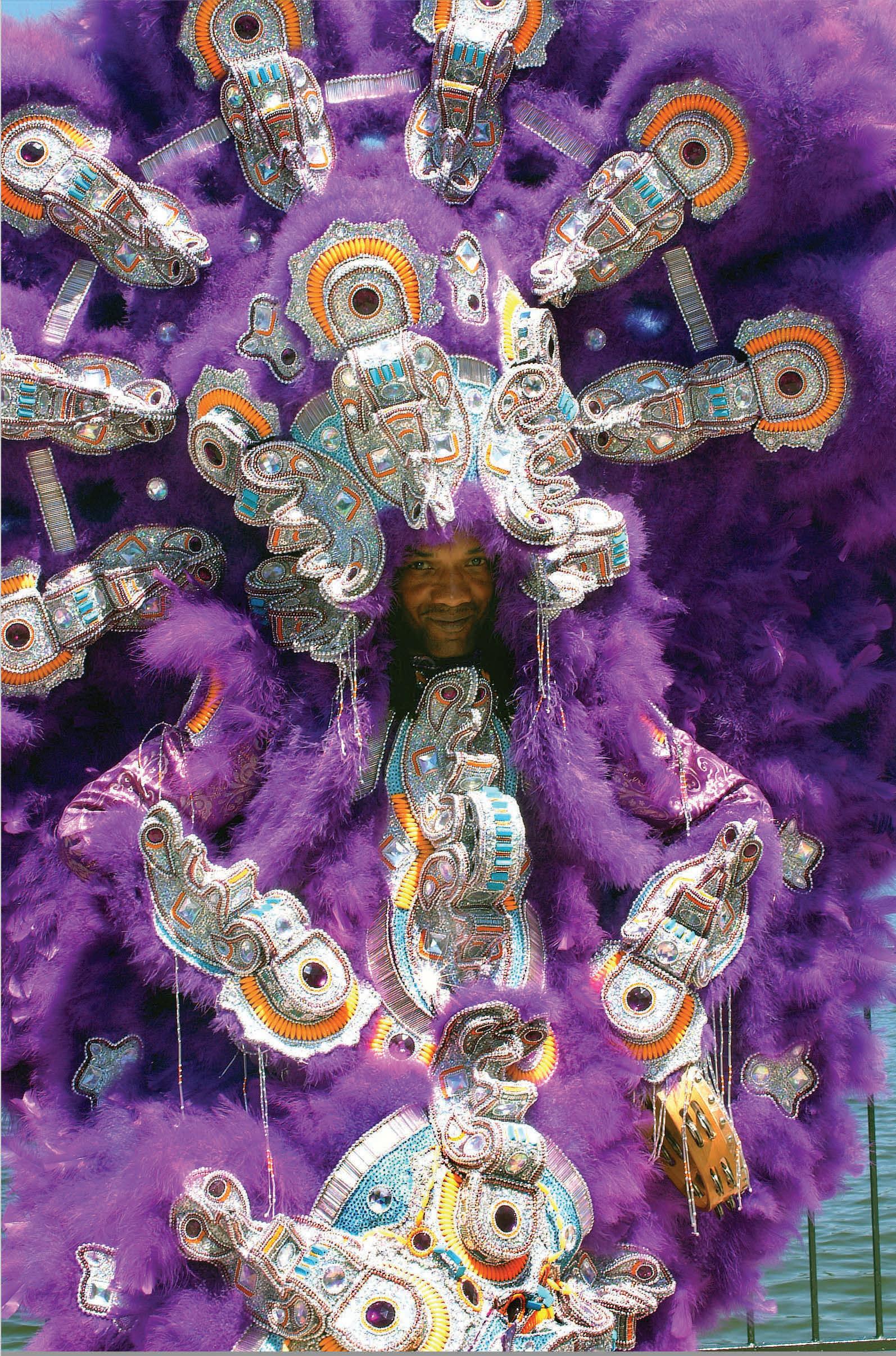
See Darryl Montana honored at a ceremony at the Presbytere in New Orleans on October 13 at 2 pm.
In the fishing communities along the Atchafalaya Basin, one long-adored family tradition has been the great making of a crawfish bisque. A laborsome and meticulous recipe that requires careful stuffing of hundreds of individual crawfish heads, the dish is found much less frequently in the St. Martin Parish communities than it once was—though many residents still treasure memo-
The importance of heritage and legacy have always been tantamount to Cane River, Louisiana couple Nicol and FJ Delphin. In the area, the Delphins are well-known for their deep knowledge of local Creole culture and traditions—ranging from quilting and sewing, to hunting and fishing; to foodways like hog roasts, and the drying of cayenne peppers. Their current project is an effort to restore the 205-year-old John Carroll Jones Plantation Home—which is significant for its Creole architectural design.
See the Delphins honored at the Louisiana Sports Hall of Fame and Northwest Louisiana History Museum on October 21 at 2 pm, where Dr. Shane Rasmussen will interview them about their traditions and work.
A singer/songwriter and storyteller from Edgard, Louisiana—whose debut album My Songs Are My Friends encapsulates a lifetime of listening well and observing closely, beginning beneath the oak trees of his childhood home. He has long been an advocate for emerging songwriters in the region—taking part in events such as the Mississippi Songwriter Festival, the Ozone Songwriter Festival, and the Overbrook Songwriter Festival—as well as co-producing and hosting his own songwriter support project, “Songwriter Sessions,” which features performances, YouTube interviews, and workshops for local artists. He is currently working with the Bayou Arts Council to establish a songwriter festival in Terrebonne Parish.
See Barry Chauvin honored at this year’s Bayou Arts Fest on October 28, on the Voice of the Wetlands Stage at noon.
—Jordan LaHaye Fontenotclassic American and foreign rolling stock to southern Mississippi, transforming its coastal towns into “America’s Largest Block Party” between October 1–8. For automotive enthusiasts, that’s probably enough reason to plan an excursion. But for those looking to add a concours-ready classic to their own garage, there is the Vicari Collector Car Auction, which puts hundreds of highly desirable collector cars under the auctioneer’s hammer at Biloxi’s Mississippi Coliseum & Convention Center, October 4–7.
Vicari explained. “I tell people all the time, ‘Look at the car and come up with a number in your mind. Bid that number, then stop.’ Most of the time, the seller will say, ‘Let it go.’ ”
After twenty-six years of running the Vicari Collector Car Auction, Pete Vicari has seen some extraordinary vehicles change hands, including many younger than the 1982 “vintage” cutoff. “Two years ago I sold a helicopter,” he said. “You like foreign, I like muscle. We don’t discriminate; we’ve got something for everyone.”
You don’t have to be a classic car owner to enjoy Cruisin’ the Coast in Biloxi, but it helps. At the time of writing more than 9,600 classic and collectible, pre-1982 vehicles were registered to take part in this huge annual car show, which has been voted “America’s Best Car Event” by USA Today four times. Visit the Mississippi Gulf Coast in early fall and it’s easy to see why. Thousands of car enthusiasts from all over the country and even overseas bring meticulously-restored examples of
According to show owner Pete Vicari, more than six hundred cars will be auctioned this year, to auto collectors and enthusiasts from sea to shining sea. “It can’t get much larger,” Vicari noted, “because of the size of the building.” Over four days, vehicles as diverse as a 1957 Chevrolet Bel Air, a 2016 Rolls Royce Ghost, a 1965 Ford Thunderbird, and a 1957 Chevrolet school bus will change hands, in a fast-paced, live auction environment that is as exciting for spectators as it is for the bidders themselves. The auction includes vehicles offered with “reserve” and “no reserve” pricing, meaning that sometimes, a bidder drives off in an absolute bargain. “Cars with no reserve are sold regardless of the price,”

So, with six hundred rare and highly desirable rides up for grabs, which vehicle is Pete Vicari most excited to see roll up to the auctioneer’s stand? He points to an especially built 1953 Buick Skylark convertible commissioned by General Motors’ legendary styling chief, Harley Earl. Only 1,690 Skylarks were built in 1953, and this is a rare, surviving example finished in factory white paint with a black-and-white pleated leather interior. “It’s judged one of the best in the country,” Vicari said. He would know because he’s actually sold this vehicle before. “That car was purchased many years ago [during the Vicari Car Auction], he noted.“ “There were two very egotistical drunks bidding on it, and neither would let it go. Eventually it went for $375,000.” How high does he anticipate bidding might go this time around? “It could go for any price,” he said. “You roll the dice when you buy a car. Sometimes you buy it early, and then the price just accelerates.” vicariauction.com
 —James Fox-Smith
—James Fox-Smith
For life’s moments, big and small. We’re here with the strength of the cross, the protection of the shield. The Right Card. The Right Care.

Find
ARTFUL OUTREACH

METHODS OF PHOTOGRAPHY:
TEXTILES BY MOSTAPHA ROMLI & IMAGES OF MOROCCO AT THE SHELL GALLERY

Baton Rouge, Louisiana
Following the devastating earthquake that rocked Morocco on September 8, the Arts Council of Greater Baton Rouge is contributing to support efforts through a new exhibition in the Shell Gallery at the Cary Saurage Community Arts Center and through its Morocco Earthquake Fund via the Creative Relief Program. On exhibit are quilts by Morroccan-born artist Mostapha Romli from the collection of Jacques Bartoli, along with photography by Randy Roussel, Nicole Cudzilo, and Laurie Klein from recent trips to Morocco. artsbr.org. •
MATERIAL HISTORY
NATCHEZ FALL PILGRIMAGE

TOUR OF HOMES
Natchez, Mississippi
The Natchez Pilgrimage Garden Club's spring and fall Pilgrimage Tour of Homes has kept visitors coming back to Natchez since it began in 1932. Today, Natchez's streets remain lined with palatial mansions and filigreed townhouses, and each year the families that occupy them allow guests to nose through two-hundred-year-old homes, meet descendants, hear tales, sip a mint julep, stay in one of more than fifty historic B&Bs, and take in the elegance and history of the Bluff city. Find details on other special events, dinners, and tours at natchezpilgrimage.com. •
UNTIL OCT 22nd
IMPRESSIONS OF SELF

THE SHAPING OF US:
QUEERNESS IN CERAMICS
AT LSU MOA
Baton Rouge, Louisiana
An exhibition at the LSU MOA curated by Andy Shaw, Associate Professor of Ceramics at LSU, explores personal identity, societal expectations, and other issues facing the LGBTQ+ community through the works of ceramic artists Joseph Kraft and Heather Mae Erickson. lsumoa.org. •
OCT 1st
SWEET STUFF
SUGARFEST
Port Allen, Louisiana
The West Baton Rouge Museum's

annual SugarFest is a sweet celebration of the sugar cane harvest. It's a full day of family-oriented activities, live music, and hordes of kids in the throes of a massive sugar rush. This old-fashioned good time sports attractions like a muledriven cane grinder in action, praline making, blacksmithing, woodworking, and other historic craft demonstrations; Louisiana musicians will perform; there will be hands-on activities for the kiddos, sugar-related exhibits inside the museum, wagon rides, and fresh sugar cane to gnaw on. The sweets contest takes the flavor up a notch with homemade sugary cakes, candies, cookies, and cupcakes. Oh, and—naturally—a rum tasting. 11 am–4 pm at the museum. Free. westbatonrougemuseum.com. •
NUN OTHER THAN THE CARMELITES' MASS OF ROSES
Covington, Louisiana
The Carmelites take a vow of poverty— meaning their modest lifestyles and insurance for the convent are largely
supported by donations, and this is their primary fundraising event for the year. Begins at 9 am with the Eucharist, 9:30 am distribution of the blessed roses. covingtoncarmel.org/mass-of-the-roses. •
REMEMBERING
GRAND ISLE CHENIERE
CAMINADA HURRICANE
DAY OF REMEMBRANCE
Grand Isle, Louisiana
130 years ago, the Cheniere Caminada Hurricane of 1893 devastated the islands of Cheniere Caminada and Grand Isle. The town of Grand Isle is holding a day of remembrance to commemorate the anniversary of the "Great October Storm," starting with a prayer service, blessing of tombs, and rededication of the Cheniere Caminada Hurricane Monument at 12:30 pm at Cheniere Cemetery; followed by a blessing and prayer at Grand Isle Cemetery at 1:15 pm; then a memorial service at Our Lady of the Isle Catholic Church at 2 pm; and a reception with food, drinks, and music at Our Lady of the Isle Catholic Church at 3 pm. Free. townofgrandisle.com. •
Baton Rouge, Louisiana
The East Baton Rouge Parish Library is inviting high - an d low-tec h “makers” to its tenth annual Maker Faire, where the "how to" of everything is explored by crafters, quilters, engineers, and more. The year's theme is metal—one of the most common maker materials due to its durability and variability. Enjoy special performances including "headliner" Burt Fleming, chainsaw carver and owner of WoodBCreations, a cosplay competition, eco-friendly and eclectic demonstrations, and more. 10 am–5 pm at the Main Library, 7711 Goodwood Boulevard. ebrpl.com. •
CHAMBER CONCERTS
NEW ORLEANS FRIENDS OF MUSIC CHAMBER SERIES: DANNY DRIVER
New Orleans, Louisiana
The New Orleans Friends of Music kicks off its 2023–2024 Chamber Concert season with a performance by British pianist Danny Driver at Tulane University's Dixon Hall. 7:30 pm. $35; students are free. friendsofmusic.org. •
OCT 4th
VIBRANT AFFAIRS
THE KALEIDOSCOPE GALA
New Orleans, Louisiana
Support the unique and vibrant performances of the Marigny Opera Ballet at this fundraising gala featuring cocktails and light bites, meet-and-greets with the performers, a preview of the season to come, and a performance of dance, music, and circus acts from some of New Orleans's most talented performers. 6 pm. $350 for a single ticket, $750 for a table of two, $1,450 for a table of four. eventbrite.com. •
OCT 4th
TUNES IN THE PARK
THE DESLONDES AT BEAUVOIR PARK
Baton Rouge, Louisiana
The Park's open-air live music features favorites from all over the state. Lawn chairs, quilts, and blankets encouraged—as well as your own booze. Coming up, Federales Fest Presents The Deslondes ft. Esther Rose. 7 pm. $20 at bontempstix.com. •
OCT 4th - OCT 8th
LIVESTOCK & FRIED FOOD
ST. TAMMANY PARISH FAIR
Covington, Louisiana
For over a century the St. Tammany
Parish Fair has showcased the culture, agriculture, music, and food of St. Tammany at the St. Tammany Parish Fairgrounds. Expect all of your small town fair staples: a midway, livestock presentations, exhibitions from Dark Matter Robotics Team, FJK Martial Arts, and more; plus performances by local musicians. There's also a parade, and a rodeo. Free; fees for access to the midway. sttammanyparishfair.info. •
OCT 5th
LOUISIANA LEGACIES FESTIVALS ACADIENS ET CRÉOLES LEGACY SERIES

Lafayette, Louisiana
Festivals Acadiens et Créoles continues its monthly Legacy Series, celebrating legendary local musicians and culture bearers with intimate concerts reminding audiences of their cultural contributions to Acadiana and beyond. Upcoming is "The Legacy of Amédé Ardoin." 7 pm–9 pm. Free. festivalsacadiens.com. •
OCT 5th
GOOD CAUSE ON THE GREEN MAKING A MIRACLE GOLF TOURNAMENT
Abita Springs, Louisiana
Support Miracle League Northshore with Louisiana Medical Management Corporation's annual Making a Miracle
Golf Scramble tournament at Money Hill Golf and Country Club. Registration
7 am, tee off 8 am. $150 individual entry. miracleleaguenorthshore.org. •
OCT 5th
CONTEMPORARY TO CLASSIC AMOA PERFORMING ART
SERIES: DYLAN TRAN
Alexandria, Louisiana
Up next in Alexandria Museum of Art's Performing Arts Series is award-winning musician and multimedia artist Dylan Tran, who will perform a diverse selection from his repertoire including classical compositions, his own indie tunes, and Vietnamese and American folk songs. 6 pm at the Alexandria Amphitheater. themuseum.org. •
OCT 5th - OCT 6th
GOOD OL' DAYS THE CONFERENCE ON THE FRONT PORCH
Taylor, Mississippi
The Conference on the Front Porch started in 2016 with a stated mission of “celebrating the significance of the front porch, both from an architectural as well as a sociological perspective.” The proposed topics are how, when, and why the front porch scenery began to slip away from the American culture. This
year's keynote speakers will be American award-winning folk singer, songwriter, and musician Caroline Herring and United Nations senior official and "most interesting man in the world" Richard Ragan. Additional speakers will include Mississippi Today editor Marshall Ramsey, American History professor Joe Crespino, photographer Maude Schuyler Clay, sports writer Rick Cleveland, journalist and historian Curtis Wilkie, editor and writer Joanna Prichard Morris, blues brothers duo The Deltaz, and photographer and filmmaker David Rae Morris. Held at The Mill at Plein Air in Taylor, Mississippi. Tickets ($485) and information at theconferenceonthefrontporch.com. •
Baton Rouge, Louisiana
Celebrate the Baton Rouge blues with one of the city's biggest musical icons for the annual A Taste of the Deep South Festival. Headlining with his band Flavor and the Listening Room Allstars, Henry Turner, Jr. joins dozens of guest artists at the Riverfront Plaza all weekend long. In addition to the tunes, the festival promises a Vendors' Village, an international food court offering Southern and ethnic foods, and more. Free, from noon–8 pm. There's also the Pre-
Party on Thursday from 8 pm–midnight, held at Henry Turner Jr.'s Listening room. Admission includes a buffet and no-host bar, as well as performances by Henry Turner Jr. & Flavor, some of the Listening Room All Stars, plus members of the Phoenix Rouge and Shakshuka Belly Dance troupes. $25 in advance at bontempstix.com, $30 at the door. •
OCT
JAZZ IT UP CONCERTS AT THE DEW DROP
Mandeville, Louisiana
The historic Dew Drop Jazz & Social Hall, the venerable century-plus-old rural jazz venue, continues to host local jazz greats. Here are the shows coming up:
October 5: Lawrence Sieberth Trio
October 21: Pardon My French 6:30 pm–9 pm. $10. dewdropjazzhall.com. •
OCT 5th - OCT 26th
COMMUNITY CONCERTS
ROCKIN' THE RAILS CONCERTS
Covington, Louisiana
Fall in Covington means it's time for the Rockin' the Rails concert series. Every Thursday night through October, attendees are treated to free live music in historic downtown. In October, catch:







October 5: Whiskey Business.


October 12: Nashville South


October 26: The Boogie Men Free at the Covington Trailhead. 5:30 pm–7:30 pm. covla.com. •
OCT 6th
ART ANTICIPATION
THE PRELUDE: ARTISTS RISING
Lafayette, Louisiana
Hideaway Hall in Lafayette brings a special preview party for this year's Downtown Rising later this month, featuring the work of visual artists Erin Gray, Valerie Hammons, Erin Bennett, and Jean-Marie Guidry—who have all expressed through their work "what downtown means to the artists". There will be live music by Caleb Elliot and DJ Digital Free6ase. 9 pm. $15. socialentertainment.net. •
OCT 6th
MOMENTS ON STAGE INTIMATE APPAREL AT CITÉ DES ARTS
Lafayette, Louisiana


In New York in 1905, invisible barriers keep people seperated: racially, in regards
to religion, as well as social classes. In Intimate Apparel, Esther Mills is an African American seamstress navigating this world with her needle and thread— sewing the finest and most decadent intimate apparel for customers across every social class. Romance tempts her to peek up from the hard work, and the story really begins. See Lynn Nottage's play performed at Cité des Arts this month. 6 pm–9 pm opening night ($30); 7:30 pm Friday and Saturdays; 2 pm Sundays. $20. citedesarts.org. •
CELESTIAL CELEBRATIONS OUT OF THIS WORLD GALA
Baton Rouge, Louisiana
The Louisiana Art & Science Museum's Out of this World Gala will celebrate the Irene W. Pennington Planetarium's twentieth anniversary of bringing celestial beauty and education to Baton Rouge, while raising funds for gallery renovations and other projects. Guests are encouraged to take inspiration for their outfits from the night sky—whether that be in the form of textures and colors, or costumes inspired by astronomy or the
Robert's Cove's annual GermanFest celebration brings traditional German music, German beer, a Kinderland kids' area, and more Deutsch cultural fun to the grounds of St. Leo IV Catholic Church on October 7 & 8. See listing on page 18.


mythological gods and goddesses. Besides food and cocktails, there will be a silent auction and raffle from Lee Michael's Fine Jewelry. Cocktail or costume attire.
7 pm–11 pm. $154.50 for non-members. Raffle tickets are $51.50. lasm.org. •
OCT 6th
FUNNY GIRLS
CUTTING EDGE THEATER PRESENTS BACK TO BARBRA
Slidell, Louisiana
At only sixteen years old, singer and actress Imogen Hebert has honed her craft as a talented tribute artist, particularly when it comes to channeling the vocal chops and presence of Barbra Streisand. She'll bring Streisand's greatest hits from productions like Funny Girl t o life, accompanied by singers Earl Poole and Emily Roy for duets.
8 pm–10:30 pm. Tickets start at $35. cuttingedgetheater.com. •
WEST BANK WEEKEND
GRETNA HERITAGE FESTIVAL
Gretna, Louisiana
Gretna has deigned to celebrate its history not simply with dusty photographs and half-remembered tales, but also with an impressive line-up of internationally famous artists (who probably aren't all from Gretna, but we'll look the other way). This year's headliners include Trombone Shorty & Orleans Avenue, Kool & the Gang, and Lynyrd Skynyrd—along with dozens more. Along with tunes, the festival, encompassing twenty-five city blocks, offers a massive food court featuring dozens of vendors, arts & crafts, rides, and games. Highlights include the Italian, Asian, and Margarita Villages, a Craft Beer tent and German Beer Garden, and a Kids' Corner. $30 per day; $60 for a weekend pass; and various packages to choose from. gretnafest.com. •
PADDLE FASTER
TOUR DU TECHE 135
Port Barre, Louisiana
The Tour du Teche 135 is a three day canoe/kayak/pirogue/SUP adventure race that passes through the parishes of St. Landry, St. Martin, Iberia, and St. Mary. It's a total of 135 miles, the entire length of the Teche. There are two classes: "Pro Race," in which the fastest boats and paddlers from around the world vie for cash prizes; and "Voyageur Race," or recreational, in which participants challenge themselves and each other for trophies, bragging rights, and adventure. $125 to register. tourduteche.com. •
OCT 6th - OCT 8th
DAYS PAST
LA FÊTE DES VIEUX TEMPS: FESTIVAL OF THE OLD TIMES
Raceland, Louisiana
Lafourche Parish's "Festival of the Old Times" brings back the festivities of days past, featuring demonstrations of traditional boat building, an old fashioned boucherie, a sugarcane syrup mill, educational lectures on Cajun culture, and much more. Local artists and crafters will be on site with their wares, along with plenty of local cuisine and live music by Shorts In December, Snapper and the Fish Sticks, and Ryan Foret and Foret Tradition. 4484 Highway 1, under the overpass. facebook.com/lafetedesvieuxtemps. •
OCT 6th & OCT 13th
OUTDOOR MUSIC
MANDEVILLE LIVE!
OCTOBER CONCERTS
Mandeville, Louisiana
Mandeville has planned another stimulating fall season for its live music series. Catch these concerts at the Mandeville Trailhead for free:
October 6: Donald Vappie and the Jazz Serenaders
October 13: Groovy 7

6:30 pm. cityofmandeville.com. •
OCT 6th - OCT 15th
LANDSCAPING
RAY BUUCK RETROSPECTIVE AT THE ABITA SPRINGS
TRAILHEAD MUSEUM
Abita Springs, Louisiana
Some art appreciators have said that Ray Buuck's paintings, "enter straight into your eyes and go directly into your soul." A retrospective of works from across the beloved Abita Springs landscape artist's career will be on display at the Abita Springs Trailhead Museum. An opening reception will take place on October 6 from 6 pm–8 pm. Free. trailheadmuseum.org. •
OCT 6th - NOV 30th
FRESH ARTWORK
POYDRAS CENTER POP-UP
ART EXHIBIT: LANA BERNARD
TONIOLO AND JOE BUSSE
New Roads, Louisiana
New Roads' Julien Poydras Museum and Art Center continues to highlight local art and artists with its series of special Pop-Up Art Exhibits. This month's featured exhibition includes works by local artists Lana Bernard Toniolo and Joe Busse. A meet-theartists reception with refreshments will be held October 6 at 6 pm. Free. pointecoupeehistoricalsociety.com. •
Beginning October 6th - October 7th
OCT 6th - MAR 3rd
BLACK & WHITE PHOTOS IN LIGHT OF EVERYTHING AT NOMA
New Orleans, Louisiana
Louisiana-born photographer Debbie Fleming Caffery is known for her dramatic black-and-white photographs, many of which were taken in France, Mexico, and the American South. For the first time, a retrospective of works from throughout her career will be on display at the New Orleans Museum of Art. noma.org. •
OCT 7th
GALLERY HOPPING
ART FOR ART'S SAKE
New Orleans, Louisiana


10.12 - 10.15 / Farm to Forest Plein Air Festival
This five-day festival will bring artists to central Louisiana to paint “en plein air” - outdoors! themuseum.org

10.20 - 10.21 / Steam Up & Fall Festival Calling all railroad fans!
Join us at the Southern Forest Heritage Museum for this 2-day festival. forestheritagemuseum.org
10.21 / Zoo Boo See all of your favorite zoo animals while you explore the treat trail and enjoy kid-friendly activities. thealexandriazoo.com
10.28 / Van Gogh Gala Join us for an evening of “Haunted Hollywood” with an exciting live auction and unique art. Tickets: riveroaksartscenter.com
10.28 / Trick or Treat at Indian Creek Fun for the entire family with a costume contest, pet parade, food trucks, crafts and more! facebook.com/IndianCreekRecArea
11 + 12 (Select Nights) / Holiday Light Safari Enjoy the Alexandria Zoo at nighttime with thousands of sparkling lights. thealexandriazoo.com
11.30 - 12.2 / Alex Winter Fête Explore arts vendors, live music, ice skating, Santa, food trucks, fireworks, Jolly Junction for the kids, and more! alexriverfete.com
12.8/ Pineville Christmas Parade Come see Santa and floats light up the night in Pineville’s annual Christmas Parade! pineville.net
12.9 / Garden District Tour of Homes Take a peek inside the “crowned jewels” of the historic district. facebook.com/GardenDistrictAlexLA
12.10/ Alexandria Christmas Parade
Catch the FUN at the Alexandria Christmas Parade with floats, marching bands, Santa and more! alexmardigras.net
SCAN ME

WHAT EVENTS ARE GOING ON?
Plan Your Trip: AlexandriaPinevilleLA.com
The Magazine Street Merchants' Association's Art for Art's Sake marks the opening of the city’s arts season, bringing tens of thousands of people. Throughout the Warehouse Arts District (centered on Julia Street), approximately twenty galleries and museums will display exhibits of contemporary art. Alongside the galleries, cash bars and food outposts operate up and down the Julia Street corridor. neworleans.com. •
OCT 7th
CHEERS!
TAPPEDTOBER
Natchitoches, Louisiana
Breweries from across the South are bringing their tastiest craft beers out to the banks of the Cane River along Front Street. Besides the brews, expect the SEC games on the big screen, live music, a tasting pavilion, activities for kids, and more. $31 for presale tickets. 1 pm–10 pm each day. thetappedtober.com. •
OCT 7th
SWAMP STUFF
IBERVILLE SWAMP LIFE EXPO
Grosse Tete, Louisiana
Experience the authenticity of Cajun life in the swamp, mere yards from modern highway transportation. The Iberville Visitors' Center hosts this annual program of hands-on demonstrations and cultural displays, which include crawfish trap making and cypress woodcarving, as the official kick-off to the Atchafalaya National Heritage Area's month-long "Experience Atchafalaya Days" event series. And don't forget the Cajun food, prepared by Atchafalaya locals; and music provided by Travis Matte. 10 am–2 pm.
Just off I-10 at the Grosse Tete exit, 17525 Highway 77. Free. visitiberville.com. •
OCT 7th
MUSIC OUTPOSTS
FEDERALES FEST
Baton Rouge, Louisiana
Billed as "the festival your mama warned you about," Baton Rouge's newest music festival sets out to celebrate the genres of rock-n-roll, country, Americana, and everything in between and beyond. Local and touring acts that will take the stage at Live Oak Arabians this inaugural year include the North Mississippi Allstars, Duane Betts & Palmetto Hotel, The Texas Gentlemen, Neil Werries & Elsah, Hitchhiker, and Thoughts of Mary. A portion of ticket cost goes toward Behind The Line, a nonprofit aiding first responders and their families. Noon–1 pm. $75 day passes at bontempstix.com. federalesfest.com. •
OCT 7th
LOCAL TALENT
THE COVINGTON CONCERT
BAND: STARS SHINING BRIGHT
Covington, Louisiana
The Covington Concert Band welcomes guest artists Brina Bourliea Faciane, Sara Schettler, and Ben Redwine for their fall concert. 7:30 pm at St. Paul's Highschool. Free. visitthenorthshore.com. •
OCT 7th
MEALS ON WHEELS
LOUISIANA FOOD

TRUCK FESTIVAL
Slidell, Louisiana
Head to the Harbor Center to be overwhelmed with tasty options on wheels; plus live music, vendors, and more at this outdoor festival. Doors are open from 11 am–3 pm. Free. harborcenter.org. •
OCT 7th
BARKING GOOD TIMES
UNLEASHED! RESCUE ME GALA
Mandeville, Louisiana
The St. Tammany Humane Society's annual gala will be held at the Pontchartrain Yacht Club, where animal lovers will find a silent auction, cuisine from fine local restaurants, and live music by Four Unplugged—all with a nautical yacht theme, hosted by Fox 8 news reporter Rob Krieger. Proceeds go towards the no-kill shelter

that provides low-cost veterinary care to the community and care for homeless animals. 7 pm–10 pm. $125 in advance, $150 at the door. northshorehumane.org. •
LUCK O' THE IRISH SHAMROCKS & CHAMPAGNE
Baton Rouge, Louisiana
The Baton Rouge Irish Club braces to host a green-tinged brunch at Mansur's on the Boulevard. The Ryan School of Irish Dance, based out of Metairie, will perform; plus there will be Irish music from Kitchen Session. There will also be an auction. Admission is $65; $75 at the door. 10:30 am–1 pm at Mansur's. Email batonrougeirishclub@gmail.com for more information. •
ARTWORK & BEER
BREWS ARTS FESTIVAL
Hammond, Louisiana
Definitely designate a driver for the Hammond Regional Arts Center's annual Brews Arts Fest. Attendees will enjoy a thirty-strong selection that includes plenty of locally crafted beers, paired with cuisine prepared by area chefs. Plus, live music alongside artwork by regional artists. In Morrison Alley parking lot off North Cypress Street (behind the Arts Center at 217 East Thomas Street). 4 pm–8 pm. $35 in advance; $40 at the door; $60 for VIP. hammondarts.org. •
PROST!
OLDE TOWNE OKTOBERFEST

Slidell, Louisiana
The return of autumn brings a German twist to Olde Towne Slidell for its annual Oktoberfest celebration, featuring traditional music, cuisine, and beer. Expect performances in German dance by The Dance Project, and games for all ages. 4 pm–9 pm. $12; $5 for ages twelve to twenty; children under eleven are admitted free. oldtowneslidell.com. •
OLDE TOWNE
PUMPKIN FESTIVAL
Slidell, Louisiana
Face painting and pumpkins are the mark of any good fall gathering, and the Olde Towne Pumpkin Fest is no exception. At the First United Methodist Church, kids can carve and decorate a pumpkin, get their cheeks bedaubed, explore a fire truck and SWAT vehicle, or dig into a pile of hay. All proceeds will benefit East St. Tammany Rainbow Child Care
Center. 10 am–4 pm. Free, with some ticketed events ranging from $1–$5. louisiananorthshore.com. •
Franklin, Louisiana
Celebrate the anniversary of the film Easy Rider —whose characters drove from California to Louisiana—in downtown Franklin. This annual festival will feature live music by Johnny Chauvin & Chris Ibert, Laine Hardy, and the MJ Dardar Band; a vendor market, and black pot cook-off. Plus, a screening of the film at the historic Teche Theatre for the Performing Arts (1 pm). Riders are also encouraged to follow the Easy Rider route from Franklin to Amelia. 9 am–6 pm. Free. Visit Bikers on the Bayou on Facebook for more information. •
OCT 7th
BLUESY ENTERTAINMENT
BLUESBERRY FESTIVAL
Covington, Louisiana
Get deep into your bluest blues for this celebration of blues music and the arts at Bogue Falaya Park. This full-day immersive arts experience will feature both national and regional musical talent all day long on the Westaff Music Stage, an arts tent, an Abita Beer Garden with a variety of locally crafted brews, a food truck roundup, a children's village, and more. The lineup includes performances by The Band of Heathens, John Finch, The Reminding, Gabriel Bass, Paul Faith, and more. 9 am–9 pm. $30, $40 at the gate; free for children ages ten and younger. thebluesberryfest.com. •
OCT 7th
FALL FESTIVITIES
ANTIQUE VILLAGE
FALL FESTIVAL
Denham Springs, Louisiana
More than two decades in the making, Denham Springs' Antique Village Fall Festival is one of the largest continually-run festivals in Livingston Parish. Today, more than 150 vendors will crowd into the antique district bringing the best in crafts, antiques, and art. Stroll down Mattie Street, or “Art Avenue,” and hear live music at the Old Train Depot Stage. A costume contest, live music, and plenty of festival food ensure something for everyone. 9 am–4:30 pm. Free. denhamspringsantiquedistrict.com. •
OCT 7th
OPERATIC EVENINGS
NEW ORLEANS OPERA ASSOCIATION 2023 BALL
New Orleans, Louisiana
The Women's Guild of the New Orleans
Beginning October 7th - October 11th
Opera Association is throwing another grand party in the name of opera—this year, with a Tennessee Williams-inspired theme of "A Streetcar Named Desire".
The evening kicks off with a Patron Party featuring the soulful music of Anaïs St. John at Rosie's on the Roof at 6 pm, followed by the big event at 7 pm at the Higgins Hotel's Arcadia Ballroom. The main affair will include a seated dinner, party music by the BRW Band, and silent and live auctions hosted by Marshall Harris. Black tie preferred. $250 general admission, $350 for a patron ticket. neworleansopera.org. •
OCT 7th
TREASURE HUNTS
BREAUX BRIDGE CITY WIDE
GARAGE SALE
Breaux Bridge, Louisiana
In this case, city wide really means city wide; while the main campus of the event will be in downtown Breaux Bridge, every road and street heading into town will have residents selling some of their old-but-good treasures. Past years have seen over ten thousand participants. 7 am–3 pm. For details, visit the "Breaux Bridge City Wide Garage Sale” on Facebook. •
OCT 7th - OCT 8th
AG-TIVITIES
HARVEST DAYS
Baton Rouge, Louisiana
Harvest Days at the LSU Rural Life Museum is an opportunity to understand what life on the farm would have looked, sounded, and felt like in nineteenthcentury rural Louisiana. Living history demonstrations will include plowing, blacksmithing, soap and candle making, timber framing, open hearth cooking, sheep herding, and boat making as well as period music and dancing.
8 am–5 pm on the grounds of the LSU Rural Life Museum. Regular admission prices apply. lsu.edu/rurallife. •
OCT 7th - OCT 8th
GERMANY IN LOUISIANA ROBERT'S COVE GERMANFEST
Rayne, Louisiana
Held on the grounds of St. Leo IV Catholic Church, the Roberts Cove Germanfest offers live entertainment, authentic German food, a large selection of German beer on tap, folklore demonstrations, and a Kinderland (kiddie
area)—just a few of the attractions scheduled for this year's festival. $8; free for children younger than thirteen. robertscovegermanfest.com. •
OCT 8th
SONGWRITER SETS
LEE BARBER AT TEMPLE SINAI
Saint Francisville, Louisiana
New Orleans songwriter Lee Barber will play a set with a full band including Brian Beattie, Tim Lee, and Bruce Golden at Temple Sinai. 6:30 pm. $20. bontempstix.com •
OCT 8th
LEVEE'L UP FEAST ON THE LEVEE
Brusly, Louisiana
St. John the Baptist Catholic Church of Brusly invites the community for a day of music, activities, and food on the banks of the Mississippi River for Feast on the Levee. Besides activities like bingo, corn hole, and a bounce house for the kids, there will be a 50/50 raffle and silent auction. Cajun favorites like jambalaya and beignets will be served, with a barbecue cook-off to round out the occasion. There will also be live music sets by Origin Story, Cajun Fire, John Foster Music, and Rhodes, Maurer & Bourgeois Band, with special guests Gaylen Martin
and Kenny Altazan. Mass 10 am, festival 11 am–7 pm. sjb-brusly.com. •
LIT LECTURES
AUTHOR TALK SERIES AT THE EAST BATON ROUGE PARISH LIBRARIES
Baton Rouge, Louisiana
The East Baton Rouge Parish Library is carrying on its Author Talk virtual series, connecting bestselling authors with their readers through interactive, live online Q&A sessions.
October 10: Guidebook author and TV host Rick Steves shares travel tips. 3 pm.
October 18: Ruth Ware, author of The Woman in Cabin 10 and The It Girl, 1 pm.
October 26: John Irving, author of The Last Chairlift. 6 pm. ebrpl.com. •
OCT 11th
POTTER PRIDE PRIDE POTS PROJECT
Baton Rouge, Louisiana
In celebration of National Coming Out Day, queer ceramicist and founder of Pride Pots: Community Conversations Heather Mae Erickson and the LSU MOA invite students and members of the community to create their own

For Holly Hollis, spring 2018 was shaping up to be the best ever. At 34, the Ruston, Louisiana, native’s career as an attorney and Director of Human Resources at Baton Rouge-based MMR Group was blossoming. She and her fiancé, Mark Stars, were looking forward to a fall wedding and planning their shared future together. Then, one morning in a doctor’s office, everything changed.

During an annual appointment, Holly’s doctor discovered a lump in her breast. Two weeks later, the results of a biopsy confirmed her doctor’s suspicions: Holly was diagnosed with Stage IV, metastatic triple negative breast cancer (TNBC), meaning that her cancer had spread beyond the breast and nearby lymph nodes. Statistically accounting for only 10%–15% of breast cancers, TNBC tends to spread faster than other types of breast cancers, and is difficult to treat. Faced with a life-changing diagnosis and limited treatment options, Holly and Mark elected not to wait until the following November for their wedding. A week after her diagnosis, they were married in a small, intimate ceremony, surrounded by close family and friends. “She was unlike anyone I ever met,” says Holly’s husband, Mark Stars. “Beautiful, strong-willed, kind-hearted. Every day, I am thankful she was a part of my life.”
During the four years that followed, Holly battled her cancer tirelessly. Her journey, which she chronicled on her blog “The Stars Align” from the time of her diagnosis until her death in April 2022, touched the lives of thousands.
Holly was not only a fierce fighter, but also an inspiration to all who had the privilege of crossing her path. Friends and colleagues described her as a person with an unquenchable zest for life, who became fast friends with those around her, including her surgical oncologist Mindy Bowie, M.D.
The resolve with which Holly approached her treatment took many forms. Determined not to lose her hair while undergoing chemotherapy at the Woman’s Cancer Pavilion in partnership with Woman’s Hospital, Mary Bird Perkins and Our Lady of the Lake Cancer Institute, Holly employed cold cap therapy, wearing a special headpiece filled with a refrigerant to cool the scalp and reduce hair loss. From her hair, to her career, Holly brought optimism and determination to every opportunity, friendship and challenge. “She just had a ‘no-quit, never-give-up, never surrender’ attitude,” says Jeramiah Blum, her friend and a Vice President at MMR Group. “She did everything 100%. It was inspiring to be her colleague and, most of all, her friend.”
Tragically, after a four-year battle with breast cancer, Holly’s journey came to an end in April 2022. But her spirit lives on. To honor Holly’s memory, her friends and family created the Holly Hollis Stars Endowment Fund——a permanent endowment established within Mary Bird Perkins Cancer Foundation to support cancer prevention and education efforts throughout Louisiana and Southwest Mississippi in perpetuity.
MMR Group, a corporate partner of Mary Bird Perkins, is the anchor donor for the fund. “Holly was an inspiration to all,” says Amber Leach, a friend and coworker at MMR. “We want to help honor her life and her legacy.”
Since 2018, MMR has supported Mary Bird Perkins’ cancer education and early detection efforts by participating in the Prevention on the Go Workplace Program, which deploys a mobile medical clinic to bring cancer screenings and educational programs to company employees on-site. Through philanthropic contributions, MMR also supports Mary Bird Perkins by underwriting programs that deliver cancer education and detection to communities through Louisiana and Mississippi—an effort that was particularly near to Holly Stars’ heart.

“When Mary Bird Perkins hosted mobile cancer screenings at MMR, Holly was the first in line and would encourage others to take advantage of life saving services,” Mark says. “She felt a responsibility to educate and share with others so that they wouldn’t have to go through what she was going through. It gave her a strong sense of purpose, fueled her faith, and helped her make sense of the diagnosis.”
In commemoration of Holly’s 40th heavenly birthday, her family invites the countless individuals whose lives she touched to join the Holly Hollis Stars Endowment Fund, helping to ensure that her passion for educating others on the importance of early detection and prevention, would live on.
Those interested in honoring Holly’s legacy by supporting her fund and donating to the Holly Hollis Stars Endowment Fund, point your phone camera at the QR code on the right.
Breast cancer took Holly Stars too soon. But with the establishment of the Holly Hollis Stars Endowment Fund, this Baton Rouge advocate’s passion for cancer education and early detection services lives on. marybirdfoundation.org



Beginning October 11th - October 13th
"Pride Pot," which will be put on display alongside the other ceramics in the exhibition The Shaping of Us. 11 am–1:30 pm at the LSU Student Union Free Speech Plaza; 3:30 pm–5:30 pm at the the Shaw Center for the Arts plaza. Free. lsumoa.org. •
OCT 11th
JAZZ IN CONCERT
RIVER CITY JAZZ MASTERS
Baton Rouge, Louisiana
The Arts Council of Greater Baton Rouge's annual series attracting some of the world's most talented jazz artists welcomes The Headhunters to the Manship Theatre stage. 7:30 pm. $28–$48. artsbr.org/rcjm. •
OCT 11th - DEC 4th
WOMEN MAKE THEIR MARK ASSOCIATED WOMEN IN THE ARTS EXHIBITION
Baton Rouge, Louisiana
The talented women who make up the Associated Women in the Arts are hosting their annual member exhibition at the Louisiana State Archives, which is juried
this year by Patrick Saunders, an awardwinning, globe-trotting artist who is a Master Signature member of the Oil Painters of American and a signature Member of the Portrait Society of America. An opening reception featuring live music, commentary from the artists, and light refreshments will be held from 6 pm–8 pm on October 19. Free. associatedwomeninthearts.com. •
OCT 12th
DELICACIES A WILD NIGHT
Baton Rouge, Louisiana
The Louisiana Wildlife and Fisheries Foundation's annual fundraiser at Live Oak Arabians will feature "A Taste of Louisiana" from a variety of local restaurants and caterers, live and silent auctions, and more. 6 pm. $100. lawff.org. •
OCT 12th
GOOD EATS
2023 CHEFS TO WATCH DINNER
Covington, Louisiana
Louisiana Cookin' is bringing half a dozen
of the Bayou State's most exciting chefs to the Southern Hotel, where they will prepare a six-course meal showcasing their skills as well as the delicious bounty of the area. Jackets are required for men. $175. 6:30 pm–9:30 pm. louisianacookin.com. •
OCT 12th
NOLA SONGSTRESS SAMANTHA FISH AT THE MANSHIP
Baton Rouge, Louisiana
New Orleans-based singer-songfwriter
Samantha Fish will be joined by Jesse Dayton for a performance at the Manship Theatre. 7:30 pm. $55–$65. manshiptheatre.org. •
OCT 12th
COME TOGETHER
DOWNTOWN RISING 2023
Lafayette, Louisiana
Downtown Lafayette is on the rise, it's plain to see. Local organizers have harnessed that energy into an exciting community event—Downtown Rising. Join the town in toasting to the vibrancy and the growth of cultural center that is Lafayette, made all the more exciting by performances from Boogie T and the Boogie T.Rio, Iceman Special, The Debtors, and DJs Digital, Inzy, Free6ase,
@lovebenoir, and lil_art_hoe. 5 pm–10 pm. $20; $30 for Front Stage; $75 VIP. socialentertainment.net. •
OCT 12th
EMERALD ISLES
SEÁN HEELY CELTIC BAND
Covington, Louisiana
You'll be transported to the Scottish Highlands and Emerald Isles when the Seán Heely Celtic Band plays at Fuhrmann Auditorium. U.S National Scottish fiddle champion and Gaelic singer Seán Heely will be accompanied by acclaimed multi-instrumentalist and All-Ireland singing champion Kevin Elam, plus bouzouki and bass player Beth Patterson, percussionist Lucas Ashby, and percussive dancer Agi Kovacs. 7 pm. $25, free for students. bontempstix.com. •
OCT 12th - OCT 14th
SOME LIKE IT HOT
ZWOLLE TAMALE FIESTA
Zwolle, Louisiana
For three days, the Zwolle Tamale Fiesta celebrates the Spanish and Native American heritage of the town's residents with arts & crafts, dancing, a car show, a trail ride, children's activities, parades, and—oh, yes—tamales. Cultures collide in an effort to cook up the most delicious tamale—whether competing or simply
eating, everyone wins. zwolletamalefiesta.com for a schedule and directions to the Zwolle Fairgrounds. •
SHRIMPLY AMAZING
NATIONAL SHRIMP FESTIVAL
Gulf Shores, Alabama
For fifty years, Gulf Shores on the second weekend of October has been the place to be for the annual Shrimp Festival. And you can see why: Two stages of entertainment, a children's village, vendors for fine art and crafts, competitions for restaurants, singing, and sand castles, and shrimp for days. myshrimpfest.com. •
CANVASING THE TOWN FARM TO FOREST
PLEIN AIR FESTIVAL
Alexandria, Louisiana
Artists will scatter throughout the heart of Alexandria, capturing en plein air its stunning natural environs. The Alexandria Museum of Art invites painters from all over the country to participate in a series of arts-focused events interspersed with the most valuable gift of all: time and space to paint. Additional events include gallery tours at the AMoA, a quick-paint challenge, a farm-to-table dinner at the museum, a workshop with artist juror John P. Lasater, IV, ArtWalk, and more. All juried artists' work from the week will be displayed at the Palette Party event on Sunday at 4 pm, when the winners will also be announced. All art sales will be split with a seventy percent commission going towards the artist and thirty percent going to the Alexandria Museum of Art. Non-juried artists and the public are also invited to participate in certain events including the Quick Paint Challenge at Inglewood Farms on Thursday (included for juried artists; $20 for non-juried artists), the John P. Lasater workshop Saturday ($200), the plated dinner at the AMOA on Thursday ($30) and the Final Sale and Awards Ceremony on Sunday. farmtoforestpleinair.com. •
PLANTING SEEDS MASTER GARDENER
The East Baton Rouge Master Gardeners Association partners with the East Baton Rouge Parish Libraries to offer free educational talks and workshops on various gardening topics.
October 12: Cheri Fasy & Other Master Gardeners; 5:30 pm at Central Library.
October 26: Leo Broders on Hydrangeas and Bob Dillemuth on Camellias; 6:30 pm at Greenwell Springs Library. Free. ebrmg.wildapricot.org. •
Explore Louisiana's oldest settlement like never before, through a progressive journey presented by the Association for the Preservation of Historic Natchitoches. The event will start out with a cruise along the picturesque Cane River on "The Delta Queen" Riverboat with Captain Paul Powell— who will take you to three of the city's most historically-significant properties. The first is Lemee House—best known for being the home of Ouiser Boudreaux in the 1989 film Steel Magnolias , which celebrates 35 years since its filming here in Natchitoches. Onsite, enjoy a "Blush & Bashful" beverage, bleeding armadillo cake, and photo ops with iconic characters. Next, peruse the collection of rare Clementine Hunter paintings on view at the historic Cunningham Law Office on Second Street, and learn about the iconic artist from experts while enjoying a "Clementine" beverage and other treats. Finally, enter the architectural gem that is the Jefferson Street Townhouse, featuring an expansive front veranda filled with antiques and fine décor. In the parlor, learn about Victorian Natchitoches, and its days as a river port. The event will end with a Wine & Cheese reception around the pool. 6 pm–8:30 pm. $40. melroseplantation.org. •
Patterson, Louisiana
Enjoy a weekend camping in beautiful Kemper Williams Park complete with a craft show, car show, chili cook-off, kid's zone, live music, kid and adult costume contests, and more—all to benefit the good cause of the Mary Bird Perkins Cancer Center. campingforacure.org. •
NOLA

FRIENDS OF THE CABILDO CONCERT: MARCIA BALL
New Orleans, Louisiana
The Friends of the Cabildo are hosting an intimate concert with New Orleans singer Marcia Ball at the Jazz Museum's thirdfloor performance center listening room. 7 pm–9 pm. $65. nolajazzmuseum.org. •
OCT 13th
INDULGENT EVENINGS
OXTOBERFEST'S BEER & BITES RESTAURANT CRAWL


Covington, Louisiana
In a town known for its history of community gatherings on every block, it's only fitting that a festival of beer should bear the name of Covington's public squares (ox lots). This year, Oxtoberfest presents a Beer & Bites Restaurant Crawl through historic downtown Covington, featuring small plate and beer pairings from local restaurants. The event begins at the Trailhead, and directs you to the participating venues. 6 pm–9 pm. $100. Details at oxtoberfest.org. •

OCT 13th - OCT 15th
FALL FESTIVALS
CRESCENT CITY
BLUES & BBQ FESTIVAL
New Orleans, Louisiana
Powered by the New Orleans Jazz & Heritage Foundation, the Crescent City Blues & BBQ Festival celebrates Southern soul with legendary local and international blues and R&B talent,

plus the greatest assemblage of homestyle barbecue to be found within the city limits. Come for performances by Samantha Fish, Tab Benoit, Shemekia Copeland, Little Freddie King, Selwyn Birchwood, Johnny Sansone, The Roadmasters, Trudy Lynn, John Mooney & Bluesiana, and D.K. Harrell. Free. At Lafayette Square Park. 5:30 pm–8:30 pm Friday; 11 am–8:30 pm Saturday and Sunday. jazzandheritage.org. •
ROUX-GAROUS LOUISIANA GUMBO FESTIVAL
Chackbay, Louisiana
The small Cajun community of Chackbay continues to earn its title (proclaimed by Edwin Edwards himself) as "Gumbo Capital of Louisiana" while celebrating its annual festival, which cooks up over five hundred gallons of gumbo over the course of a weekend. Organizers promise the best in Cajun food, music, and dancing along with a carnival midway, live auction, parade, and raffle. Musical acts include Snapper
and the Fishsticks, Kings of Neon, Ryan Foret and Foret Tradition, JP Bourgeois, plus plenty more. 6:30 pm–midnight Friday; noon–10 pm Saturday; noon pm–6 pm Sunday. Free. lagumbofest.com. •
FALL FESTIVALS FESTIVALS ACADIENS ET CRÉOLES
Lafayette, Louisiana
Festivals Acadiens et Créoles is returning to pay tribute to the music, food, and arts passed down since the arrival of the Acadian pioneers 250 years ago— this year with a particular emphasis on Lafayette Parish's own bicentennial. Non-stop cultural immersion includes the Bayou Food Festival, Louisiana Crafts Fair, workshops, cooking demonstrations, the Tour des Atakapas 5k, 10k, or duathlon, and a French Mass. There will also be multiple stages of live music, featuring beloved Louisiana musicians including Corey Ledet Zydeco's tribute to Clifton Chenier, The Daiquiri Queens, Steve Riley & the Mamou Playboys, Jourdan Thibodeaux et les Rodailleurs, Bonsoir, Catin; Feufollet, and many many more. 5 pm–8:30 pm Friday, 10:30 am–8 pm Saturday, 10:30 am–7:30 pm Sunday. Free. festivalsacadiens.com. •
OCT 13th - OCT 15th
CAST IRON & SPICE
BRIDGE CITY GUMBO FESTIVAL Bridge City, Louisiana
Word is that the gumbo in Bridge City is "world famous"—a confident claim if I ever heard one in this land of brewed roux (made by Governor Edwin Edwards, no less). There's only one way to find out if the rumors are true. Head over to the festival grounds for over two thousand gallons (well, you've got to share) of both seafood and chicken/sausage gumbo. Also amusement rides, games, activities, pageants, and live music. A variety of other Louisiana cooking such as jambalaya, red beans and rice with sausage, as well as hamburgers, hot dogs, onion mums, homemade cakes and candies, funnel cakes, and many delicious surprises will also be available. 6 pm–11 pm Friday; 10 am–11 pm Saturday; 10 am–9 pm Sunday. $5 per day; $12 weekend pass. bridgecitygumbofestival.org. •
OCT 13th -
FALL FESTIVALS
ST. AUGUSTINE
CREOLE FESTIVAL
Natchitoches, Louisiana

Celebrate all the bounty of Louisiana's Creole culture with the rich Creole community in Natchitoches at St.
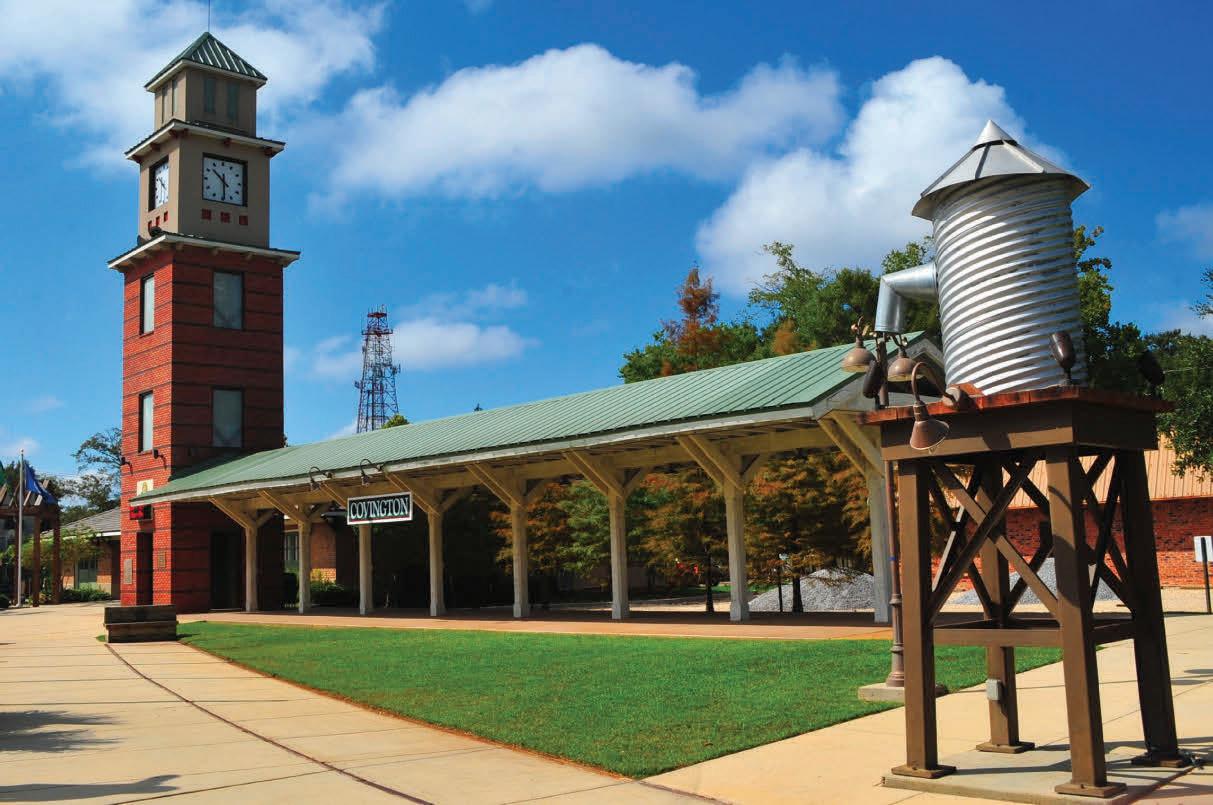
Augustine's Catholic Church in the form of Creole cuisine, games, music, storytelling, and more fun. 10 am–10 pm. natchitochesla.gov. •
OCT 13th - OCT 15th
FINDERS KEEPERS
ANTIQUE FAIR & YARD SALE
Washington, Louisiana
Come to historic Washington for a chance to browse the wares of over two hundred vendors at this enormous Antique Fair & Yard Sale at the historic, circa-1934 Old Schoolhouse Antique Mall—all 40,000 square feet of it. Expect plenty of food and fun, but perhaps more importantly, great bargains on a wide variety of decorative tidbits for house, home, office, yard, or anywhere. 9 am–5 pm each day. oldschoolhouseantiquemall.com. •
OCT 13th & OCT 20th
MIDDAY MUSIC
BACH LUNCH
Lafayette, Louisiana
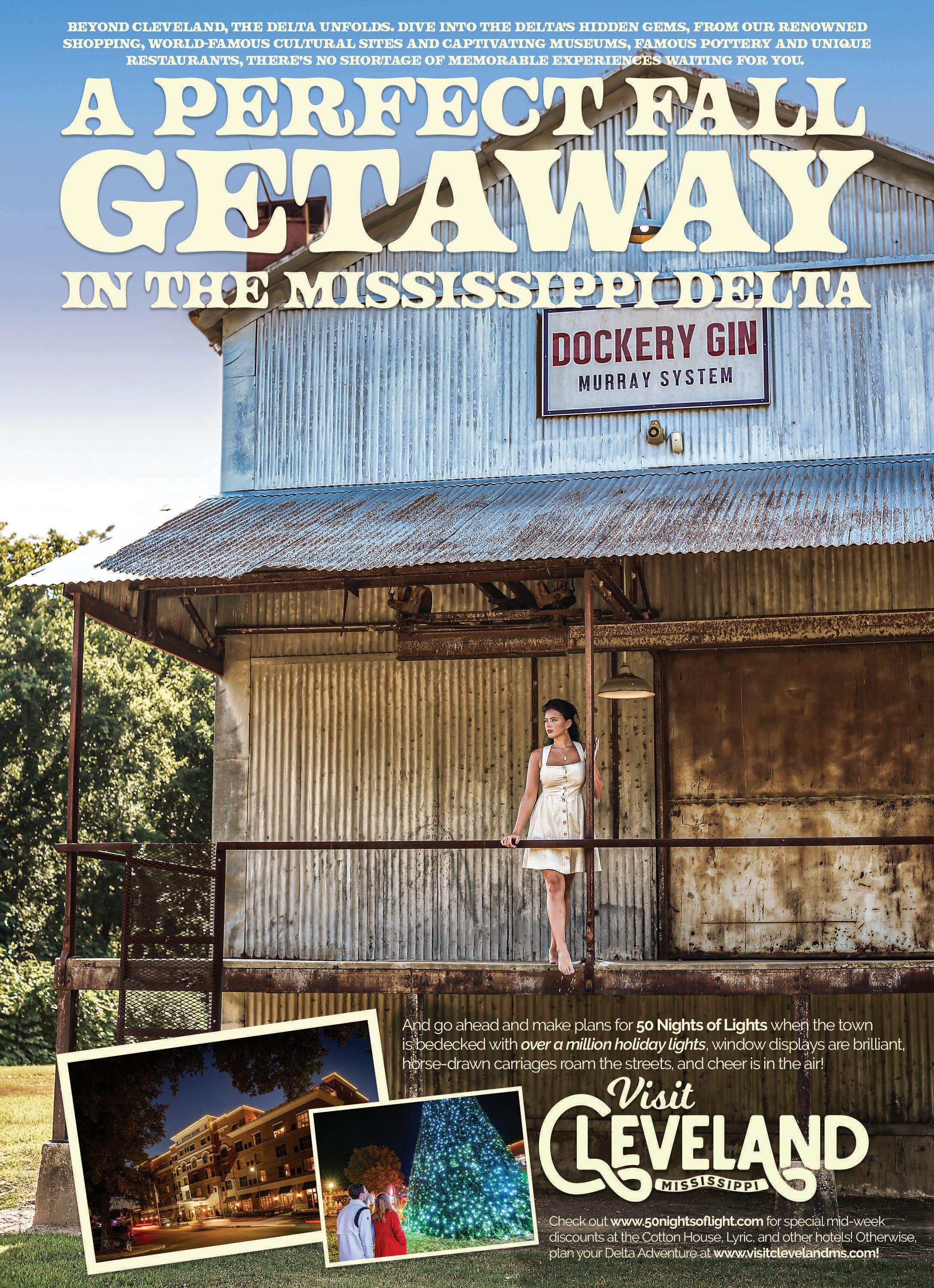
Presented by the Lafayette Science Museum Foundation, Bach Lunch is a concert series taking place on Fridays during the spring and fall seasons so that participants can enjoy a meal and live music in an open-air venue. Guests are invited to bring their own lunch, or they can purchase a meal from participating restaurants around the square. All proceeds benefit the museum and help fund future exhibitions and educational programs. Here's what you can look forward to:
October 13: Michael Juan Nunez + Eric Adcock
October 20: Major Handy and the Louisiana Blues Band, featuring Sharona Thomas
Noon–1 pm. Downtown Lafayette at Parc Sans Souci at the corner of Polk, Congress, and Vermilion streets. lafayettetravel.com. •
OCT 13th - OCT 22nd
CHAPERONES
DRIVING MISS DAISY AT BAY ST. LOUIS LITTLE THEATRE
Bay Saint Louis, Mississippi
Driving Miss Daisy, Alfred Uhry's classic play, is a funny but hopeful meditation on growing old, relationships, and loyalty; having won the Pulitzer Prize in 1988. Set against the backdrop of the Civil Rights era, the play tells the story of Miss Daisy and her newly hired chauffeur Hoke. Their relationship, spanning twenty-five years, is a reflection of critical changes in American society, as they deal with anti-semitism, racism, and class differences while their bond grows ever stronger. Performed at the Bay St.
Louis Little Theatre. Performances at 8 pm Fridays; 2 pm and 8 pm Saturdays; 2 pm Sundays. $25; $10 for children; $18 for seniors, students, and military. bontempstix.com. •
TGIF
LIVE AFTER FIVE CONCERT SERIES
Baton Rouge, Louisiana
When the clock strikes five on Fridays, downtown Baton Rouge trades business for live bands, beverages, and afterwork boogying during the Live After Five Concert Series. 5 pm–8 pm each
Friday at Rhorer Plaza Free.
October 13: D.K. Harrell October 20: New Breed Brass Band
October 27: After 8 liveafterfive.downtownbr.org. •
Baton Rouge, Louisiana
Performance artist Molly Jo Shea has recently moved from Los Angeles to the South, and is embracing and observing her new surroundings by recreating a
Bass Pro Shop in the style of a Halloween haunted house at Yes We Cannibal. In Shea's Bass Ghost Shop, the taxidermied animals on the walls come alive to tell their stories about overlooking the shop and their forest pasts, in what amounts to a commentary on the commodification of human's communion with nature, toxic masculinity, and more. A Halloween Party and Performance will take place on October 28 from 6 pm–10 pm— attendees are encouraged to dress as a hunter or taxidermied animal. Performance by Cooter the Opossum and Night Janitor will take place at 7 pm. yeswecannibal.org. •




OCT 14th
BAYOU BASH

WILD THINGS FESTIVAL
Lacombe, Louisiana
Wild enough at any time of year, the 110-acre Bayou Lacombe Center in Lacombe becomes particularly so each October, when the U.S. Fish and Wildlife Service and The Friends of Louisiana
Wildlife Refuges present the annual Wild Things festival. More than forty guest organizations and individuals come to share nature and conservation-themed displays, presentations, and hands-on activities in celebration of National Wildlife Refuge Week. Children can build a birdhouse, learn how to canoe, see live animals, fish for prizes in the casting pond, take a pontoon boat ride on the Bayou, enjoy a variety of exhibits and hands-on activities, see Louisiana native animals, and more. The whole idea is to provide opportunities for guests to connect with nature, wildlife, and the things that make south Louisiana special. 10 am–4 pm at the Bayou Lacombe Center, which is the headquarters of the Southeast Louisiana Refuge Complex. Free. fws.gov. •
OCT 14th
AUTUMNAL ACTION ANGELS GROVE
FAMILY FALL FEST

Bush, Louisiana
Created for families to embrace nature along with the autumn season, Angel Grove's Family Fall Fest brings horseback rides, hayrides, cake walks, mask designing, monster building, fall photo opportunities, and more. Proceeds benefit Angel Grove's mission of caring for rescued animals. 10 am–3 pm. $10. angelsgrove.org. •
OCT 14th
REMEMBERING HISTORY
LOUISIANA ORPHAN TRAIN ANNUAL GATHERING


Opelousas, Louisiana
Ensuring that the little-known story of the two thousand parentless children who rode the train from New York to Louisiana between 1873 and 1929 is not forgotten, the Louisiana Orphan Train Society holds an annual reunion at their museum in Opelousas. Hundreds of the thousands of Orphan Train riders and
their descendants gather each year at one of only two museums in the United States dedicated to their history. Guests are invited to join in on the storytelling and the lineage tracing, and to explore the museum. Light refreshments will be provided, along with door prizes and raffle items. 10 am–2 pm. Free. laorphantrainmuseum.com. •
OCT 14th
COUNTRY STARS
CHRIS STAPLETON AT THE CAJUNDOME
Lafayette, Louisiana
Chris Stapleton's All American Road Show is rolling in, hitching up at the Cajundome for a night with the country phenom. Stapleton's debut album, Traveller (2015), was certified double platinum, and he's received Country Music Awards and Grammys in its wake. 7 pm. $54.25–$154.25. cajundome.com. •
OCT 14th
FOLKIN' AROUND LOUISIANA ART AND FOLK FESTIVAL
Columbia, Louisiana
Back for its 66th year, the Louisiana Art and Folk Festival—the longest-running art festival in the state—welcomes everyone to experience regional art,



a car show, a petting zoo, folklife demonstrations, live music, amazing food, and so much more on historic Columbia's Main Street. This year's lineup includes Reigh Clare Music, Owens Music Ministry, Hannah Bass, the Mike McKenzie Band, and the McClanahan's. 10 am–4 pm. Free. Details at the Louisiana Art and Folk Festival Facebook Page. •
OCT 14th
LADIES OF THE HOUSE WOMEN OF OAKLEY TOUR
Saint Francisville, Louisiana
A special tour curated by Audubon Oakley House State Historic Site Interpretive Ranger Michaela Brown traces the lives of five women to live on the property where Audubon once painted his Birds of America —from Silvia Freeman, who was born into slavery in 1855 and remained a cook at Oakley even after she was freed in her youth; to Audubon's pupil Eliza Pirrie. $10 adults, $8 seniors, $6 students. lastateparks.com. •
OCT 14th
AUTUMN ARTISTRY FALL FOR ART
Covington, Louisiana
Each autumn for over twenty years,


www.abitafallfest.com







downtown Covington comes to colorful life for its annual Fall for Art, an arts and culture extravaganza organized by the St. Tammany Arts Association that spills creative goodness the length and breadth of the historic downtown district. There's live music indoors and out, hundreds of booths featuring unique original artwork, art receptions, sidewalk art, boutique shopping, family-friendly activities, and restaurants eager to get you fed and back on the streets. 6 pm–9 pm. Free. visitthenorthshore.com. •
ZA'ATAR & CEDAR
LEBANESE FESTIVAL
Baton Rouge, Louisiana
A new festival coming to Baton Rouge celebrates Lebanese culture in the Capitol City with savory and sweet Lebanese treats, music, dancing, and other activities. The festival is presented by St. Sharbel Maronite Catholic Church of Baton Rouge at Serop's Café on Corporate. seropscafe.com. •
BLOCK PARTIES
PATTERSON MAIN STREET FESTIVAL
Patterson, Louisiana
Patterson welcomes fall each year with its annual Main Street Festival, which features crafts, food, drinks, and live music. Noon–10:30 pm. Free. cajuncoast.com. •
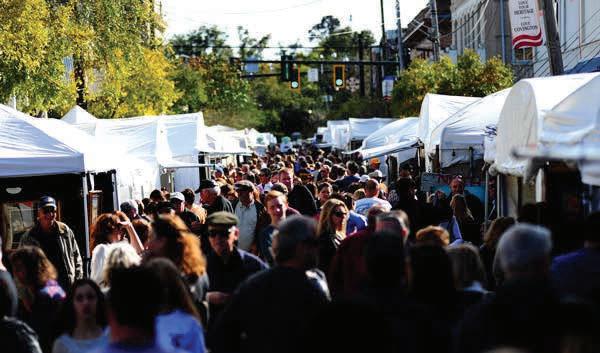
CARRIBEAN CELEBRATIONS
DOMINICAN NOLA FEST
New Orleans, Louisiana
For the first time, New Orleans will have a festival dedicated entirely to the vibrant and rich Dominican culture that weaves through the city. Hosted by the New Orleans Jazz Museum alongside local musician Fermin Ceballos and the Dominican Consulate, Dominican NOLA Fest will feature workshops and programming about Dominican culture from noon–4:30 pm, followed by a Dominican Gala from 6 pm–9:30 pm. Admission to the Gala is $50, which includes food and one cocktail, with access to the cash bar. nolajazzmuseum.org. •
VINYARD SHOWS
JAZZ'N THE VINES
Bush, Louisiana
Wild Bush Farm + Vineyards' longrunning outdoor concert series brings celebrated Louisiana musicians to a gorgeous pastoral setting. Entertaining assembled picnickers this month is Flow Tribe. 6:30 pm–9 pm at 81250 Highway 1082. Gates open at 5 pm. Bring a picnic blanket, lawn chairs, and bug spray. Wine from Wild Bush Farm + Vineyards and various foods will be available for sale from local vendors. $12 admission at bontempstix.com. wildbushfarmandvineyard.com. •
POLLINATOR PARTY
GARDEN DISCOVERIES:
“ENJOYING BUTTERFLIES OF BATON ROUGE”
Baton Rouge, Louisiana
Foundation's Garden Discoveries series, and is free to attend. 10 am. ebrpl.com.
OCT 14th
ART AND OAKS SHADOWS ARTS & CRAFTS FAIR
New Iberia, Louisiana
Among the giant oaks on the winding banks of the Teche, attendees at this twice-annual arts & crafts fair can pick up one-of-a-kind items from over one hundred vendors from around the state. And of course there will be plenty of food, drink, and dessert. 9 am–5 pm. $5 per person ($3 for children ages six to seventeen; under six get in free). shadowsontheteche.org. •

OCT 14th
SWEET STUFF
OLD ARABI SUGAR FESTIVAL
Arabi, Louisiana
Sweet-tooths from miles around converge on the grounds of the historic neighborhood of Old Arabi, in the land of sugar giant Domino, for the annual Old Arabi Sugar Fest. Competition will focus on the sugary delights of cakes, cookies and pies. Crafts, activities for the kiddos, a donut eating contest, and more confections than you can shake a cotton A R T F E S T
Master Naturalist and avid nature photographer Dennis Demcheck will lead a presentation at the Main Library at Goodwood about the most common butterflies found around Baton Rouge, enlightening participants as to how to identify and attract them in their own yards. The presentation is part of the Baton Rouge Botanic Garden
candy stick at make this a pretty sweet event. Noon–9 pm at the Aycock Barn. oldarabi.org/sugarfest. •
OCT 14th - OCT 15th
KNICK KNACKS
ST. TAMMANY COLLECTORS CONVENTON

Mandeville, Louisiana

If you have an epic collection, are working on one, or aspire to have one: this convention is for you. Over one hundred tables and booths packed with action figures, comics, toys, video games, local art, and so much more will fill the Castine Center for your perusal. Also catch a costume/cosplay contest, photo opportunities, and charity events. 10:30 am–5 pm Saturday; 11 am–4 pm Sunday. $10; kids younger than twelve free. sttammanycollectorscon.com. •
OCT 14th - OCT 15th
ROUX ROYALTY WORLD CHAMPIONSHIP
GUMBO COOKOFF
New Iberia, Louisiana
Can anyone's gumbo be better than ya mama's? A few upstarts in Iberia Parish may think so at this annual World Championship Gumbo Cook-off, held in Bouligny Plaza. The Greater Iberia Chamber of Commerce will host the festivities, which will feature music, family fun, and plenty of food; marking the return of the "Wizard of Roux". Saturday will be the 5K Roux Run,
followed by the Creole Food Fest (where everything except gumbo will be served), and the Meanest Beans Cook-off. Sunday is the big day, where over seventy-five teams will compete for the honor of World's Best Gumbo. iberiachamber.org/ gumbocookoff. •
WOODEN BOAT FESTIVAL
Madisonville, Louisiana
From pirogues to classic Chris-Crafts, there's just something so appealing about wooden boats. And in Louisiana, there's no place they look better en masse than abroad on the placid waters of the Tchefuncte River. As the major fundraiser for the Lake Pontchartrain Basin Maritime Museum, the Wooden Boat Festival in Madisonville attracts gorgeous examples; just ask one of the thousands of attendees who've been flocking to this celebration for a quarter century. In addition to upwards of one hundred boats—from pirogues to seventy-five-foot cruisers and trawlers— the fest features a main stage with live bands throughout Saturday and Sunday, with performances by Bottoms Up, Chase Tyler Band, Monster Crawfish, SugarBomb, and Remnant 23—plus a Saints tailgate hosted by The Blenderz. Don't miss the return of the Quick 'n Dirty Boat Building Contest and Parade. Gates open at 10 am on Saturday and Sunday, with entertainment till dusk, all along the banks of the
Beginning October 14th - October 20th
Tchefuncte River in Madisonville. $10. maritimemuseumlouisiana.org/wbf. •
OCT 14th - OCT 15th
TREATS & TOURS
MELROSE FALL FESTIVAL
Natchitoches, Louisiana
Hundreds of vendors from across Louisiana will bring their finest goods out to the grounds of Melrose, which was built in 1796 by freedman Louis Metoyer and was later the home of esteemed artist Clementine Hunter. Gifts (for yourself or others) such as baked goods, home décor, jams, artwork, and more will be available for perusal and purchase. 9 am–5 pm Saturday, 10 pm–3 pm Sunday. $5 adults, $2 children ages 6–12. melroseplantation.org. •
OCT 14th - OCT 22nd
PAST COMES ALIVE
ST. LANDRY CEMETERY TOURS & HISTORICAL REENACTMENTS
Opelousas, Louisiana
Watch the spirits of St. Landry come alive and tell their stories while learning history in a fun, spooktacular way at the
St. Landry Catholic Church cemetery. Joining the "spirited" celebration will be a variety of historical characters relating to the area, including Jim Bowie, an Alamo figure; Madame Baldwin, a businesswoman of color; Reverend CB Anderson, first ordained Catholic priest from Opelousas; and Reverend Hyland, the first pastor of Holy Ghost Catholic Church. Several other spirits will also be brought to life for patrons to enjoy their legends. All proceeds will help to fund the Cemetery Historical Restoration Project, which takes special efforts to restore local gravesites. Saturday tours take place at 6 pm, 6:30 pm, 7 pm, 7:30 pm, and 8 pm; Sunday tours take place at 2 pm and 3 pm. Handicapped accessible tours will be available. These tours are not suitable for children under ten years of age. $10. (337) 942-6552. •
INTRIGUING HISTORY HISTORY & MYSTERY OF NEW HAMPSHIRE STREET
Covington, Louisiana
Learn about the lore surrounding
Covington's North New Hampshire Street in an informative historic tour exploring the Southern Hotel, the Star Theatre, the Old Courthouse, and Saint Tammany Farmer. 5 pm –7 pm. $5 at bontempstix.com. covingtonheritagefoundation.com. •
OCT 15th
ATHLETIC ACADIANA TOUR DES ATAKAPAS
Lafayette, Louisiana
Presented by T.R.A.I.L. and Festivals Acadiens et Créoles, the annual Tour des Atakapas kicks off the festival weekend with a morning run or paddle through Lafayette, followed by a post-run fete at the festival's Mon Heritage stage. Options for participants include a a 5K, a 10K, and a duathlon—which consists of a 1.5 mile run, 2 mile paddle, and 1.5 mile run. Things get started at 7:45 am. $35 for run; $25 for duathlon. latrail.org. •
OCT 17th
ROOFTOP ORCHESTRAS
SYMPHONY IN THE SKY: TOTALLY AWESOME '80S
Lafayette, Louisiana
Jukebox heros, material girls, karma chameleons, and thrill seekers in the danger zone—the Acadiana Symphony Orchestra and Conservatory of Music
have got something special for you. Starting off with cocktails, food, selfie opps, and DJ tunes—the night will reach its peak with a stunning performance by the Symphony and guest artists Julie Williams, Sharona Thomas, Sarah Russo, Myles Migl, and Ray Boudreaux, performing the '80's greatest hits. All this in the distinct open air environs of the Vermilion Street Parking Garage rooftop. 5:30 pm. Duet tickets (2 tickets) are $225. acadianasymphony.org. •
OCT 18th
PUPPETEERING CONNECTIONS
LITTLE AMAL'S JOURNEY:

ALLONS JOUER Á LAFAYETTE
Lafayette, Louisiana
Little Amal, a twelve-foot puppet of a ten-year-old Syrian refugee, has traveled to thirteen countries and made over 1 million friends, plus tens of millions more online. Walking across the globe, she celebrates the art, hope, and humanity evident in our communities while raising awareness for the needs of refugees, immigrants, and asylum seekers—and the rich cultures they bring with them. Amal will follow music, dance, and Louisiana folklore through the streets of downtown Lafayette—all culminating at Parc International to celebrate Lafayette's Bicentennial. Contributions by Acadiana
With a convenient drive-thru, your family will love everything about Lane’s new retail pharmacy. Our outstanding pharmacists are here to serve you and will do all that they can to help you with your medication needs. From answering your questions, to helping you better understand your medications, to getting you in and out as quickly as possible, Lane Rx is a great choice for all your pharmaceutical needs. So tell your doctor, your pharmacy is Lane Rx.
Symphony Youth Orchestra, Acadiana
Talent Youth Actors Troupe, Brandon Broussard, Coco Tribe of Canneci
Tinne, Corey Ledet, Fire expressions Performing Arts Conservatory, Riley Family Band, Soul Express Brass Band, and The Magnolia Sisters will bring even more vibrancy to the day. 6 pm. Free. festivalinternational.org/littleamal. •
GRAINS OF GLORY
RICE FESTIVAL

Crowley, Louisiana
Where would jambalaya, etouffée, and gumbo be without this all-powerful ingredient? Rice is essential to dishes the world over, so head to Crowley to pay homage to the tiny grain that gets around. Festival-goers are treated to rice cooking and eating contests, the Grand Parade, arts & crafts, fiddling competitions, a frog derby, a rice poker run, a classic car show, and more over the course of this huge happening. The live music lineup includes Chris Ardoin, Wayne Toups, Spank the Monkey, Three Thirty Seven, Louisiana Red, and Jamie Bergeron. Free; but the carnival will cost you. All details can be found at ricefestival.com. •
CHURCH MUSIC
MUSIC AT MID CITY BALLROOM
Baton Rouge, Louisiana
Catch the following shows coming up at Baton Rouge's indie, BYOB venue, Mid City Ballroom:
October 19: Southpaw FLHC, Escuela Grind, Decoy and Ventruss. 7 pm. $12.
October 29: Fred Masherino, The Color Fred, and Ex-Taking Back Sunday. 7 pm. $15. bontempstix.com. •
Natchez, Mississippi
The city of Natchez makes a picturesque historic backdrop for balloonatics from all around the country during the annual hot-air balloon festival, when balloonists will fly above the high bluffs and Mississippi River. The Balloon Glow and fireworks show are always well-received, as is a lineup of bands that this year includes Sister Hazel, Bag of Donuts, the Suffers, a Fleetwood Mac tribute, and many more. The festival also includes a Sports Tent showing all the weekend's big games on big-screen TVs. Children's activities, carnival rides, and a variety of regional foods are always around, so it's up, up, and away you go to Natchez this weekend. $35 weekend pass for adults ($45 at the gate), or $15 on Friday, $30
Saturday if purchased in advance, $35 day-of. Children ages ten and younger are free. After morning balloon flights lifting off throughout the area at 7:30 am each day, the festival kicks off at 4 pm Friday, 11 am start on Saturday—all on the grounds of the Rosalie Mansion. natchezballoonfestival.com. •
PLANTING SEEDS THE SOUTHERN GARDEN SYMPOSIUM
Saint Francisville, Louisiana
Presenting renowned gardening experts and a wide array of panels, few gardening
programs combine esteemed speakers and historic settings in quite the way that the Southern Garden Symposium does. In the spirit of celebrating the long-standing tradition of elegant gardens in the Deep South, experts will lead workshops and lectures interspersed with social events and garden tours that celebrate classic Southern hospitality and gardening at its best. Among the featured speakers this year is Rebecca McMackin, who has served for over a decade as the director of the Brooklyn Bridge Park; as well as luxury floral designer Margaret Ludwig. Tickets to Friday's workshops are $100; Tickets to Friday evening's Speakers' Gala
are $80; Saturday's Symposium is $100. southerngardensymposium.org. •
Abita Springs, Louisiana
Abita Springs brings in the season with its annual fall festival, featuring two stages, with a lineup that includes Christian Serpas & Ghost Town, Imagination Movers, Tyler Farr, Juggler, and Lost Bayou Ramblers. There will also be food and drink vendors, a Kid Zone, green screen photo station, and an arts and crafts market. 5 pm–9 pm Friday,
Enjoy an oasis in the heart of the city. Stroll through the beautiful gardens and walk the many trails of the LSU AgCenter Botanic Gardens and Windrush Gardens. Step back in time to 19th century rural Louisiana at the open-air LSU Rural Life Museum.
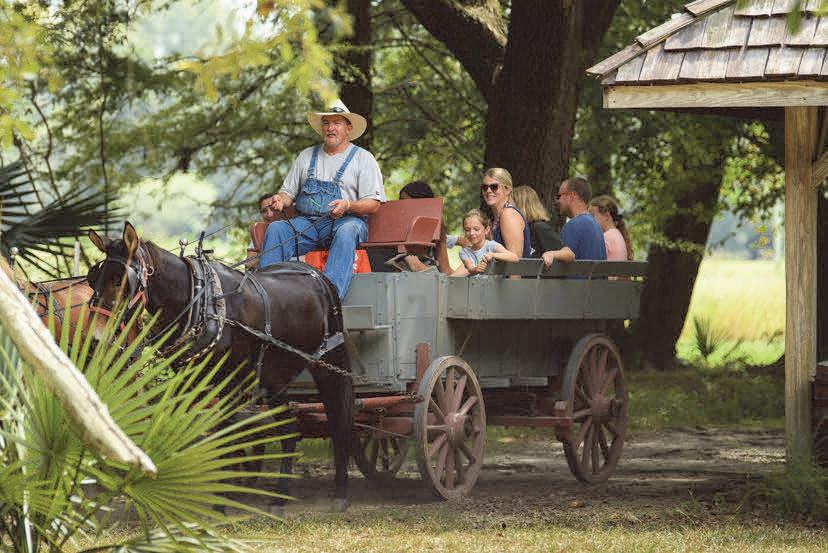
StoryTime in the Garden
October 14, November 4 and December 2 9 a.m.-Noon
LSU AgCenter Botanic Gardens (Pavilion)
Birding at Burden*
October 21, November 11 and December 9 7-9 a.m.
LSU AgCenter Botanic Gardens
Harvest Days*
October 7 and 8 8 a.m.-5 p.m.
LSU Rural Life Museum
Corn Maze at Burden*

Every Saturday in October and Sunday, October 8 9 a.m.-4:30 p.m.
LSU AgCenter Botanic Gardens
Night Maze & Bonfire*
October 28 6-9 p.m.
LSU AgCenter Botanic Gardens
Haints, Haunts and Halloween*
October 29 2-4:30 p.m.
LSU Rural Life Museum
Wine & Roses Rambler*

November 5 2-4 p.m.
LSU AgCenter Botanic Gardens
Red Rooster Bash*
November 16 6:30 p.m.
LSU Rural LIfe Museum
Poinsettia Sale & Show
December 2 9 a.m-Noon
LSU AgCenter Botanic Gardens
A Rural LIfe Christmas*

December 3 10 a.m.-5 p.m.
LSU Rural LIfe Museum

10 am–7 pm Saturday. $20 Friday; $25 Saturday. abitafallfest.com. •
OCT 20th - OCT 22nd
I LIKE BIG BOOKS
FRIENDS OF JEFFERSON PUBLIC LIBRARY BIG BOOK SALE
Kenner, Louisiana
The Friends of the Jefferson Public Library's semi-annual book sale return to fill the Pontchartrain Center this month. Over sixty-five thousand used books will be up for grabs, including cookbooks, travel books, art books, history books, and local and regional titles. DVDs, CDs, puzzles, sheet music, audio books, and more on sale, too. Most items priced between fifty cents and three dollars. 10 am–7 pm Friday–Saturday; noon–5 pm Sunday. 4545 Williams Boulevard. Free admission and parking. friendsofjeffersonlibrary.org. •
OCT 20th - OCT 22nd
FUN FINDS
VIDALIA RIVERFRONT CARNIVAL AND FLEA MARKET
Vidalia, Louisiana
Down by the riverside, the Vidalia
Landing Riverfront on the Mississippi River makes a picturesque spot to admire the offerings of the river town's huge annual fall flea market. More than one hundred vendors swarm in each October to be part of one of the biggest open air markets in the region. Gates open on Friday at noon, at 8 am Saturday, and 9 am on Sunday. Food vendors offer regional treats, and carnival rides entertain as well. Free. vidaliaconventioncenter.com. •
FUNKY STUFF
NOLA FUNK FEST
New Orleans, Louisiana
NOLA Funk Fest is the designated "coming-out party" for the The Louisiana Music & Heritage Experience, a museum in the works that intends to showcase Louisiana's extensive music history on a grand scale. To celebrate the occasion, there will be two stages bumping sets by twenty-one of New Orleans's funkiest artists, plus delicious food and beverages. Headlining acts include Leo Nocentelli with Experiencing The Meters, plus Irma Thomas, George Porter Jr., and The Dirty
Dozen Brass Band. 3 pm–10 pm each day. $45 per day in advance, $100 for a threeday pass in advance. olafunkfest.com. •
It's a whole-hog, hot air kinda weekend when the Sorrento Lions Club brings Boucherie Festival to the Ascension Hot Air Balloon Festival. If pigs were ever going to fly, it'll happen here. The menu includes jambalaya, hogshead cheese, cracklins, boudin and boudin balls, roast pork, and chicken and andouille gumbo— and those balloons can only carry so much weight. 9690 Airline Highway in Sorrento, featuring all the traditional trappings of the Boucherie Fest, plus hot air balloon glows, live entertainment, fireworks, carnival rides, and more. 5 pm–10:30 pm Friday; noon–11 pm Saturday; noon–6 pm Sunday. Admission by donation. boucheriefestival.com. •
LITERATI LIVINGSTON PARISH BOOK FESTIVAL

Livingston, Louisiana
There'll be lots of literature-themed
activities, games, and refreshments at the main branch of the Livingston Parish Library during this annual celebration of literature. And this year, the library is excited to announce that authors Sarah Guillory and Ellen Byron will be featured, with musician and author Eric Litwin headlining. Also on the roster are storytelling appearances, a petting zoo, a Mystery Machine replica, book giveaways, virtual reality experiences, kids' activities, and crafts for all ages. An authors' alley promises plenty of local authors showing off their latest and greatest works. And a full schedule of author talks and music, of course. 11 am–4 pm. Free. mylpl.info/ bookfestival. •
ARTFUL OUTINGS
PERKINS ROWE ARTS FESTIVAL
Baton Rouge, Louisiana
Perkins Rowe and the Arts Council of Greater Baton Rouge will again partner to bring Baton Rouge the Annual Arts Festival. The Baton Rouge Arts Market will bring with it fine arts from local, regional, and national artists. There will be live music performances throughout the weekend, and all retail stores and restaurants will be open during regular hours. Free. 9 am–8 pm. perkinsrowe.com or artsbr.org. •
OCT 21st
BR ROADSHOW
ATTIC TREASURES & COLLECTIBLES
Baton Rouge, Louisiana
If you're ready to learn the true value of Great Aunt Ada's Victorian garden gnome collection, bring them to the East Baton Rouge Parish Main Library, when local and regional collection specialists will identify and evaluate prized family treasures. Scour your attic or storage room and bring dolls, jewelry, porcelain, glass, pottery, beads, fine china, memorabilia, furniture, books, farm equipment, and more to have it assessed by trained pros. Free and open to the public, but limit your haul to three items. 9 am–1 pm. ebrpl.com. •
OCT 21st
SMALL TOWN SHOWS
ABITA SPRINGS OPRY
Abita Springs, Louisiana
The Abita Springs Opry is devoted to preserving Louisiana's indigenous music. Arrive early (around 5 pm-ish) and join the folks who've made a ritual of enjoying gumbo, hot dogs, and homemade pastries, not to mention the pre-show sound checks and front porch concerts. This month, the lineup includes Three Rivers Coopperative, Lynn Drury, The Oliviers, and The Porch Rockers. 7 pm–9 pm. $20. abitaopry.org. •
OCT 21st
CHEERS TO BEERS
GULF BREW
Lafayette, Louisiana
Gulf Brew is back with over two hundred Louisiana breweries and brewpubs to showcase their newest craft beers along with live music stages, craft booths, and more coming together for the outdoor festival along Jefferson Street in downtown Lafayette. 1 pm–5 pm Saturday. General admission $40; Brewmeister $100; Designated Driver $10. acadianacenterforthearts.org. •
OCT 21st
WILD GAME SQUIRREL COOK-OFF
Krotz Springs, Louisiana
Find out just how tasty squirrel can be when a slew of wild game chefs try their hands (and their cast irons) at cooking up the tastiest squirrel dish. 6 pm. $20 entry. For more information, call (337) 331-2349. •
OCT 21st
GOT THE MEATS ORIGINAL BOUDIN COOKOFF AND ACADIANA BACON FESTIVAL
Lafayette, Louisiana
So how do you like your boudin? Blanc,
noir, crawfish, gator, balled up, or on bread? The Boudin Cook-Off promises boudin samples created by the region's top boudin makers, a People's Choice award, and a boudin-eating contest wherein participants will make stuffed sausages of themselves. But if that isn't enough pork to set you over, it gets even better—once again, the Boudin Cook-off is partnering with the Acadiana Bacon Festival in a pairing more greasy and delicious than we've dared to imagine thus far. Alongside the boudining, local restaurants and home cooks from across Acadiana will come together to show off bacon in all its glorious iterations—and you can be sure that the smells of Parc International will have the whole town drooling. Live music, games, face painting, free ice cream sandwiches, and fun jumps too. 10 am–4 pm. Free. boudincookoff.com. •
OCT 21st
RESTORING HISTORY
RRAAM ROSENWALD SCHOOL OPEN HOUSE
Donaldsonville, Louisiana
The River Road African American Museum has completed restoration on one of Louisiana's 400 former Rosenwald Schools, which were initially built as a result of America's first publicprivate partnership between Booker
T. Washington and Julius Rosenwald. Learn more about this history as well as the RRAAM's new genealogy database at an open house. 1 pm–5 pm. Free. Find the event on Facebook for more information. •
OCT 21st
BAYOU BASH
SHAKE YOUR TRAIL FEATHER PADDLE PARADE
Breaux Bridge, Louisiana
The TECHE Project is excited to host the twelfth-annual Shake Your Trail Feather Festival to celebrate the Bayou Teche National Paddle Trail. The day will include a Paddle Parade down Bayou Teche featuring live music by local Cajun musicians playing on decorated barges. Land at the Party in the Parc, with live musical entertainment by Corey Ledet & his Zydeco Band, food, and libations at Parc des Pont. Parade starts at 10 am at Poche's Country Club; party from noon–2 pm. techeproject.org. •
OCT 21st
ART MARKETS
HANDMADE HARVEST ARTS AND CRAFTS
Mandeville, Louisiana
Peruse locally-made, hand-crafted items from jewelry to food and beyond—and
“From routine checkups to immunizations, my goal is to help kids stay as healthy as possible and be their advocate.

When kids are sick, I want them to feel comfortable coming to the office and getting the care they need.”
At Lane Pediatrics, our team is experienced in caring for newborns, toddlers, children and teens. From wellness checks and immunizations, to diagnosing and treating childhood illnesses including the sudden onset of viral or bacterial infections, we provide high quality care your children need and deserve. You can trust Lane Pediatrics to make their future healthier!

Lane Pediatrics is here to help you with the most important job in life – raising your children.

let the little ones get their faces painted with something spooky or cute for free, while you're at it. 9 am–4 pm. Free. Find the event on Facebook for more information. •
OCT 21st
GOOD EATS
TAILGATING COOK-OFF
Loreauville, Louisiana
Grab a taste of Louisiana with this Cajun tailgating cook-off in Loreauville Park. From the food, the fun jump, the cornhole tournament, fais-do-dos, kids games, arts and crafts, refreshments and more—there is no better way to spend a Saturday than surrounded by family and friends. Free. 9 am–10 pm. Details at the Tailgating Cook-Off Facebook Page. •
OCT 21st
NIGHT AT THE MUSEUM
O WHAT A NIGHT! GALA
New Orleans, Louisiana
You'll be quoting the name of the event before the end of the evening: "O what a night!" Certainly an apt response to
a gala that features the finest of New Orleans cuisine, silent and live auctions featuring art from noted Southern artists. Cuban-American painter Luis Cruz Azaceta will receive the annual Opus Award. Proceeds from the gala go towards the Ogden Museum's mission to showcase the diversity and importance of Southern art through exhibitions and education initiatives.
6 pm–midnight. Tickets start at $600. On October 19 , there will be a Patron Party and auction preview. ogdenmuseum.org. •
OCT 21st
DIGGING DEEPER A DAY OF ARCHAEOLOGY AT OAKLEY HOUSE
Saint Francisville, Louisiana
Explore the ways archeology can use buried artifacts to tell us about the past, shedding light on day-to-day life and giving a voice to those who have previously been silenced. An archeologist will guide participants through a recreated dig modeled after the actual archeological excavation of
the slave cabin on Oakley's property. 10 am–3 pm. $5 grounds fee. Call (225) 635-3739 for more information. •
OCT 21st
SMALL TOWN FESTS
SLAUGHTER FALL FESTIVAL
Slaughter, Louisiana
The Slaughter Civic Club is gearing up for the Slaughter Fall Festival, which will be complete with all the favorite components of a Southern festival: live music, vendors slinging tasty food and other crafts and products, a silent auction, games and activities for kids, and more. Proceeds from the festival will fund a variety of community projects. 10 am–3 pm at the Town of Slaughter's Health Walk. Free. Register at eventbrite.com. •
OCT 22nd
IMPACTFUL HISTORY
BLACK HERITAGE ROOM
LECTURE: GARNER VS. LOUISIANA
Baton Rouge, Louisiana
Joan Garner, daughter of John Burrell Garner, will present a talk about her father's role in the fight for civil rights in Louisiana, particularly in relation to the landmark case Garner vs. Louisiana. 3 pm. Free. ebrpl.com. •
BENEATH THE BALCONIES
New Iberia, Louisiana
At this annual celebration of the arts, theatrical performances will unfold from New Iberia's venerated downtown balconies. Visitors can experience drama, comedy, and music while strolling down Main Street from Shadows-on-the-Teche to the Steamboat Warehouse Pavilion. Delicious food, signature drinks, and toe-tapping music will be featured at the Shadows-on-the-Teche starting at lunchtime, so bring a lawnchair and settle in. The procession from one balcony to the next begins at the Shadows Front Gallery at 2 pm. Free. Noon–5 pm. lafayettetravel.com. •
TRADITIONS 101
BLACKPOT CAMP
Eunice, Louisiana
The organizers behind the Black Pot Festival return with their "How to be Cajun" school at Lakeview Park & Beach this fall. Organized by a sort of who's-who in Acadiana cultural circles, the camp features music classes in Cajun fiddle, accordion, guitar, old-time banjo, fiddle, swing jazz, and songwriting. There's instruction during


Beginning October 24h - October 26th

the day, and performances every night (don't worry, there are dance classes, too). Attendees will also get in the kitchen, learning all the basics of Cajun cookin' from some of the region's most esteemed chefs. And the whole week slides right into Blackpot Festival, held at Vermilionville just down the road in Lafayette. One of the many beauties of this event is that you can come and go as your schedule allows; register for the whole shebang and overnight it (via tent or RV), or sign up for a single day. There are also opportunities for work trade to help curb the cost. blackpotcamp.com. •
OCT 24th
LIVE MUSIC
LOBBY LOUNGE CONCERT: LAURIE ANNE ARMOUR
Slidell, Louisiana
Singer songwriter Laurie Anne Armour is performing an intimate concert at the Lobby Lounge in the Harbor Center as part of Slidell's Lobby Lounge Concert Series. 7 pm, doors at 6:30 pm. $20–$100. harborcenter.org. •
OCT 24th - DEC 31st
LOCAL LEGENDS
HONORING OUR OWN: DR. CHARLES SMITH AT THE SHELL GALLERY
Baton Rouge, Louisiana
Dr. Charles Smith has had a storied life and career as a minister, Marine, historian, social worker, activist, and speaker. He is also highly regarded for his expressive figural sculptures depicting the African American experience, which earned him the prestigious Visionary Award from Intuit: The Center for Intuitive & Outsider Art this June. A display of his sculptures will be up for viewing at the Cary Saurage Community Arts Center's Shell Gallery. artsbr.org. •
OCT 26th
MAGICAL ORCHESTRAS

HARRY POTTER IN CONCERT WITH ACADIANA SYMPHONY ORCHESTRA
Lafayette, Louisiana
Relive the original film that defined generations, made more magical by the accompaniment by the Acadiana Symphony Orchestra, who will perform John Williams's

iconic score for a night of unparalleled enchantment. 7 pm at the Heymann Performing Arts Center. Tickets start at $61. acadianasymphony.org. •
OCT 26th
TOASTS WITH GHOSTS SPIRITS OF LOUISIANA

Baton Rouge, Louisiana
The halls of the Old State Capitol will
take on some boozy top notes when it hosts Louisiana distilleries for its annual Spirits of Louisiana event. Guests will sample various liquors made at in-state distilleries and craft cocktails, with catered food, and live music. Dress is roaring '20s/Prohibition Era, so channel your inner Gatsby or Daisy and toast to Louisiana distillers. All proceeds from Spirits of Louisiana go directly to support the museum’s mission. Twenty-one

and older only. 6:30 pm–9:30 pm. $85. louisianaoldstatecapitol.org. •
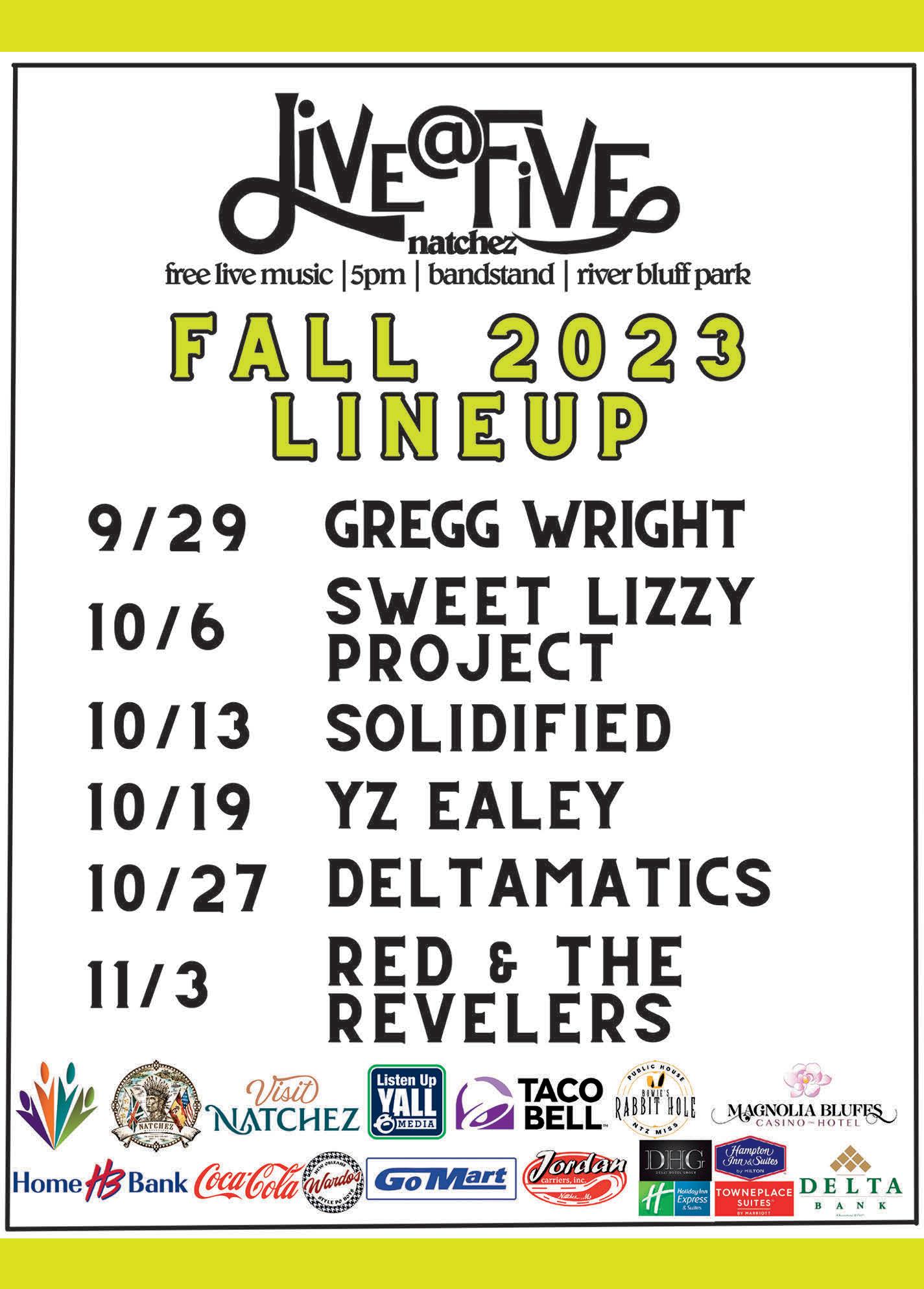

DANCE CONNECTIONS
THE CONVERSATION SERIES: STITCHING THE GEOPOLITICAL QUILT TO RE-BODY BELONGING WORLD DANCE PREMIER
Lafayette, Louisiana
Lafayette native Helanius J. Wilkins is a national award-winning choreographer and dance artist currently based in Boulder, Colorado—who is returning home to premiere his new full-length dance production The Conversation Series: Stitching the Geopolitical Quilt to Re-Body Belonging. The groundbreaking project combines technology, interactive gaming, music, fashion, and design and is inspired by a walking practice in which Wilkins walked up to sixteen miles a day to unlearn fear—and is performed by Wilkins and his creative partner Brandon Welch, bringing together two men with different racial and cultural backgrounds to explore interactions and collaborations between different sorts of bodies and experiences. Both nights will include performances by special guest vocalist and singer-songwriter Erica Fox. acadianacenterforthearts.org. •

Y'ALL MEANS ALL'S "THE WEEKEND"
Natchez, Mississippi
In Natchez, Mississippi, Y'all Means
All—meaning that the community itself, and all of its enterprises, thrive the most when they are inclusive. They're also a lot more fun. The organization Y'all Means All Natchez is a nonprofit organization benefitting local mental health organizations like Southwest Mississippi Mental Health Complex, National Alliance of Mental Health, Shareevolution, and others; and has a mission to provide safe spaces and community support for rainbow youth in the Natchez community. "The Weekend" kicks off Thursday at Smoot's Grocery with a double-billed Drag Show/ Tupperware party—featuring Josalyn Royale and the crew, along with a comedy show by Dixie Longate, described as "one part homemaker, one part bull rider, and one part Oprah Winfrey". 7 pm–10 pm. $20. Friday evening, Choctaw Hall hosts the Welcome Cocktail Party starting at 7 pm, giving guests the chance to meet and mingle with wine and cheese before the real fun begins. $35. Saturday morning brings a lively downtown Tour of Homes. Meet at Smoot's to convene and grab a drink, then enjoy a trolley ride through the downtown streets while
sipping cocktails (yes, it's legal in this neighborhood of Natchez) and basking in historic Natchez magic including shopping, historic home tours, Natchez Under the Hill, and more. 9 am–2 pm. Free. The evening brings Y'all Means All's largest fundraising event of the year: the Battle of Belles & Beaus contest (wherein straight men and women try their hand at drag to vie for the crown of the Lip Sync Battle), this time with Ms. Kasha Davis of RuPaul's Drag Race and Josalyn Royale performing and hosting. 7 pm–9 pm at the Natchez City Auditorim. $35; $50 for preferred seating. Sunday is the Drag Brunch at Frankie's on Main. Sip bottomless mimosas and enjoy the show, starting at 10 am. yallmeansallnatchez.org. •
OCT 26th - OCT 29th
FALL FAIRS LA FÊTE DES BAYOUS

Saint Amant, Louisiana


Our Lady of Holy Rosary Catholic hosts the annual La Fête des Bayous in the last weekend of October. Expect all the trappings of a great fall fair: rides, games, jambalaya and gumbo cookoffs, car show and talent show, live and silent auctions, and food for days. Special events include a Family Night featuring Boo with the Badge trickor-treating, a Nun Run, a kids’ fishing tournament, and a talent show. Did we mention live music? Look forward to performances by Foret Tradition, The Mojoes Dance Band, Mike Broussard & Night Train, and more. 2 pm–8 pm Thursday; Mass at 8 am Friday, cook off at 2 pm, rides open 5 pm–11 pm; events start at 7 am Saturday, rides open 11 am–11 pm; Mass at 7 am and 10 am Sunday, rides noon–5 pm. geauxlafete.com. •
FAIR FARE THE GREATER BATON ROUGE STATE FAIR
Gonzales, Louisiana
The Baton Rouge State Fair pulls out all the stops each year with rides galore on the carnival midway and live music almost every night. Clowns and magicians amble about while fair-goers feed on delicious fair food. Plus there's mutton bustin', lawn-tractor pulls, pig races, and an exotic animal petting zoo. Junior beef, dairy, and goat shows also add to the agricultural theme. For your lego enthusiasts, don't miss the annual Lego Extravaganza at 2 pm on October 28. It's a Baton Rouge tradition, this year at the Lamar-Dixon Expo Center in Gonzales. 5 pm–10 pm Mondays–Fridays; noon–10 pm Saturdays & Sundays. $5 and up. gbrsf.com. •

Baton Rouge, Louisiana
Preceding the Louisiana Book Festival are an exciting slate of writing workshops, led this year by authors André Dubus III, John Dufresne, Fatima Shaik, and Genaro Ky Lý Smith. The award-winning and bestselling authors will lead half-day writing "WordShops" on a variety of topics. Here's what to expect:
9 am–noon: "Flash! Writing the Very Short Story" with John Dufresne; "Bringing History Home" with Fatima Shaik
1 pm–4 pm: "Surrendering to the Mystery of Story" with André Dubus III; "What’s Good for Fiction Is Good for Poetry: Show Us, but Please Don’t Tell Us" with Genaro Ky Lý Smith
Registration for each WordShop is $50; for anyone attending two WordShops, the cost is $90. Space is limited. Registration payments are due by October 23. After that date, registration will be accepted
as space allows. To register, visit louisianabookfestival.org. •
Lafayette, Louisiana
This unique festival celebrates its seventeenth year with a weekend full of music, dancing, and food at Vermilionville. It's a cooperative of South Louisiana musicians, artists, and roots enthusiasts who'll be joined by groups from other parts of the country, too. On Friday night and Saturday, live performances range from Cajun and zydeco to blues, bluegrass, Americana, swing, and Irish; this year's lineup includes stellar shows like The Revelers, Jourdan Thibodeaux, Amis du Teche, Cameron Fontenot, and many more. An accordion contest and square dancing add to the music fever, and, then of course there's the cook-off. All weekend long, competitors will get down and dirty for the title of champion in categories: gumbo, gravy, cracklin', jambalaya, and
dessert. Guests can sample the goods on Saturday afternoon, and winners will be announced at 6 pm. 6 pm–midnight Friday ($30); noon–midnight Saturday ($40). Overnight camping is encouraged, so dust off that tent and get back to your roots (or if you prefer to sleep above the roots, bring your RV). Weekend rate, which includes camping, is $60. blackpotfestival.com. •

Mandeville, Louisiana
If it looks like a duck and quacks like a duck in the Castine Center this weekend, it's probably a masterfully-carved decoy. The annual Louisiana Wildfowl Carvers & Collectors Guild Festival will bring hundreds of carvers from around the globe to Mandeville. The extensive list of categories includes ducks, songbirds, fish, caricatures, wildlife, interpretive art, and more. There's an auction, live decoy carving demonstrations, a decoy painting contest, and a head whittling contest. Arts and crafts exhibitors will also set up in the Castine Center, and vendors will be on hand to sell carving and painting supplies. $5; free for children younger than twelve. 9 am–5 pm. lwccg.com. •
SEE
Baton Rouge, Louisiana
The annual St. Aloysius Fair returns, offering a weekend of family fun, including an outdoor mass and fair full of games, rides, fried treats, and other favorite fair fare. Live music by Parish County Line, Blue Verse, the LSU Gospel Choir, and more. Friday 5 pm–7:30 pm; Saturday 9:30 am–9:30 pm; Sunday outdoor mass at 9 am, Fairgrounds open at 10:30 am–2 pm, raffle drawing at 2 pm. Free admission. staloysiusfair.org. •
BON MANGER
FRENCH FOOD FESTIVAL
Larose, Louisiana
The Lafourcheais, or people of Lafourche, have been doing this tasty thing each October for forty-something years now, which is to stuff the Larose Civic Center with dozens of food booths then tempt thousands of festival-goers with local specialties such as white oyster soup and shrimp boulettes. There will also be live music by local artists like the Dream Junkies, Shorts in December, Waylon Thibodeaux, and Benjamin Bruce & the Acadians. Plus, exhibits, an art show, a petting zoo, carnival rides,
Frightmare on Main Street
October 7, 13, 14, 20, 21, 27, 28
Shadows Arts & Crafts Fair

October 14
Tailgating Cookoff

October 21
New Iberia Halloween Parade
October 28
Downtown New Iberia

October 14-15


IberiaTravel.com/GumboCookoff




and a Cornhole Tournament. 4 pm–1 am Friday; 11 am–1 am Saturday; 9:45 am–6 pm Sunday. Free admission; $20 for ride bracelets; $50 for the whole weekend. bayoucivicclub.org. •
Plaquemine, Louisiana
To honor the Acadian roots shared by so many area residents, Iberville Parish holds a Water Ceremony every year, a re-enactment of Longfellow’s poem in which Acadian exile Emmeline LaBiche (Evangeline) travels down Bayou Plaquemine on her journey to the Teche Country in search of her lover, Louis Arceneaux (Gabriel). As the story goes, she and her Native American guide spent the night on the banks of the bayou in what is now the City of Plaquemine. In the present-day ceremony, the Indian princesses and Evangeline (queen of the festival) arrive to greet the crowd at the Waterfront Park by fire-lit pirogues. All this, plus the typical festival trimmings:
rides, games, music, Cajun food, 4-H booths, arts & crafts, a cooking contest, fireworks, a Texas Hold 'Em Tournament, and the International Acadian Festival Parade at 10:30 am on Sunday. Kicks off on Friday at 5 pm with a Blessing of the Grounds, with music into the night. acadianfestival.org. •
IT'S ALIVE! YOUNG FRANKENSTEIN AT JPAS
Slidell, Louisiana
From the creators of the record-breaking Broadway sensation The Producers comes this wickedly inspired re-imagining of the Frankenstein legend based on Mel Brooks' classic comedy masterpiece at the Jefferson Performing Arts Center. The story follows bright young Dr. Frankenstein (that's pronounced "Fronkensteen") as he attempts to complete his grandfather's masterwork and bring a corpse to life. Frankenstein succeeds in creating a monster—but not without scary and generally hilarious complications. Thursday and Saturday
at 7:30 pm; Sunday matinees at 2 pm. Tickets start at $23. jpas.org. •
Folsom, Louisiana
It's planting season in Southeast Louisiana, and this fall festival will get you all prepped and ready. Meet local growers, ready to answer all your questions about your fall gardens, and provide all of the best equipment and accessories for purchase. Children's activities will also be onsite. 8:30 am–2:30 pm at Midway Church Park. Free. Details at the Folsom Fall Garden Festival Facebook page. •
Baton Rouge, Louisiana
Louisiana's annual literary festival returns this year, bringing hundreds of authors, literary-minded organizations, and bibliophiles together. Sprawling over the grounds of the Louisiana State Capitol, the State Library of Louisiana, Capitol Park Museum, and Capitol Park Event Center; expect book talks, workshops, signings, an Author Party
on Friday night at 7 pm, and plenty more literary loveliness. This year, catch Country Roads editors Jordan LaHaye Fontenot and Alexandra Kennon, with contributors Ruth Laney and Sam Irwin —who will all be presenting a panel discussing Country Roads' magazine's 40 years spent exploring and chronicling Louisiana culture. 9 am–4 pm. Free. Full event schedule at louisianabookfestival.org. Tickets to the Author Party at 7 pm on Friday are available at bontempstix.com. •
BAYOU COUNTRY MUSIC ACADIA MUSIC
Thibodaux, Louisiana
National musicians join familiar names on the same stage for Thibodaux's Acadia Music Fest. An Arts Market and Southern food court round out this music festival in the heart of bayou country, with a lineup that includes: Marcus King, Better Than Ezra, Little John & The Dirty Clarks, MJ Dardar Band, and many more. All profits will benefit the Ben Meyer Foundation to help charities in the community, including CASA of Lafourche and MacDonell Children's Services. At Acadia Plantation Town Center in Thibodaux. acadiamusicfest.net. •
OCT 28th
SCENIC SOUNDS
LPO'S SUNSET SYMPHONY ON THE LAKE
Mandeville, Louisiana
Be whisked away on wings of sound when the Louisiana Philharmonic Orchestra crosses the causeway and serenades the sunset for Mandeville's annual Sunset Symphony on the Lake performance at the Mandeville lakefront. Expect to hear classics such as Gershwin's "Cuban Overture," Duke Ellington's "Fantasy," John Williams's "Theme from Jurassic Park," and Sousa's "Stars and Stripes Forever"—all conducted by Matthew Kraemer. Grab your lawn chairs and blankets and make an evening of it. 4:30 pm–8 pm. Free. experiencemandeville.org. •
OCT 28th
SWEET AS PIE
SWEET DOUGH PIE FESTIVAL
Grand Coteau, Louisiana
Head to the grounds of Grand Coteau
Town Park for the annual celebration of the traditional goodness (custard, fig, lemon, blackberry)-stuffed pastry beloved by locals (And anyone else who takes a bite). Browse through more than seventy vendors of arts, handmade items, flowers, and more while enjoying local food and live music by
Jeffrey Broussard and the Creole Cowboys Band, and Patrick Henry and the LB Band. And of course, a pie competition. You can bet there will be piles of pie to buy, too. Proceeds to benefit the Grand Coteau Cultural Foundation. 9 am–3 pm at 231 Burleigh Lane, behind Town Hall. For more information on the festival, visit the Town of Grand Coteau Facebook Page. •
OCT 28th
AFTERNOON TUNES
LONGWOOD MUSIC FEST
Natchez, Mississippi
Once again, Longwood—an architectural treasure—hosts its annual all-day music festival, featuring live performances from the Lamont Landers Band, Hana Hart & Friends, NRhthm, Hash Cabbage, and Logan Sanders & Band. Look forward to plenty of family-friendly activities, local arts and crafts vendors, beer, and much more. Gates open at 11 am–8 pm. $20. Kids younger than ten are free. longwoodafternoon.com. •
OCT 28th
CONCERTS A LOUISIANA SATURDAY NIGHT
Gonzales, Louisiana
See Flatland Calvary, Wyatt Flores, Bryan Martin, & Trey Gallman perform

ST. FRANCISVILLE'S YELLOW LEAF FESTIVAL KEEPS MUSIC AND ART AT THE FOREFRONT AFTER ALL THESE YEARS
 By Alexandra Kennon
By Alexandra Kennon
Like most good things, the Yellow Leaf Festival started from modest beginnings, with around a hdozen vendors selling their art in the gravel parking lot of the 3V Tourist Court outside of the original location of Birdman Coffee. “We had music and people
attendees in the first place.
The music always includes staples like The Fugitive Poets, plus many others, over the course of the two days. And live painters are also favorite fixtures of the fest. This year, Ellen Langford from Jackson, Mississippi will be painting on-site. "She paints with gusto, and it's kind of broad strokes," Wood said. "I think it'll be so much fun to watch."
Though the musicians and artists may change, Yellow Leaf's small town appeal remains. “It's got its own flavor,” Wood said. “And it's got a sort of a peaceful atmosphere. And that's why the artists really enjoy coming to it." •
Yellow Leaf is held in Parker Park in St. Francisville on October 28–29. See listing on page 40 for more information.
together live at the Lamar Dixon Expo Center this weekend. 6 pm. Tickets start at $35. lamardixonexpocenter.com. •
OCT 28th
RIPE FOR THE PICKIN' HARVEST MOON FESTIVAL

Franklin, Louisiana
Franklin's annual street festival celebrates the beauty of the season and the spirit of the sugar cane harvest. Head to Main Street in Franklin's historic district and join in the the fall-flavored fun. Highlights include the Louisiana Cane Syrup Expo, a pooch parade, a wooden boat show, scarecrow and pumpkin decorating, a classic car show, children's activities, and live music. And of course, plenty of warming food to stave off the coming winter. 10 am–3 pm. cajuncoast.com. •
OCT 28th - OCT 29th
BANG BANG!
REVOLUTIONARY WAR LIVING
HISTORY WEEKEND
Saint Francisville, Louisiana
Audubon State Historic Site presents a
day of education about the Revolutionary War, from camp life to cannon demonstrations to period dancing and beyond. At 2 pm Saturday and 1 pm Sunday, Revolutionary War reenacters will stage a skirmish. 10 am–3 pm. $5 grounds fee. Call (225) 635-3739 for more information. •
SMALL TOWN FESTIVALS
YELLOW LEAF ARTS FESTIVAL
Saint Francisville, Louisiana
Authentic, inimitable, and running on a full tank of small town charm, the Yellow Leaf has become a favorite with artists, craftspeople, musicians, and collectors—many of whom have been involved every year since the festival's inception. Upwards of forty artists and craftspeople come to Parker Park to show and sell paintings, pottery, metalwork, handmade boats, fabric art, wood pieces, sculpture, glass art, jewelry, carvings, and lots more. The featured artist this year is Mississippi painter Ellen Langford—who will present painting demos at 1 pm each
day. Then there's the music—always a home-grown bunch of the area's most talented songwriters like the Fugitive Poets, Daytrip, and more. No factoryproduced items, noisy generators, or carnival rides; just a heady blend of art, music, poetry and, nature, from 10 am–5:30 pm in Parker Park. Free. stfrancisvillefestivals.com. •
OCT 29th
MOVING MOVEMENT
BALLET MAGNIFICAT
Baton Rouge, Louisiana

Billing itself as "America's premier Christian ballet company," Ballet
Magnificat is bringing Jiri Sebastian Voborsky's full-length ballet The Scarlet Cord, presented by Baton Rouge Ballet Theatre, to the Manship Theatre stage. The production follows the story of two missionaries who hold fast to their faith in the heart of the Communist Soviet Union. Shows at 2 pm and 7 pm. $26–46. batonrougeballet.org. •
OCT 29th
BLUE DOGS & BAYOUS ETHEL CLAIBORNE DAMERON LECTURE SERIES: WENDY RODRIGUE
Port Allen, Louisiana
For its 2023 presentation of the Ethel
Claiborne Dameron Lecture series, the West Baton Rouge Historical Association welcomes Wendy Rodrigue, surviving wife of the late Louisiana artist George Rodrigue, famous for his "Blue Dogs" and other paintings capturing the culture and lore of the Bayou State. Wendy's talk is titled "George Rodrigue: Reflections of Love," and will walk attendees through George's process and technique of transferring his emotions onto canvas, particularly how he did so following his cancer diagnosis. The lecture will accompany the WBRM's current exhibition The River is the Road: Paintings by George Rodrigue, and Wendy will bring in paintings from her personal collection for the presentation. 2 pm. Free. westbatonrougemuseum.org. •


Beginning October 6th - October 21st
The woods outside of Lafayette are full of things that go bump (and growl, and rawr) in the night. Are you brave enough to wander through them? Find out on the Fright Trail, founded by Literacy Inc., the nonprofit dedicated to fighting the growing illiteracy rate in America's teens. Through twenty miles of deep, dark, haunted woods, wanderers might run into any sort of bump in the night—the creators pull out all the stops for this outdoor open house: props, animatronics, displays, sets, and scare actors galore. How long does it take? (Generally, thirtyfive minutes.) How fast can you run? This year, don't miss the Fright Trail's Frights without Lights on October 28 and 29. Due to the outdoor nature of the event no open-toed shoes, high heels, or flip-flops; old shoes or boots are recommended. Not recommended for children under eight years of age, children under ten years of age must be accompanied by an adult. Friday and Saturday nights from 7 pm–
11 pm (as well as Sunday October 29 and Tuesday October 31). $30 to be paid in cash at the box office. frighttrail.com. •
Baton Rouge, Louisiana
The LSU AgCenter Botanic Gardens at Burden invites parents to lose track of their little ones for just a bit while they let the kids try to find their way through the traditional fall corn maze. On Corn Maze Saturdays, besides navigating the maze of maize, you can romp around a haystack mountain, paint a pumpkin, visit the petting zoo, get a temporary tattoo, or join the hayride around the property. Sessions from 9 am–11 am, noon–2 pm, and 2:30 pm–4:30 pm. Save a few tricks and treats for the Night Maze & Bonfire on October 28, with an evening bonfire, games, and a live concert from local musicians. Remember to wear your costume. 6 pm–9 pm. $15; free for children two and under. lsuagcenter.com. •
New Iberia, Louisiana

New Iberia's downtown gets a creepy takeover in time for Halloween—each weekend in October leading up to the big day, the Historic Hot Sauce House on Main Street provides a spooky backdrop for a trail of frights, where sets and live scare actors await. 7 pm–11 pm the last three Fridays and the last four Saturdays in October. The Hot Sauce House on Main, 924 E. Main St. $20. frightmareonmainstreet.com. •
Baton Rouge, Louisiana
TMM Project is infusing hip-hop into the Halloween fun with a live saxophonist, percussion, break dancing, Halloween safety tips, and story time. Kids can stomp their feet at the following library performances:
October 12: Main Library, 10 am; Scotlandville Branch Library, 2:30 pm.
October 13: River Center Branch Library, 10 am; Greenwell Springs Road Regional Branch Library, 2:30 pm.
October 14: Carver Branch Library, 10 am; Pride-Chaneyville Branch, 2:30 pm.
October 16: Zachary Branch Library, 10 am;
Jones Creek Regional Branch Library, 3 pm. Free. ebrpl.com. •
OCT 14th
UNDEAD ANTICS
SBC ZOMBIE WALK
Bossier City, Louisiana
Get ghouled up and ready to prowl for brains at the Bossier Arts Council's annual Halloween Festival for a good cause, this year with the theme "Zom-Beats". Expect a macabre vendor market, creative costume contests, door prizes, live music, games, food trucks, and much more. Proceeds will go to support the Food Bank of Northwest Louisiana. LifeShare Blood Center will also be on site taking blood donations. 4 pm–9 pm in East Bank Plaza. Details on the SBC Zombie Walk 2023: Zom-Beatz Facebook Event. •
OCT 14th
TIME WARPS
THE ROCKY HORROR SHOW AT 30 BY NINETY THEATER
Mandeville, Louisiana
30 by Ninety Theatre presents the Halloween season cult favorite about what happens when a nice, modest couple like Brad and Janet find themselves trapped at the raucously creepy castle of the lingeriewearing mad scientist Dr. Frank-n-Furter.
Friday and Saturday performances at 8 pm; Sunday performances at 2:30 pm. $25–$32. 30byninety.com. •
SWAMP SCARES
FIELD OF SCREAMS
HALLOWEEN TRAIL
Covington, Louisiana
An evening stroll down the Blue Swamp Creek Nature trail is not for the light of heart, not this evening. For the City of Covington Department of Parks, Recreation & Cultural Affairs' Field of Screams Halloween Trail event, costumed explorers expose themselves to startles and frights of every kind. Join in on the screams, if you dare. Sunset–10 pm. Free. visitthenorthshore.com. •
TREATS SANS TRICKS
A MERRY NOT SCARY HALLOWEEN
Port Allen, Louisiana
This Halloween-inspired evening at the West Baton Rouge Museum is quite merry, and not so scary, so the whole family can enjoy. Seasonal activities (with a return of old favorites like the pumpkin patch and spoon-andeyeball race), a costume contest, crafts and treats, and two family-
friendly Halloween magic shows at 6:45 pm and 7:15 pm. Bring blankets and lawn chairs. 6 pm–8 pm. Free. westbatonrougemuseum.org. •
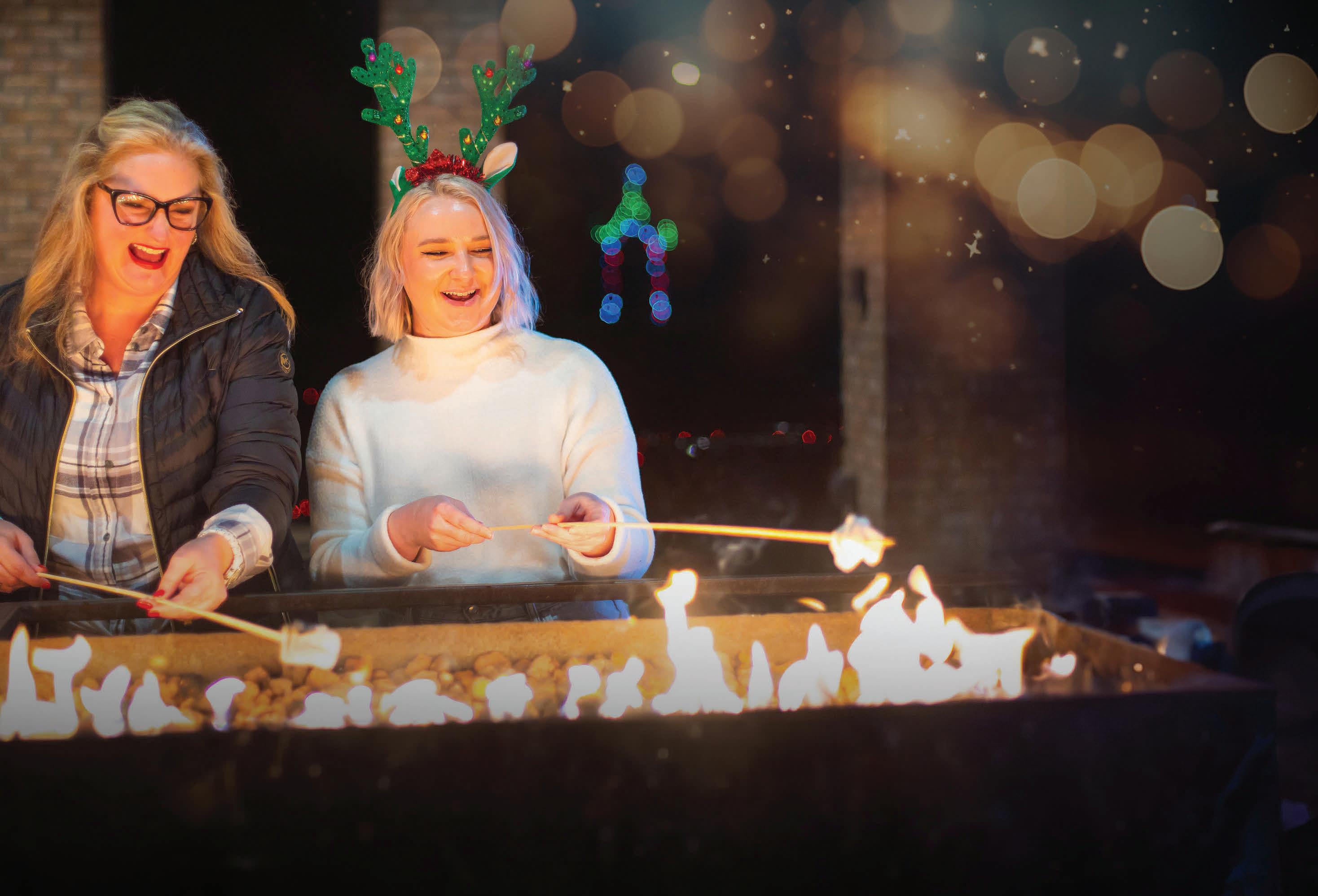
Houma, Louisiana
There is no better way to defeat your demons than to confront them, or so might seem the logic of Rougarou Festival organizers. This festival in downtown Houma revels in the thrill of terror, while remaining family-friendly. The festival itself is a creepier take on the traditional Louisiana festival, which, of course, must involve the crucial components of food and music; but organizers have upped the ante with a costume contest (voted one of the ten best in the country by USA Today), a spirited parade, a scary scavenger hunt, and carnival rides. Take part in a howling contest, a pumpkin lighting, a nutria pardoning, a moss doll workshop, a Day of the Dead celebration, and more—plus various expert conversations on culture and climate. And there's no skimping on the food: Rougarou Stew (jambalaya), blackberry dumplings, alligator bites, and beignets are among the menu selections. Main Street and Church Street. Free. rougaroufest.org. •
Slidell, Louisiana
Cutting Edge Theatre is rethinking Rocky Horror Picture Show by throwing in a coven of witches and a post-apocalyptic future, while including all the favorite song and dance numbers. 8 pm–10:30 pm. $32–$47. cuttingedgetheater.com. •
Covington, Louisiana
The Monster Mash Fun Fall Family Festival—can you say that three times fast?—sends a seasonal gust of ghoulishness and good times through Bogue Falaya Park. An annual fundraiser for the St. Tammany Hospital Parenting Center, touted as a safer option to the usual end-of-month capers, features a Trick-or-Treat Village, arts & crafts, carnival rides, and food and beverages for purchase. Enhance your trick-or-treating experience as a VIP at the Pumpkins and Potions Pavilion, featuring a photo booth, full-face painting, and a special gift. Costumes highly recommended. 10 am–2 pm. sthfoundation.org. •
OCT 21st
DINNER & A MURDER
VERMILLIONVILLE PRESENTS
MURDER ON THE BAYOU
Lafayette, Louisiana
Vermilionville is hosting an interactive murder mystery dinner aiming to solve the question of the Ghost of Beausoleil—whose presence always results in a murder. Gather clues, and find the true story before you run out of time. $30; $15 without dinner. Costumes encouraged, adult beverages available for purchase. 7 pm–10 pm. Details at the Murder on the Bayou Facebook event. •
SPOOKY IN THE STREETS
KREWE OF BOO PARADE
New Orleans, Louisiana
The official Halloween parade of New Orleans is back to creep the night away. Krewe of Boo rolls at 6:30 pm, creaking its way through the Boo Carré along North Peters, Canal, and Tchoupitoulas. kreweofboo.com. •
OCT 21st
PUMPKIN PARTIES
PUMPKINS IN THE PARK & AUTUMN MARKETPLACE
Covington, Louisiana
Peruse the pumpkin patch as well as the
Beginning October 22nd - October 28th
art market, savor bites from local food trucks, make memories on the hayride, and other seasonal fun at TerraBella Village. 11 am–2 pm. $8 per pumpkin. terrabellavillage.com. •
Lafayette, Louisiana

Vermilionville gets a bit creepier in time for Halloween—but not too creepy, as their Boo Bayou Fall Festival is plenty of fun for the whole family. The day of Halloween fun will include a coloring station, old-time games, balloon animals, fall movies, trick-ortreating throughout the historic village, chances for kids to decorate their own Halloween treats and make their own Halloween crafts, and plenty of photo opportunities at the Fall Photo Station. Costumes are encouraged with candy incentives, we hear. 10 am–3 pm. $5 for those over the age of two. Find the event on Facebook for more information. •
Baton Rouge, Louisiana
The capital area's favorite Halloweenmongers are back, 10/31 Consortium brings back its beloved slate of hilarious and haunting events. Kick things off with a streak of dastardly do-gooding, by donating gently used Halloween costumes and (store-bought, individually-wrapped) candy to ensure that all of the little monsters can have their day on the streets. The Fifolet Costume and Candy Drive will be held from September 1–October 20 at locations all over Greater Baton Rouge. On October 22, the Main Library at Goodwood will host the Costume Giveaway Day, during which any child in need of a costume can receive one for free while supplies last. The hallowed weekend itself brings its own set of festivities, starting with the Fifolet Hallween Festival Pub Crawl; The Fifolet Hallween Ball; a 5K (run it in a costume, or while carrying a pumpkin) and fun run; an Arts Market; a pumpkin pie eating contest, and a pumpkin carving contest. All will conclude with the
annual Halloween Parade, featuring local krewes and businesses showcasing their weirdest ideas, and bestowing treats upon all. Get all the details, and information about all access passes ($375) at 1031consortium.com. •
WITCHY BUSINESS
MOONLIGHT OVER MELROSE
Natchitoches, Louisiana
Lean into the spookiest season at Melrose on the Cane's extravagant Halloween festival, which begs attendees to don their costumes for carnival games, a "Witches Dance," a trunk-or-treat lane, home tours, tasty sweet and savory treats from the Association for the Preservation of Historic Natchitoches, and more. 6 pm–9 pm. $5 for adults, $10 for ages three–seventeen. melroseplantation.org. •
SPIRITED OCCASIONS
SMOOT'S GROCERY
HALLOWEEN BASH
Natchez, Mississippi
The Krewe of Bon Temps and Ice Queens are hosting a Halloween Bash at Smoot's Grocery including music by NRhythym, a 360 Photo Booth, auctions, a costume
contest, and more. 7 pm. $25–$40. bontempstix.com. •
OCT 27th
MONSTER MASH
OLDE TOWNE SLIDELL
ZOMBIE CRAWL
Slidell, Louisiana
Olde Towne goes Halloweentown for this festive fall fete—featuring trickor-treating, a costume contest, and over seventy-five local artists and crafters all along four blocks of downtown Slidell. Don't miss the local music acts, as well as games and crafts for children. 5 pm–10 pm. Free. Visit the Olde Towne Slidell Facebook page for details. •
OCT 27th - OCT 29th
NOLAWEEN HALLOWEEN NEW ORLEANS
New Orleans, Louisiana
Originally founded as a fundraising initiative to support Project Lazarus, a home in New Orleans for men and women living with AIDS, Halloween New Orleans has grown to a fullfledged queer Halloween Festival. With this year's theme of Halloween XL, the events are a formal celebration of the festival's 40th anniversary featuring a
silent auction, parties, performances, and more. Details and full schedule at halloweenneworleans.com. •
Mandeville, Louisiana
If you like dogs, outdoor art markets, or animal-themed puns (that should cover about everyone), come to Pelican Park for a Howl-o-week celebration (sorry, had to). Expect a pet adoption station, vendors, a photo booth, paw print painting, Tricks for Treats, and more. 2 pm–4 pm. Free. pelicanpark.com. •
FALL FUN MONCUS PARK'S AUTUMN IN THE OAKS
Lafayette, Louisiana
Activities like pumpkin bowling, themed putt putt, ample fall photo opportunities, pumpkin patches, and more will fill Moncus Park for the annual fall celebration that is the Autumn in the Oaks Festival. The day will also bring out plenty of local food booths and trucks; plus hayrides, entertainment, and music from Wonderland Academy for this seasonal family event. 3 pm–
6 pm. Free. Free parking at Blackham Coliseum with free shuttles to Moncus Park. $20 on-site parking fundraiser. moncuspark.org. •

Arnaudville, Louisiana
The Halloween Art & Nature Festival is a free, family-friendly event inviting all children and families to celebrate Halloween and Louisiana's special natural surroundings through art, music, food, and science—all on Brandon Ballengée's 25-acre nature reserve and eco-educational campus. This year's theme is "The Deep" (to be interpreted as you please: deep sea life, deep cultural roots, deep botanical roots, deep traditions). Special guests will include special effects artist Chuck Varga—the official Neptune, King of the Coney Island Day Mermaid Parade; Walter Sandifier III, Spy Boy of the Beautiful Creole Apache Mardi Gras Indian Tribe from New Orleans; and New Orleans Playwright Lisa D'Amour. Workshops include "Creatures from the Deep" makeup effects; S.T.E.A.M. activities with Mermaidens, "Deep Explorations Activity Book"-making ;
preserved deep-sea specimens drawing; DIY Aquanaut Costume and submarine sculptures; geothermal energy outreach; sustainable seafood cooking; and more. Not to mention countless fascinating installations, exhibitions, and performances. Plus, trick or treating, of course. Live music performances will be curated by Laura Huval of Sweet Cecilia and food will be provided by Chef Colt Patin and his students from the Culinary Institute in Baton Rouge.
Registration is required, but the event is free. 10 am–4 pm. atelierdelanature.org. •
OCT 28th
PAINT IT BLACK
NEW IBERIA HALLOWEEN PARADE

New Iberia, Louisiana
Watch the annual painting of the New Iberia fountain black at City Hall,

Beginning October 28th - October 31st
before the the annual Halloween Parade through town, all to end with a Chee Weez concert at the Steamboat Pavilion in Bouligny Plaza. 2 pm–4 pm. Details at the Downtown Halloween Parade Facebook Event. •
OCT 28th
BEERY SPOOKY
BAYOU TECHE BREWING
HALLOWEEN BLOWOUT
Arnaudville, Louisiana
The brewery's going spooky for the season—from the decor to the beer to the gelato. They expect you to match their energy; come to this event in costume, ready to monster mash the night away. 4 pm–7 pm. Details at the Bayou Teche Brewing Halloween Blowout Facebook Event. •
OCT 28th
WELCOME, WITCHES WITCH WAY TO MAIN STREET
Natchitoches, Louisiana
Trick-or-Treaters and their grown-ups are invited to 103 Rue Beauport in Natchitoches for trick-or-treating, games, and other fun. 6 pm–9 pm. natchitoches.com. •
OCT 28th
FALL FUN
BOO FEST
Covington, Louisiana
ACCESS (Adapting and Changing Children’s Environments with Successful Solutions), a locally founded non-profit fund of the Northshore Community Foundation, will hold the annual Boo Fest on the grounds of Lakeview Regional Medical Center. The popular Northshore event benefits children with disabilities and their families, but is open to children of all abilities. The day is packed with lots of fall-themed activities, including pumpkin decorating at the pumpkin patch, face painting, all-abilities games, a complimentary photo booth, music and dancing, and much, much more. 10 am–3 pm. $2. accesslouisiana.org/boofest. •
OCT 29th
BEERITS
BOO & BREW
New Roads, Louisiana
New Roads is hosting its first annual Boo & Brew Halloween event, which will fill downtown overlooking False River with craft beer, local food, live music, and Halloween activities for the kids galore.
Local businesses will host a "trunk or treat," alongside face painting, balloon animals, pumpkin and costume contests, yard games, a live caricature artist, and more. 3 pm–6 pm. $10 adults, $5 kids. bontempstix.com. •
OLD FASHIONED HALLOWEEN HAINTS, HAUNTS, AND HALLOWEEN
Baton Rouge, Louisiana
It's a Rural Life Fall Fair! "Haints, Haunts, and Halloween" honors the sights, sounds, and activities of an old-fashioned country Halloween. Storytelling, cake walks, pumpkin decorating, games, and the timeless art of trick-or-treating will take place on the museum’s grounds. Costumes encouraged, of course. 2 pm–4:30 pm. 4560 Essen Lane. $12; $6 for ages 4-12; free for ages 3 and younger. lsu.edu/ rurallife . bontempstix.com. •
TREATS IN THE STREETS
ABITA SPRINGS TRICK-ORTREAT BLOCK PARTY
Abita Springs, Louisiana
Abita Springs hosts its annual Halloween block party on the big night, featuring trunk-or-treating, hayrides, live music, a photo booth, treats like cotton candy and hot dogs, and more—all in the streets and surrounding Abita Springs Town Hall. 6 pm–8 pm. Free. townofabitasprings.com. •
For our full list of October events, including those we couldn’t fit in print, point your phone camera here.

Ladies and gentlemen, St. Francisville is coming on strong! With new shops, restaurants, accommodations, and entertainment venues opening this summer and during the months to come, more visitors are finding reasons to come to St. Francisville than ever before. This is making tourism an increasingly important driver of the West Feliciana economy. According to research by the Louisiana Office of Tourism, during 2022 tourism to West Feliciana parish generated more than $25 million in visitor spending—a 24% increase over pre-COVID numbers in 2019. Hotel occupancy grew by 7.7% over the past year, and visitor spending generated 283 jobs and $8.4 million in employment earnings, contributing nearly $3 million to state and local tax revenues. Soon, with new attractions including North Commerce (encompassing The Corbel, The Mallory event center, the Barlow and Deyo stores, and Hotel Toussaint), Bayou Sara Brewing Company, Big River Pizza Co., The Royal Inn, and The Monkhaus bed and breakfast all opening for business during the coming months, visitors and residents alike have all sorts of new amenities to look forward to in 2023 and beyond.
To promote all that St. Francisville has to offer as a travel and tourism destination, in August the West Feliciana Tourism Commission unveiled new branding designed to showcase St. Francisville “For the Inspired Traveler.” West Feliciana Tourist Commission Executive Director Devan Corbello (pictured), said “St. Francisville’s new look brings together the charm and history of our vibrant community with a fresh new feel. Our goal has been to highlight our area’s many gems, and appeal to a new generation of travelers. The new brand offers a modern take on classic charm. And it gives us a wonderful foundation to grow.”
So, whether you love to visit St. Francisville or are lucky enough to call it home, expect to see St. Francisville’s inspired new look on brochures, billboards, in print and online.




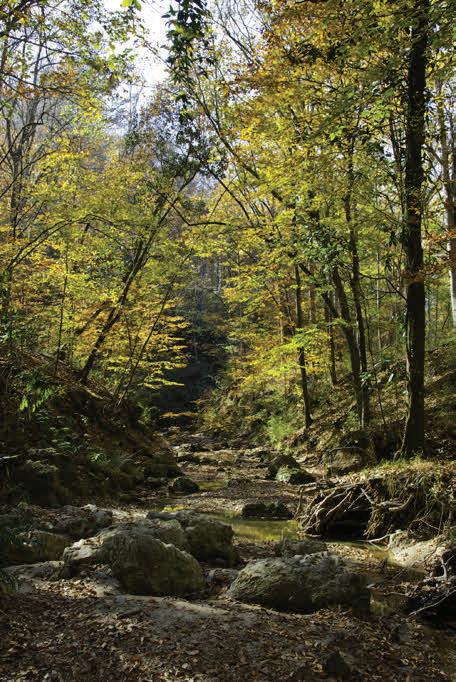

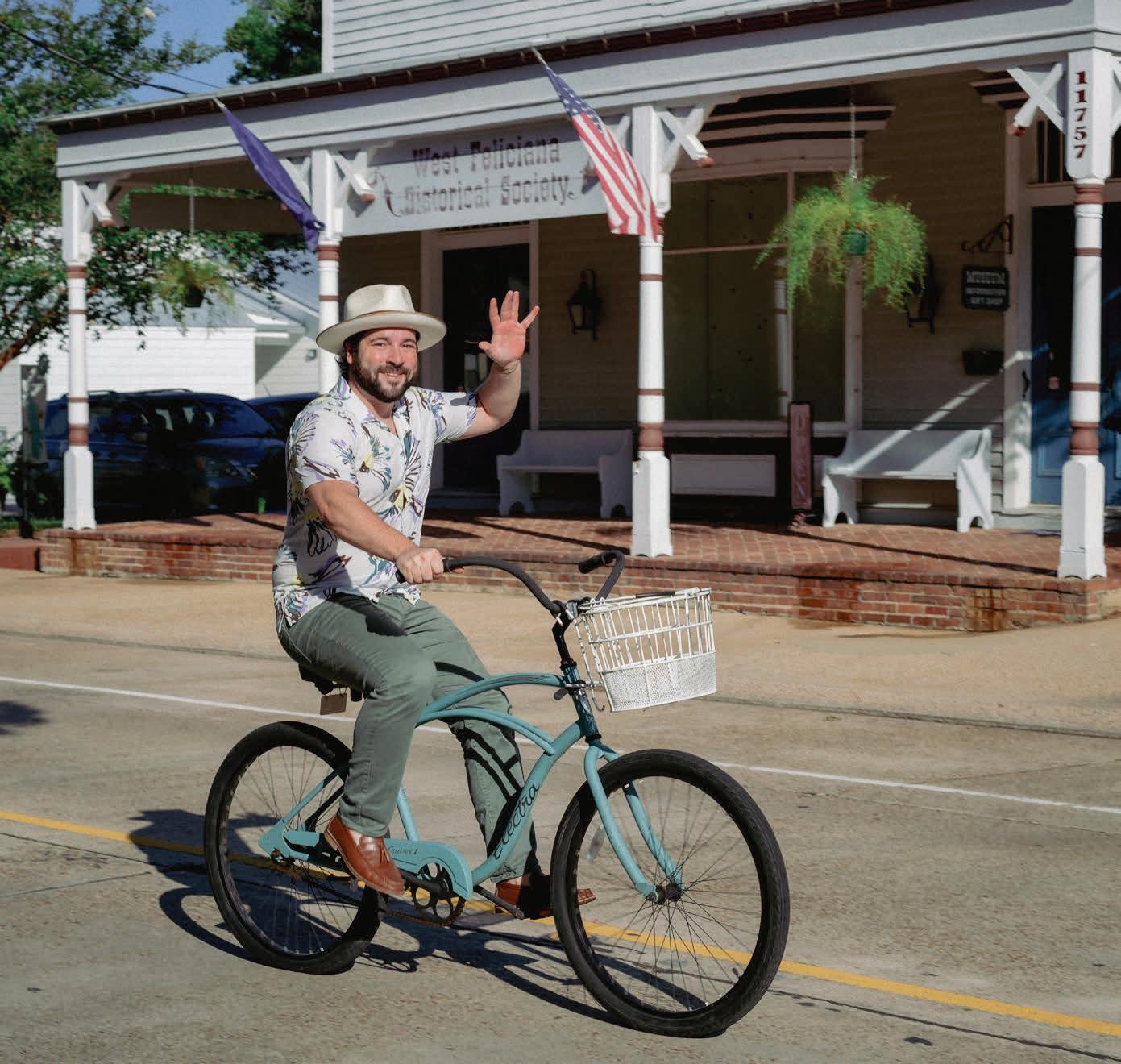
To see for yourself and learn about all that West Feliciana has to offer, now and into the future, go to visitstfrancisvillela.com.






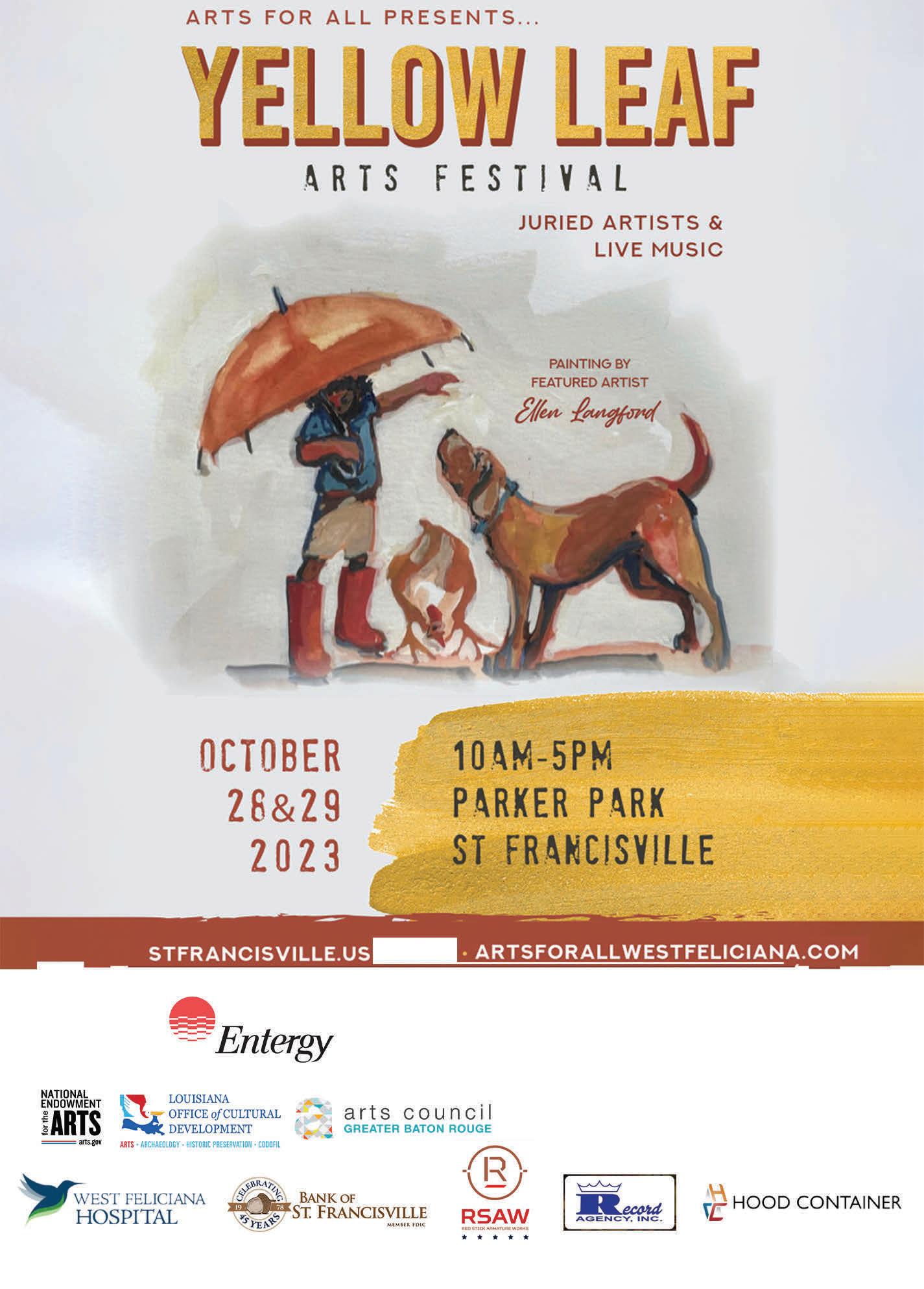








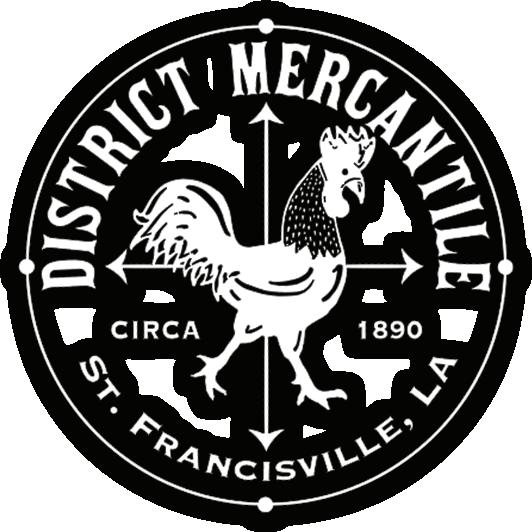
















A TUNICA-BILOXI FOLKTALE YOU PROBABLY HAVEN'T HEARD BEFORE // 55 THE THINGS THAT 'HONTE'

// 57 AMERICA'S MOST FAMOUS MADE UP LANGUAGE MIGHT ACTUALLY BE REAL •
IN AVOYELLES PARISH, A LOUISIANA FOLKTALE THAT TRANSCENDS TIME AND LANGUAGE
Mention the word “Pachafa” in Avoyelles Parish and you’re likely to get at least half of a story. For generations, children have feared the tale of the grisly half-man creature coming to steal them away. As for the other half of the tale…well, it depends who you ask.
“When you were a little boy, there you were alone in the woods, in the cypress swamp,” begins anthropologist and Avoyelles Parish native, Dustin Fuqua. “It’s very quiet. You hear a whistle.” He emits a high-pitch whistle through his teeth, then pauses, “and you look up high, high in the tree. Behold! Pachafa!”
Fuqua recounts the tale in Avoyelles-accented Louisiana French, the way he heard it from family members growing up. “Pachafa starts to come down from the cypress tree,” he continues, looking up. “He sees the little boy.

In one hand, he offers herbs; in the other hand, he offers a knife. If the little boy chooses the herbs, he becomes a medicine man. If he chooses the knife, he’ll become a warrior.”
While the story of Pachafa is familiar to residents across the parish, it has a prominent presence in the Spring Bayou, otherwise known as Bayou Blanc, community, which is located a few miles outside the parish seat of Marksville, near the Tunica-Biloxi Tribe of Louisiana reservation. For Fuqua, Spring Bayou is the frightening mise-en-scéne for Pachafa. “The earliest recollection I have of Pachafa was riding in the car in the Spring Bayou Wildlife Management Area,” says Fuqua, who was always told by his mother that Pachafa lived in an old Wildlife and Fisheries maintenance building, near the Boggy Bayou boat launch—only about twenty minutes from his family’s home. Fuqua and his family would make
the drive often; fear and anticipation building as they crept down the gravel road, closer and closer to Pachafa’s house.
Spring Bayou Wildlife Management
Area spans 12,000 acres across the Red River backwater system. A series of coulees, lakes, and rivers flow through the area and its communities, and with them flows the tale of Pachafa. On the edge of the system, running through the middle of the Tunica-Biloxi reservation, is a canal called the Coulée de Greus, which flows into Old River and then into Spring Bayou. In the story of Pachafa, the Coulée de Greus and Spring Bayou, as well as the Fort DeRussy cemetery in the Brouiliette community, are prominent sites in the Tunica and French Creole tellings. As Fuqua points out, Coulée de Greus is a sacred place where cemeteries were once located and, according to some Tunica tellings of the story, where Pachafa camps out. While Pachafa has
no explicit homebase, he hovers near and around these historic waterways and the indigenous mounds surrounding them, never shifting too far geographically. ”His story is pretty localized,” says Fuqua, “and, in my opinion, it’s because of the presence of the mounds.”
Language bears on the malleable nature of Pachafa’s story and name. The many iterations of the tale exemplify the complex interaction of culture and language that historically make up Avoyelles Parish. While the most widely recognized name for the legend is “Pachafa,” there are various spellings and interpretations. To children who heard the tale from French Creole speakers, he became “Johnny Pachafa.” Some, like Fuqua, believe this to be an anglicized version of the French folktale “Jean á patte de fer,” meaning “John with an iron paw,”
and referring to a character who has a prosthetic foot. For members of the Tunica-Biloxi Tribe of Louisiana, he was “Tanapachafa,” or simply, “Tanap"— which is originally a Choctaw word associated with war.

Dr. Pete Gregory, who is the curator of the Williamson Museum at Northwestern State University, and Donna Pierite of the Tunica-Biloxi Cultural and Educational Resource Center, translated the Tunica legend to “Tanap apah achafa,” loosely describing a half-man, half-warrior with only one leg. According to Fuqua, Gregory, and Pierite’s research, the word “tanap” might also derive from the Tunica word “tana,” meaning “louse,”—a common slang term for a scoundrel or rascal. The Tunica word, “pachafa” is used to describe someone who walks with a limp—a notorious idiosyncrasy of Pachafa.
Though in almost every iteration of the folklore Pachafa is half-man, besides the other half being a warrior—he might instead be half alligator, or half horse. Occasionally, he is simply described as half of a man—limping along railroad tracks or lurking in nearby woods and fields.
Fuqua and Pierite believe that Pachafa’s story may have been adopted from the Choctaw tale of the “Little People”. Similarly, in this legend, a little boy wanders into the woods and is presented with the choice of a knife or herbs. The Tunica-Biloxi tribe includes many people of Choctaw descent who, over generations, might have reinterpreted this tale and since preserved the story of “Tanapachafa.” Some Tunica versions reference the herbs and the knife, while other versions pit Tanap against the young boy in a wrestling match.
Members of the Tunica-Biloxi tribe consider hearing the tale of the Tanapachafa as a rite of passage. Pierite, who serves as the Tunica-Biloxi Legends and Songs Keeper, has complex feelings toward Tanap. “There was fear, but there was also respect,” explained Pierite. She recalls the ceremonial way in which her grandmother shared folktales—locking the front door, and then her bedroom door, sitting the children on the side of the bed and, in a low voice, passing the knowledge of Tanap to the next generation.
For Pierite, hearing these folktales was a private and personal event. Growing up, she was told not to tell anyone the stories she heard because people would laugh. Keeping them close to your heart was a way to protect yourself from potential judgment or mocking. Pierite describes the difficulty of initially sharing the folktales with the public at Tunica-Biloxi Pow Wows. Over the years, however, her pride vanquished any fears. “This is our inheritance. This is the treasure,” she said.
The intimate nature of native folktales, coupled with the departure of large
numbers of Tunica from the Avoyelles area over the past fifty years, may contribute to the strong association of Pachafa with the lore of the French Creole community in Avoyelles. However, like most of the best Louisiana traditions, the story is an amalgam of the many cultures that make up the area. Each of its diverse retellings is pivotal to its preservation.



In the near decade he’s spent researching the legend of Pachafa, Fuqua has not come across any historical references or written accounts of the legendary spirit, other than a brief description he helped to create for the Pachafa Pale Ale brewed at Broken Wheel Brewery in Marksville. The story is ever-changing, ever-evolving, preserved only within the archive of individual memory. This is perhaps what makes such oral traditions so sentimental; we cling to our subtle variations of the stories as a way to remain close to our identities and our ancestors. It is also what makes the folklore a unifying agent, allowing us to bond over commonalities and shared experiences. As Nathan Rabalais explains in his book Folklore Figures of French and Creole Louisiana, “The paradox of specificity and universality is what gives readers and listeners around the world the peculiar impression of both familiarity and novelty.”
Pachafa is regional and specific; always lurking in proximal locations such as cornfields, bayous, or under nearby bridges. According to Rabalais, this process of substituting decorative or surface-level elements of a story—such as what the other half of the half-man might actually be—is called “localization.” “Localization,” explains Rabalais, “is responsible for the relatability of the tale and an affective proximity to its listener.” The stories change and take on contemporary aspects in order to become most relevant to each community, each family, each person.


To unravel the various versions of Pachafa story is virtually impossible, as each tale is so intertwined with the others— all of them, over time, lending themselves to each other. Today, the area’s French Creoles recall hearing the tale of Johnny Pachafa as a 'tit garçon —or little boy—on weekend rides to the camp with brothers and uncles or fathers and grandfathers, not necessarily realizing this story was itself an adaptation of the Tunica-Biloxi’s folktales of the Tanap.
As to how Pachafa, in every iteration, came to be a half man is unclear. This piece of the story seems to consistently change with each telling, but it is always gruesomely creative—a chainsaw, a train, a woodchipper, the devil. The tales of Pachafa do not exist in straight lines running parallel to each other, but rather, as twists and curves, weaving in and out like bodies of water, sometimes flowing in harmony. And sometimes cutting each other off. •

I’m ashamed to admit this: but I used to think the Cajun word for “embarrassed” was “haunt,” hH-A-U-N-T. Charmin stuck to your shoe? Haunt. Skirt tucked into your underwear? Haunt. Pronouncing “trente” in high school French like “twat”? Quelle haunt.
The concept of being “haunted” by an embarrassing moment made perfect sense to me growing up in Southwest Louisiana. I’d close my eyes before bed, or lift my head under a hot shower as my most cringe memories emerged like restless spirits, moaning: “Ooohh, remember when you forgot how to play the flutophone at your 4th grade Christmas recital, cher? That was bad-bad.”
Spooky was kind of what being Cajun was all about. I mean, I had a man-eating Rougarou that lived in my backyard. My maw maw had a bloody crucifix nightlight. My nickname was "Boo". I thought “feeling haunt” just fit with the theme.
It wasn’t until I moved away that I realized I was technically wrong. But, also technically right.
I was working as a TV producer in New York City, making a paranormal series that documented the strange goings on in, of all things, a HAUNTed house, when I did the thing I hate: I slipped into my Cajun accent in a staff meeting.
It’s not that I think my Cajun accent is less professional than the American accent I learned to copy from The Hills. It’s that usually when I’ve used my Cajun accent with people from outside of Louisiana, they have either looked at me like
they saw a ghost, or worse—cracked a Waterboy-Bobby Boucher joke. To avoid feeling “haunt” at work, I learned to switch the accent off until I was around my people again.
This time, however, I let my guard down in a conference room. I tripped over my own feet on my way to my chair, and when asked if I was ok, exclaimed: “Yes, I’m just haunt!”

The room stopped, partly because these are TV producers who take spiritual possessions seriously, and partly because I hit the word “haunt” so freaking hard. It wasn’t the closed-mouth, tight-lipped “haunt,” like you’d make to bite into a Kraft single, but more like a “haunt” that honks, pushing air out of my nose so violently both nostrils flared. I know I looked freaked out, and in turn, so did they—all except for my French-American executive producer who asked, “Oh! Do you mean ‘haunt’ as in ‘shame’?”
Wow. I couldn’t believe we were speaking the same language. She knew there was a second meaning for the word “haunt,” too?
That’s when she explained it was actually the French word spelled “h-on-t-e”. My cheeks turned bright red. I was “honte” all over again. And then she added:
“Oh, and the “h” sound is silent!” Quelle honte.
How many other French words had I been using for the past thirty-something years without even knowing it? And how many of them have I been mispronouncing? I turned to my personal Cajun guru, Dr. David Cheramie, a Lou-
isiana French scholar and writer who tutors me in the language every Tuesday.
I knew some, but not all, of what I learned in that conference room could be true. Our way of using “honte” in South Louisiana, or at least in my family, wasn’t quite the equivalent of shame. My grandparents spoke fluent Louisiana French and specifically used the English word “shame” and the French word “honte” for different situations. They also pronounced the “h” sound in the word. Hard. Why?
According to Dr. Cheramie, “The reason we pronounce ‘h’ in Louisiana is because that’s how it was pronounced when our ancestors left France. La haine, or ‘hate’, is also an aspirate ‘h’ in Louisiana French, as well as the verb to hate, ‘haïr’. We also have the adjective haïssable —‘detestable,’ with the aspirate ‘h’ as well. What is considered an aspirate ‘h’ today in France is just a hiatus— or guttural stop— between two vowels.”
He went on, “We say, ‘I was honte’ instead of ‘I was ashamed,’ because ‘shame’ in an Anglo-American protestant context is stronger than honte. It also has a nuance of embarrassment and shyness even that shame does not. . . Quelle honte just means ‘what a shame,’ but leaning more towards the scandalous and less towards the disappointing. In other words, it is stronger than saying ‘that’s too bad’ and more similar to ‘what an embarrassment.’”
I remember that embarrassment well as a kid, feeling honte at my own birthday party, for example, because I wanted
attention but also didn’t want attention, but please look at me and also don’t you dare look at me and please pass the cake…why aren’t you looking at me?!
The honte internal struggle of being five years old . . .
The idea of honte being connected to honor, or lack thereof, is something I’ve always felt but never had the words to describe. I let this sink in. There was something else I wondered about; I used the word honte not only when I felt embarrassed for myself, but also when I felt second-hand embarrassment for someone else. Like, when my cousin tripped down the aisle at confirmation. Could that be something?
Dr. Cheramie turned to his French dictionary of 1841, which defines honte as “confusion causée par la conscience d’une faute. Par l’idée d’un déshonneur reçu, ou qu’on craint de recevoir.” (“Confusion caused by the awareness of a fault, by the idea of a received dishonor or that one fears receiving.”) “So,” he concluded, “it doesn’t necessarily have to be honte for oneself, but it can be for another . . . You can say, 'J’avais honte pour lui,' to express that someone’s actions or deeds were an embarrassment for you because you find them to be an impingement upon their honor or reputation, but also with a tinge of sadness and embarrassment.”

Chilling, to think that all this time, from the age of I don’t even remember, I’ve been speaking perfect Louisiana French from the 1700s.
•
This holiday season, tackle all of your gift shopping with a weekend getaway to Ridgeland. Choose from 17 hotels, 150+ restaurants, and an array of shopping in this small vibrant town with big city vibes.


Book your next visit to Ridgeland at www.visitridgeland.com/stay


In the 19th and early 20th centuries, scholarly attitudes toward colonized cultures became increasingly governed by the idea of “salvage ethnography.” The logic went that these cultures were “dying out,” with traditions and languages being supplanted by those of the dominant groups, and that they needed to be recorded for study.
Stop me if you’ve heard this one—Europeans and white Americans motivated by complex mixtures of greed, pity, scientific interest, lust for fame, adventure-seeking, exoticism, and a desire to help swooped down on Native groups to see what they had, what they thought, and how they spoke. Many Native groups had cultural treasures, even human remains, taken from them in the name of “safekeeping,” which often meant they were sprayed with arsenic (as a pesticide) and locked in a vault. Photographs and recordings prioritized “authenticity,” which in some contexts meant trying to get actual Native Americans to look and act more like preconceived notions of stereotypical “Indians” to create more compelling narratives.
But one silver lining was that some linguists and anthropologists did record examples of indigenous languages that were falling out of use. The stories, glossaries, and grammars in Native American languages preserved through this work have emerged as valuable assets for modern tribes and researchers (Natives, linguists, and Native linguists) hungry for information about and examples of these languages. In some cases, this was where the idea of “salvage” lived up to its most generous interpretation, preserving these tongues until their speakers’ heirs had a plan to bring that heritage home.
When it comes to the case of the Taensa language, though, things get much more complicated.
The language of the Taensa people, for whom is named Tensas Parish in the Louisiana Delta, seems to have been the subject of a bizarre fraud by a young French seminary student named Jean Parisot. Parisot claimed to have found, in his late grandfather’s papers, an undated manuscript with no indication of who authored it, written in Spanish comprising enough material in the Taensa language to release a journal article in 1880, twelve songs in 1881, and a grammar and word list in 1882, for a total corpus of about 600 Taensa words. These works intrigued the French linguistic establishment and seem to have been broadly accepted, but in 1884 they attracted the attention of Daniel Brinton, an American surgeon, ethnologist, and editor.

Brinton himself seems to have been eccentric—late in life, he became a devoted anarchist—but he was a well-regarded scholar, and in 1885 he wrote a gleeful takedown of Parisot’s Taensa titled “The Taensa Grammar and Dictionary: A Deception Exposed”. (That same year, he published a new translation of the Walam Olum, purportedly a sacred text of the Lenape tribe collected in the 1830s, which would itself be widely considered a fraud after scholarly reassessment in the late 20th century. One is tempted to say “you can’t make this stuff up,” but….)
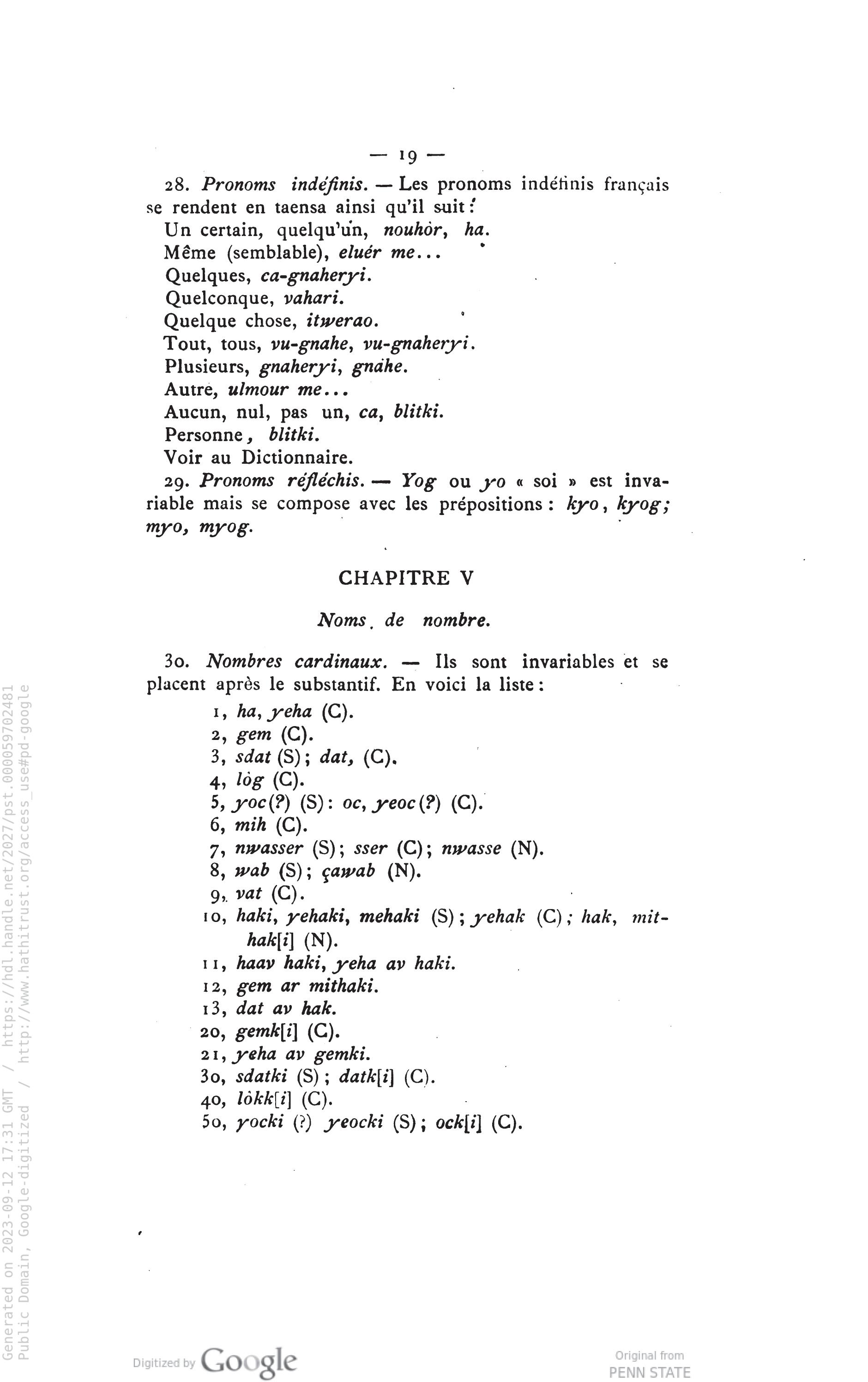
The provenance is terrible, Brinton points out. Why was this Spanish monk who allegedly composed the original manuscript effectively “going rogue” and evangelizing in what we know to have been a French mission field? Why do no French accounts mention this Spaniard wandering around? And why is his Spanish bad? When Parisot was later pressed to provide the original manuscript, he would claim to have lost it—and that no, it was actually in French, and probably left at his grandfather’s boardinghouse by a traveler.
Brinton also argues that the grammar of Taensa itself is not much more credible—it is certainly
possible that the language could have certain grammatical features seldom, if ever, seen in the indigenous languages of North America—even several of them. But it is unlikely and not convincingly explained.
Finally, the texts describe a Louisiana full of sugar maples, oxen, and bananas, among other improbable flora, fauna, and customs—complete with snowy winters. “It may be urged that these are all mistranslations of misunderstood native words,” Brinton poses. “To this I reply, ‘what sort of editing is that which not only could commit such unpardonable blunders, but send them forth to the scientific world without a hint that they do not pretend to be anything more than guesses?’”
Brinton’s thesis is that Parisot picked the name of a relatively obscure Native group from a map, then built a fictional language as a prank; when it caught on, he realized they could make a little money by leaning into the fraud. While some of the people taken in by the language continued to defend it, fueling an existing tension between French and American scholars of American languages, the general consensus has been close to Brinton’s thesis: Taensa was the Elvish of exoticism, the Klingon of colonialism.
The Taensa people did exist, though. They lived, at least for a time, in the general area of Tensas Parish, where in the early 18th century French missionaries met them. In 1908, the linguist John Swanton would use accounts written by these missionaries to publish his own refutation of Parisot’s Taensa. Swanton points out that the missionaries planned to consolidate their missions to the Taensa and the Natchez into one—an unnecessary complication if the two tribes spoke unrelated tongues. In fact, by all indications, the Taensa, Natchez, and French missionaries were able to communicate relatively easily, and the missionaries record the cultural affinity between the Taensa and the Natchez (even though the groups were at war at the time). For Swanton, the fact that the Natchez and the Taensa were so similar and do not seem
to have needed to resort to Mobilian, the lingua franca among most central Gulf tribes, indicated the languages were similar or the same.
As more Europeans arrived, Native groups rearranged their relationships to resist or accommodate them, and the Taensa people pinballed around the southeast, accepting Bayougoula hospitality before turning on their hosts, taking refuge near Mobile and then leaving when it came under British control, and ultimately moving back into modern Louisiana. After many ructions, the Taensa broadly assimilated into Chitimacha settlements, no longer with a distinct territory but maintaining an identity and language until sometime around 1900. (They are not the same as the Avoyel-Taensa, who are related to tribes of the Ohio Valley.) Swanton recounts his own attempt, during a 1907 visit to Charenton, to persuade an older Chitimacha woman whose father had identified as Taensa to share some of the Taensa language, but suffering memory loss and not having used the language in many years, she was unable. (There is, of course, always the possibility that for her own reasons she simply didn’t wish to.)



Perhaps ironically, if the Taensa were Natchez speakers, they did indeed speak a language that has intrigued scholars. Natchez is a language isolate, meaning it has no clear relationship to any other language: it’s part of a cluster of unique languages in the central Gulf that have bedeviled linguists’ efforts to categorize them. Natchez has the complex verbs common in American languages—if the verbal endings in French intimidate you, know that Natchez verbs can take several suffixes and several prefixes for an action-packed action-word juggernaut— and a special “cannibal speech,” used when telling stories involving the cannibal characters common in Natchez lore. A Taensa language that shared traits like these would have delighted researchers and armchair linguists on its own merits. However, Parisot’s Taensa has itself continued to attract attention. Usually, someone reexamines it and dismisses it again as a hoax, but the Australian linguist Claire Bowern has looked with a provisionally open mind. Harvard-educated and now at Yale, Bowern has primarily worked on language change and documentation in the Aboriginal languages of Australia, but when she was invited to give the prestigious Whatmough lecture for the Harvard linguistics department, she turned to Parisot’s Taensa.

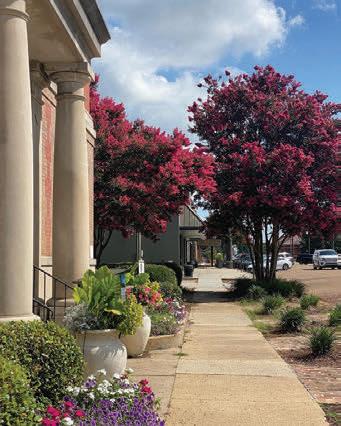
Bowern takes issue with Brinton’s glib dismissal of the possibility of a language with grammatical features as described in Parisot’s Taensa. To take one relatively straightforward example, Brinton raised issue with the “three plurals” used in Parisot’s Taensa, which for Bowern, could simply be variations in a pattern that changes depending on the word made plural—“utterly standard for languages the world over.” (Think cats, ba-
bies, fishes, oxen.) She goes on to point out that maples are found in parts of northern Louisiana and that icy winters do on occasion happen there. The relevance of the “exotic” fauna depends on when the texts were collected, she said: Native groups had their own trade networks and participated in those the Europeans established—the Taensa might indeed have had bananas and potatoes, or at least words for them, later in their existence. Could the Taensa word for “polar bear” be a misreading for some other term—maybe a pale or shiny-coated black bear? She also points out that multilingualism was extremely common among Native groups in what became the southeastern and south-central United States: “the Taensa spoke Natchez” is not the same proposition as “the Taensa spoke only Natchez.”
Bowern also fills in more of Parisot’s personal history. The seminary student went on to work as a linguist in the Ottoman Empire—he was there studying Syriac when Brinton fired off his cannonade. But at least at the time he published on Taensa, he was not very good. Bowern described the work on Taensa, if genuine, as deserving a B minus or a C plus, with inconsistent and incomplete points and labeling any verb with a complex pattern as “irregular”. Parisot also fails, in both the original work and any subsequent defense, to note the existence of possible cognate words between Taensa and the Timucuan language of Florida and Georgia. As Bowern notes—if he had intentionally used those cognates to make the hoax credible, he would have been able to point to them as evidence of the language’s legitimacy. As for the other “exotic features” of Taensa—would a middling linguist, familiar only with European languages, be able to come up with these features that actually occur in some world languages?
For Bowern, it’s easier to explain the existing Taensa corpus as the work of a very young man who didn’t know what he had and didn’t know what to do with it. (She uses phrases like “doing a poor job on challenging material,” a description I have repeatedly feared would apply to the present article). She hasn’t proven Parisot’s honesty or the existence of a separate Taensa language, but she certainly creates reasonable doubt. It would be good to believe that the nearly forgotten language of an assimilated tribe found an imperfect champion in a French seminary student. So many of the world’s languages exist in fragmentary forms that don’t offer linguists or descendant communities much to work with: wax cylinders, weathered carvings, personal names. We can see where a language was, but just a shadow. If the much-mocked Taensa record is real, it is sacred, a last whisper of a way of life, a way of thought, and Parisot deserves praise for amplifying this last utterance—before he lost the damn manuscript. •


60 WHERE TO FIND THE FRESHEST FISH IN NEW ORLEANS // 62 IN A CELEBRATION OF MEXICAN CUISINE USING LOUISIANA INGREDIENTS, CHEF GABRIEL BALDERAS TAKES FARM-T0-TABLE FURTHER

AT NEW ORLEANS'S GW FINS, CHEF MICHAEL NELSON HAS MASTERED THE ART OF FISH BUTCHERY & DRY AGING. Story by Beth D'Addono • Photos by Cheryl Gerber
When GW Fins opened in 2001 in the French Quarter, founders Tenney Flynn and Gary Wollerman wanted a white tablecloth restaurant that treated seafood like steak. The pair had worked together at the Ruth’s Chris Steakhouse chain and felt that seafood wasn’t given the fine dining respect that prime beef commanded.

Chef Michael Nelson, who became the restaurant’s sous chef in 2005 and executive chef in 2016, took that vision and ran with it.
Nelson, a native of Chicago who attended culinary school in the Napa Valley, finds tuna tastier and more exciting than any Wagyu steak. He made it his mission to intensify the umami flavor of the fish at GW Fins, but how? He had a theory: Perhaps dry aging—a technique typically performed on beef or pork in which the meat is placed in a controlled, open-air environment that pulls out moisture and breaks down muscle—
could have a similar effect on primal cuts of fish.
“The Japanese have been doing this for centuries,” said Nelson. “The best sushi guys have always known that fresh fish doesn’t have the deepest flavor. They’ll wrap a just-caught fish in kombu (edible kelp) and give it two or three days for the flavor to develop.” When the proteins start to break down, that’s where the flavor comes in, he explained. Dry aging allows the flavors to concentrate while allowing the moisture to escape.
Nelson started experimenting with aging during the early days of the pandemic, when the restaurant was closed for dining and only doing to-go. He had dry aging lockers adapted for primal cuts of fish, programmed to keep the temperature below freezing, about twenty-nine degrees, and at a specific humidity level, while the air inside was circulated through UV light. Every five minutes the temperature and humidity would be monitored. If anything should go wrong, Nelson received an alarm on his phone,
day or night. “There was a lot of trial and error,” he said. But ultimately, his efforts were rewarded. He quickly discovered that the process radically improved the texture and flavor of his fish, creating a new kind of seafood umami.
The key, said the chef, is starting with the freshest fish, caught in the past twenty-four hours or so.
Beef is dry-aged for a minimum of three weeks after processing. The sweet spot Nelson landed on for a 150-pound slab of blue fin tuna is about two weeks. Swordfish ages best in nine or ten days. But even just a few days in the case renders skin crisp, sans the usual amount of moisture. “A good example is golden tile fish,” said the chef. “The skin is normally inedible, too thick to eat. Dry aged for four or five days, it puffs up like a cracklin’—delicious.”
The combination of butchering whole fish in-house, which Nelson’s been doing for more than a decade, and dry aging allows him to buy a lot more fish and serve it over a longer period of time. Nelson,

a nationally recognized expert on Gulf seafood, has reduced food waste at his restaurant dramatically.
“I realized that only twenty-three to forty-five percent of a fish was being used [at GW Fins]. The rest was going into the garbage. It would be like cutting the breasts off a chicken and throwing the rest away.” Although it takes more space, time, and manpower to break down an entire fish, the result—to Nelson—is worth it, from culinary, economic, and sustainability standpoints alike.
Butchering allows the chef to utilize less-traditional parts of the fish, like the flavorful belly or the collar around the neck and throat. This raises the yield as high as sixty percent for a single red snapper. “That’s forty percent more than we were getting,” he said. His tempura fried fish “wings,” served with a sweet spicy Korean glaze, are a case in point: tender white meat with a fin “handle” that utilizes what used to be waste. “We take the wings off every fish that we can— drum, sheepshead, red snapper. It’s one of our
most popular menu items.”
The goal, always, is honoring the fish by using as much of it as possible. “I felt that the word 'sustainable' was losing its meaning, so I go with our own definition,” said Nelson. “To us, true sustainability is taking our capital and supporting people as directly as possible to sustain them in their efforts to do what they’re doing, when they’re doing it right. And we pay them well, to make sure they keep doing it. It’s not about a green sticker on a box.”
Another of Nelson’s projects is swapping seafood out for the usual cured meats on charcuterie platters, think seacuterie, made from every part of the 7001000 pounds of fish that’s butchered inhouse at GW Fins daily.

“Because we get so much fish in all at once, there might be forty or fifty pounds of scraps,” Nelson said. His team has discovered that, with no changes in a recipe at all, they can swap pork out for swordfish to make andouille and smoked sausage, mortadella and bacon. Even the skin, such as that on the Golden Tile fish, is transformed into crispy fish cracklins’.
“This is exciting for people who don’t eat pork,” he said. “Also, because we swap out saturated fats with Omega three fatty acids, there’s zero guilt. We’re still working to get the program to the next level.”
At GW Fins, Nelson writes the menu by 4 pm every day, ensuring that there’s always something new and different to entice his strong community of regulars.
Because he works so closely with legions of spear fishermen, it’s not unusual for a fisherman to knock on the back door and deliver a just-speared cobia and a couple of barracudas.
“This is a way to support the fishermen directly,” he said. He has developed strong relationships with local fishermen who specialize in spearing their catch and know exactly what he is looking for—even going so far as calling him to get his “order” before they embark on their trips.
“It’s like they are asking me for a shopping list before they go out on the water,” he said. “They know where certain species of fish hang out, and they go get them and bring them to me that day or the next. This is the ultimate way to source seafood.”
Some varieties of fish Nelson has been able to secure for his daily changing menu include triple tail, cobia, black fin tuna, and sheepshead. “When there’s a rodeo, like the annual lionfish rodeo, the word is out. Those guys know who will buy it.”
“Most of what we serve is from Louisi ana,” said the chef. “The only state that has more tuna and swordfish than we do is Hawaii, and only Alaska produces more pounds of seafood than Louisiana. We really have it all here.”

By bringing the fishermen into the conversation, the team at GW Fins pos sesses a deeper knowledge about the fish they are serving than ever before. Before
the fish lands on the customer’s plate, Nelson knows where it was swimming, when it was speared, and which dock checked it in. He logs when the fish is butchered and when it starts the aging process.
Regulars in the know have the zeal of the converted, hungry for the taste of that aged tuna tomahawk rib eye. Simply wood-grilled, the perfectly medium rare tuna is fork-tender, but dense with meaty flavor, finished with a drizzle of black garlic bearnaise and Nelson’s housemade Worcestershire sauce.
Although he can’t always guarantee a slab of aged tuna on the bone, fanatics for

the Wagyu of the sea can count on the full moon, which determines when many of the boats go out. “If you follow the lunar calendar, count two weeks from the full moon and you’ll be in prime time.”
Besides being sustainable, butchering the whole fish and aging primal cuts is profitable, a fact Nelson’s trying to use to ultimately influence how seafood is processed. “Once they understand there’s money in it, things will start to change,” he said. “We’re missing out on the best parts of all this fish. My regular customers don’t even want a filet anymore.” • gwfins.com


Soft-spoken and humble, with a youthful face that belies his twenty-five-year career in restaurant kitchens, Gabriel Balderas is the 42-year-old chef and co-owner of two of Shreveport’s most popular restaurants. With his wife and business partner, Brooke, Gabriel opened El Cabo Verde, a modern Mexican cantina with a locavore-friendly menu, in 2016. Building upon the success of El
Cabo Verde, the duo launched a sustainable seafood restaurant, Zuzul Coastal Cuisine, in 2019. Both restaurants celebrate locally-sourced ingredients while challenging guests’ perceptions of Mexican cuisine. This past summer, the Balderases announced the establishment of Nourishing Farms, their own seven-acre farmstead, which started providing organic, heirloom fruits and vegetables to both restaurants in May.
“Today we harvested corn, okra, tomatoes, cucumbers, and melons,” Gabriel said during an interview in mid-July. “The things that we harvest at the farm are being incorporated immediately into our menu. It’s amazing, the flavor and the freshness we’re getting.”
At El Cabo Verde, Gabriel’s healthier versions of popular Mexican staples have attracted an enthusiastic following. Dishes like sweet potato enchiladas—regional
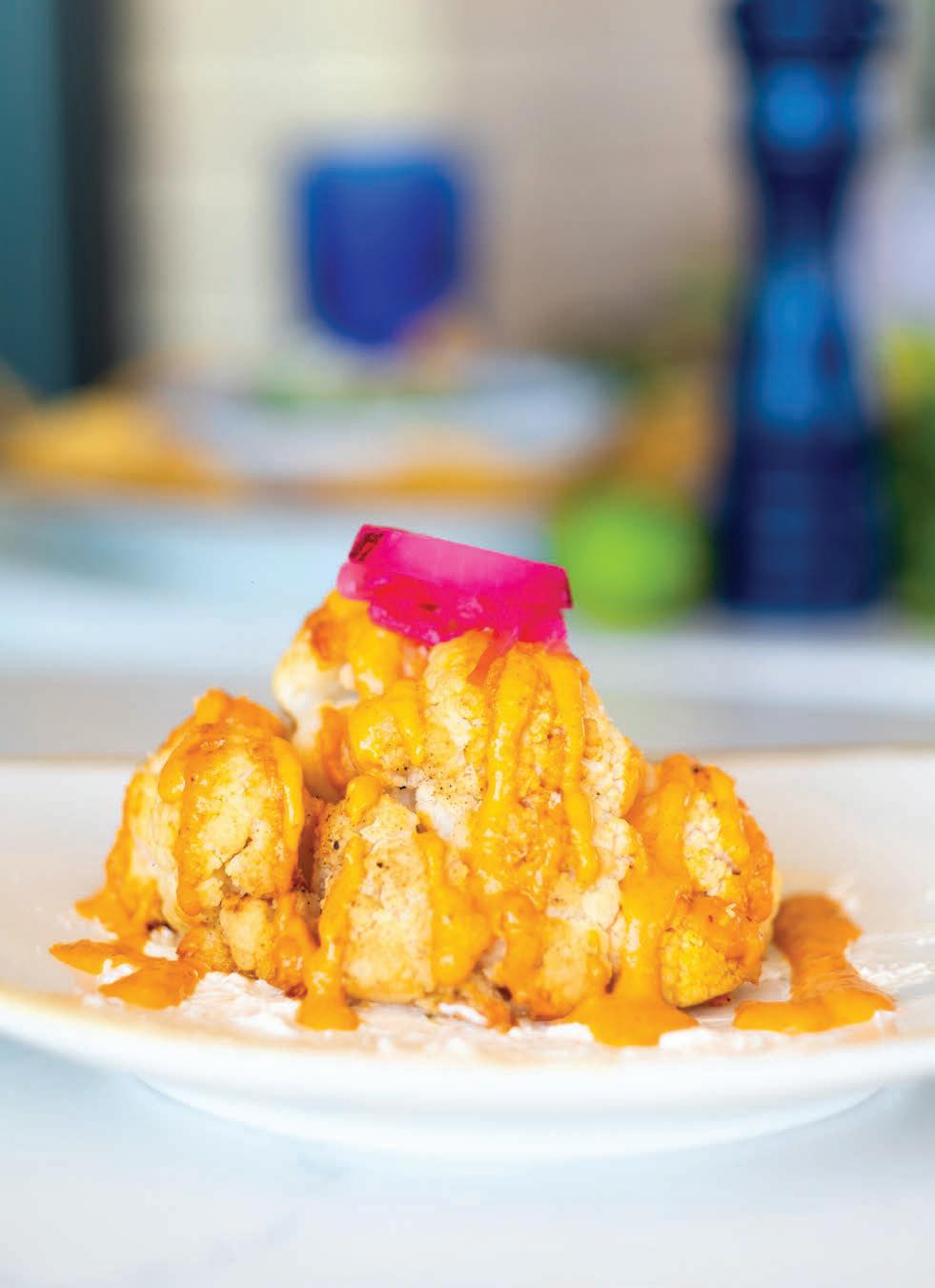
sweet potatoes wrapped in heirloom corn tortillas and topped with tomatillo salsa, queso fresco, and fresh crema—deliver the carnal pleasures of Mexican food without using processed ingredients. Shrimp tacos combine the sweetness of fresh Gulf shrimp, the piquancy of chipotle aioli, and the cooling creaminess of avocado. At its best, Gabriel’s food is like this: accessible, nutritious, and so delicious that guests don’t realize they’ve

eaten a healthy meal until the plates have been cleared. Gabriel is especially proud of El Cabo Verde’s excellent mole negro Oaxaqueno, a dish inspired by his childhood home of Oaxaca, Mexico.
“The concept of El Cabo Verde is a Mexican concept, but our mole is specifically a tribute to Oaxaca, where there are hundreds of different moles,” he said. “We make our mole negro the way it’s made in Oaxaca, with tomatoes, tomatillos, plantains, and chocolate.”
Gabriel immigrated to the U.S. from Mexico when he was sixteen years old and has worked in professional kitchens ever since. His journey as a professional cook included a life-changing stint at the acclaimed Hot & Hot Fish Club in Birmingham, Alabama, where Gabriel cooked alongside James Beard Award-winning chef Chris Hastings in the early 2000s. Hastings’s careful sourcing of ingredients from small, local farms made a lasting impression on the younger cook.
Birmingham was also where Gabriel met Brooke. When the newly married couple moved to Shreveport in 2008, Gabriel noticed that most farms in northwestern Louisiana grew commodity crops like soybeans and corn. Since that time, smaller local farms including Mahaffey Farms, Sample Farms, and Smith Family Farms have grown into major operations providing local, pasture-raised beef, pork, and chicken to farmers’ markets, restaurants, and grocers. Gabriel takes pride in the fact that his restaurants have helped local farmers to gain a foothold in the wholesale market and to grow.

“When we moved here, this part of the country didn’t have many farmers,” Gabriel said. “My goal is for Shreveport and North Louisiana to grow food for human consumption, not just for commodities. The reality is that we need more people growing food.”
Gabriel’s efforts to promote local farms attracted the attention of Slow Food USA, an organization founded in 2000 to prevent the disappearance of local food cultures and traditions. He currently serves as a member of the committee that governs the Southeastern U.S. division of the Slow Food Chefs’ Alliance, a global network of more than 1,200 chefs. His activism related to food, as well as his role as the co-founder of a local nonprofit, NWLA RASA, have forced Gabriel to overcome shyness and accept his role as a public figure.
“Growing up in restaurant kitchens, I was always the one who wanted to stay back in the kitchen and not to talk to anybody,” Gabriel said. “Brooke was always the opposite. I’m more comfortable now, but it took a lot of years for me to reach this point.”
Where El Cabo Verde spotlights local farms and the hard work of small farmers, Zuzul Coastal Cuisine seeks to do the same for small and endangered fisheries. Gabriel’s Mexican heritage peeks through in a few places on the Zuzul menu—the beautifully plated, chorizo-stuffed grilled octopus, for example, or the yellowfin tuna tostada—but much of the menu depends upon the seasonal availability of high-quality seafood, which can change from one day to the next. A last-minute phone call from a purveyor with a fresh haul of fatty crabs or great-looking sockeye salmon could send Gabriel and his team scrambling to redesign the evening’s specials.
In addition to the impromptu nature of the menu, Zuzul differs from El Cabo Verde in its emphasis on craft cocktails. Star bartender Paul Loggins, who has overseen Zuzul’s bar program since opening, has made the tiny, five-seat bar at Zuzul one of the most enjoyable places to dine in North Louisiana. Loggins seems to have accepted the Balderases’ enthusiasm for local ingredients as a personal challenge to concoct surprising and delicious libations using the same seasonal approach that drives the food menu.
El Cabo Verde and Zuzul have a “yin and yang” quality. They are clearly distinct concepts, but there is something very two-sides-of-the-same-coin about the Balderas restaurants. Brooke, who designed the striking interiors in each of them, aptly summarized how the two restaurants function as halves of a whole.
“We wanted Zuzul to feel light and airy,” she said. “To me, El Cabo Verde represents the land, the earth, the farm, and Zuzul represents the sea, the air, the water.”
In a way, El Cabo Verde and Zuzul Cuisine reflect the personalities of Gabriel and Brooke—individuals with different strengths who lift up one another, their community of purveyors, their employees, and their patrons.

“MY GOAL IS FOR SHREVEPORT AND NORTH LOUISIANA TO GROW FOOD FOR HUMAN CONSUMPTION, NOT JUST FOR COMMODITIES. THE REALITY IS THAT WE NEED MORE PEOPLE GROWING FOOD.”
FROM OUR BOOKSHELF
FROM ALIENS TO ART FORGERS TO ROUGAROUS, SOUTHERN LITERATURE IS LEANING INTO MYTHS AND LEGENDS, TOO
Story by Alexandra Kennon
Here at Country Roads, we revel in the mystery and wonder that our October Myths & Legends issue brings. Sometimes that means delving into the South’s dark tapestry of folklore, and sometimes it means unpacking stories of unexplainable encounters or true crime close enough to home to send a chill down one’s spine.
So, we were thrilled to discover the recent release of three new books that will keep fellow intrigue-hunters turning pages, uncovering some of the Gulf South’s strangest and most captivating stories.

As aficionados of nerd culture know well, open-source roleplaying games present infinite potential for imagination, from the comfort of your very own living room. In traditional Dungeons and Dragons, for instance, you can transform into a wizard, a warlock, a sorcerer, or a druid, and promptly enter a new world. But what if an open-source tabletop game allowed players to roleplay as a rougarou? Or the Honey Island Swamp Monster? Or even the Axeman of New Orleans?
A new book from illustrator Alexis Braud and author Candice Huber is changing the game—presenting twenty of Louisiana’s creepiest and strangest folkloric figures, cryptids, and mythologized historical personalities alongside illustrations, descriptions, and statistics so they can be incorporated into Evil Hat Productions’ already-established Fate Core open-source game system. “I mean, I'm an old school nerd,” Braud explained. “I've been gaming since high school. And I love folklore. It was a great place to put a lot of knowledge.”


Late in 2019, Braud had a book signing for a previous project at Huber’s shop Tubby & Coo’s—a traveling, queer-owned bookstore in New Orleans. By the time the evening was over, they had plans to create a Louisiana monster manual for gaming together, at Huber’s suggestion. “And that idea hooked in my brain,” Braud told me.
It was deeply embedded enough that, a few months later, when the world shut down and art markets and festivals ceased operating, Braud got to work illustrating Louisiana’s mythical creatures. With much of the concept work accomplished, Braud approached Huber again. “Like, ‘hey, so I'm this weird author you met that one time and you only ever spoke to me once, and I've been working on this project for a year. Are you still in?’” Huber was, and now the fully fleshed-out gaming manual—including background information on the legends,
vibrant illustrations, and detailed information on gameplay is available via Tubby & Coo’s, as well as through most major booksellers nationally.


And while Carnival of Creatures was published with gameplay in mind, its author and illustrator took their folkloric research seriously—drawing heavily from resources like the Bary Ancelet collection at the Center for Louisiana Studies and materials made available through the Historic New Orleans Collection.
“That’s what I really want to do with these books, is get our stories, get Cajun stories, get Louisiana folklore, into the hands of people that aren't just into folklore—they're nerds. And nerds latching onto something gives it a vigor, and a life force, and an impetus, and a gravity that will put people in styrofoam pants on their days off, dressed up like a robot,” Braud laughed. “I want nerds to love Cajun culture as much as I do. I want them to nerd out on zydeco music and boudin, and the language and our stories and our folklore … it's not just a book. The people who are really passionate about stories, which is what a lot of the gaming community and the fantasy community is—I'm giving them our stories to play with.” tubbyandcoos.com.

In February 2010, a newspaper landed on Teresa Tumminello Brader’s doorstep—her uncle’s name splashed across the headlines: William Toye was being federally indicted for forging paintings he was passing off as those of Louisiana folk artist Clementine Hunter. “My uncle was certainly a legend in his own mind,” Brader said. “That is absolutely how he thought of himself.”
Brader was twelve years old in 1974, when her Uncle Bill was first charged for his Hunter counterfeits, and it would be almost forty years, when he was caught again, before she’d learn of her family’s best-kept secret, straight from the local newspaper.
“When we were growing up, the 1974 arrest was kept from us. And looking back, I can see why my mom was like, ‘This goes into the category of things we don't talk about.’ Because it's shameful. It's a crime,” Brader said. “So when we did find out about the secret, we're like, ‘what?!’ You know, secrets like that are gonna come out. And I guess my mom hoped that it wouldn't. But in the meantime, we could have dealt with it. We could have experienced it as a family…I mean, I could have done without the shock, when I discovered it.”
In her new memoir Letting in Air and Light, Brader attempts to sort through her memories of her uncle William Toye, who occupied one half of a double shotgun house in New Orleans’s Riverbend neighborhood with his wife Beryl, while Brader’s grandparents occupied the other half. Over the years, many outlets, including Country Roads, reported on FBI agent Randy Deaton’s case against Toye—often including uncontextualized details about the man, describing him as a hoarder with a home filled with cats. Brader realized much of the story——Toye’s family history, his squandered brilliance, and his struggles with mental illness—were left out.
“That was the one thing that stood out to me is that there was no perspective from family members—not to say that they needed that. And maybe he didn't deserve that,” Brader said. “But I thought it was something
that I could delve into, because I knew my grandparents more than these people writing who mentioned them… And I knew some of these family stories, or even my own interactions with him, that fueled some of his delusions.’”

In Letting in Air and Light, Brader switches perspective from chapter to chapter, alternating between her own memories of her childhood and her eventual grappling with this case much later; and imagined fictionalized vignettes from Toye’s childhood, pieced together by Brader’s imagination but adhering closely to family anecdotes, newspaper articles, and other details she was able to glean over the years. “...I needed both memoir and fiction, to get at the truth, as I know it,” Brader writes in her preface. “After reading more and more details of Uncle Bill’s crimes, I decided there was no point in overly fictionalizing his story. The facts are too sensational on their own.”
Brader’s memoir brings the reader full-circle, to when Deaton hands her one of her uncle’s Hunter forgeries at a talk about the case at the Hilliard Museum in Lafayette, not knowing her relation. Brader writes of her own anxiety, though she committed no crime, in that moment, lamenting that “[Toye and his wife’s] deplorable legacy will, to some degree, run alongside the brilliant legacy of Clementine Hunter.”
In writing this book, Brader makes a concentrated effort to honor Hunter’s legacy, while sorting through her own family trauma and projected shame in a way that she found healing. She said she hopes others can draw inspiration from her expression of working through her family’s secrets, too. “I feel like stories can heal. Well, at least to certain extents. They can't heal everything,” said Brader. “I feel like I healed myself maybe a little bit, by the time I'd finished writing.” bellepointpress.com.

October Market & Food Trucks | 10/1
Donaldsonville Arts, Crafts & Farmers Market | 10/7

St. Mark’s Fall Festival Market | 10/20 - 10/21
Boucherie & Balloon Festival | 10/20 - 10/22
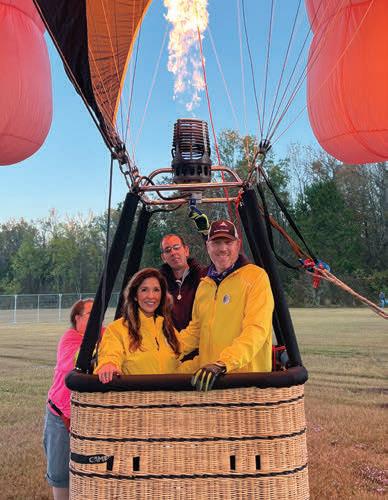
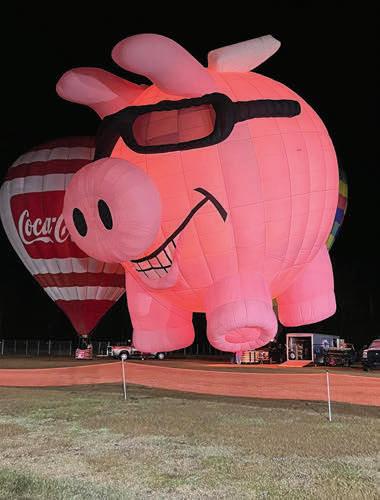

La Fete des Bayous Festival | 10/26 - 10/29
Witches Walk Ladies Luncheon | 10/28
New Song Community Fall Festival | 10/28
A Louisiana Saturday Night Concert | 10/28

Merry Market | 11/11 - 11/12
Scan to view our full calendar of events!


It’s difficult to imagine what might make an esteemed physiologist in Ohio and a prominent UFO researcher and publisher in the North of England both take such keen interest in Pascagoula, Mississippi. But Philip Mantle and Dr. Irena Scott’s new book Beyond Reasonable Doubt: The Pascagoula Alien Abduction delves deep into the ongoing case of the alleged Pascagoula abduction of 1973—when fifty years ago this month, Charles Hickson and Calvin Parker, two shipyard workers, reported being taken aboard a floating ship and examined by strange creatures before being dropped back where they had been fishing on the Pascagoula River.
There are many reasons why this case has captivated those like Mantle and Scott, who have devoted their lives to researching UFOs and other extraterrestrial phenomena. There is the fact that within hours of the alleged abduction, both Hickson and Parker were in the Jackson County Sheriff’s Office being separately interviewed and then secretly recorded together (and the fact that while the officers expected the secret recording to include the men laughing and joking about a made-up incident behind closed doors, what they captured instead was genuine terror). The following day, the two men were interviewed at Keesler Air Force Base, and checked for radiation—and in that interview, which was recorded by a stenographer and remains on-record, the men’s stories aligned exactly with what they’d told the sheriff’s office the day prior. Then, under hypnosis each man separately recalled the ordeal of strange creatures bringing them aboard a ship in vivid detail.
But perhaps the biggest factor to set this case apart from other well-known alleged alien abductions is the plethora of witnesses who have emerged, testifying that they, too, saw a strange flying ship—or even something more—around the Pascagoula River on the night of October 11, 1973. Beyond Reasonable Doubt: The Pascagoula Alien Abduction focuses on these witness testimonies, many of whom have stepped forward in recent years, initially hesitant to be associated with the event fifty years ago.
One of the most striking is a couple, the Blairs, who were in their parked Pontiac across the river at the time of the Parker-Hickson abduction. After an interview with Calvin Parker appeared on FOX 10 News in 2018, their daughter left a YouTube comment, saying that her mother had fearfully told her children on several occasions about seeing the strange ship that night—and even the not-quite-human creatures in and near the water. Her husband Jerry had insisted for decades that he did not see what she saw, and urged her not to say anything for fear of being labeled insane.
Then, in September of 2019, after a long period of hospitalization and with his heart only functioning at 15%, Jerry confessed to his wife that he, too, had seen the unexplainable ship and gray creatures, which he had previously denied to avoid public ridicule. He recorded a video admitting what he’d seen, and requested to speak with Mantle, who promptly conducted an interview.
The book also delves into the unexplained gap in time between when the Blairs approached the water and returned to their car from 9 pm until midnight, though they did not believe it had been nearly three hours—positing that perhaps the Blairs experienced an abduction, as well. These aspects of the book and others will be intriguing and chilling for some, and will induce raised eyebrows for others, especially given Mantle and Scott’s approach of simply presenting information and accounts through as unbiased a lens as possible. “Make of it what you will,” Mantle told me, “We’re just presented the evidence that we have, and you can draw your own conclusions from it.”
This confession from the Blairs is one of many witness testimonies and new pieces of evidence presented in Beyond Reasonable Doubt —the title of which was inspired by a courtroom drama Mantle watched from his home in West Yorkshire. “We were convinced, if we were able to take all of that data to court, all of that evidence, we could prove beyond reasonable doubt that something extraordinary happened that night.”
Calvin Parker, who spoke with the writer of this piece for a 2021 Country Roads story about the encounter, and lived a quiet life with his wife Waynette despite being regularly hounded by journalists, recently passed away on August 24, 2023. “I'm glad he lived long enough to see the subject of UFOs being taken seriously, because that just happened very recently,” said Dr. Scott.. “And I'm sure it's helped him a lot, because he kept quiet for about fifty years, on account of harassment and that sort of thing.”
Before Parker passed, he wrote a foreword to Beyond Reasonable Doubt, expressing his gratitude to Mantle for encouraging him to tell his story and write his own book, as well as to the many witnesses who have gone on the record about their own sightings surrounding his and Hickson’s reported abduction, which he found vindicating after undergoing years of harassment and ridicule for his own reports. “There simply isn’t another case like this. I feel honored to have known Calvin [Parker] and to be part of the telling of the story, part of revealing more information,” Mantle said. “Everything that Irena and I have obtained since then, it's just grown and grown and grown and grown, and continues to do so. It hasn't stopped.”
flyingdiskpress.blogspot.com. •
Igot lost. Again. Coasting on a dark stretch of Highway 182 through Franklin, in November 2020, I turned up a long driveway under a canopy of oak limbs before my headlights shone on the three-story, white-columned house—the Alice C. Plantation. Gaslights punctuated the front staircase leading to a wide porch, where my hosts Stephie and Gary Blum waved.
“So, Nina, what brings you down to Franklin during a worldwide pandemic?” Gary laughed.
Good question. I explained how the shutdown afforded me time to research my family history. So, that morning I had flown in from Dallas and spent the day driving through the “sugar parishes”—touring one relative’s historic plantation in Patterson, and walking land settled by other ancestors in the 1790s. (See Part III) But, I admitted, besides a successful first day, the rest of my trip might be fruitless, as I had few leads in the area and knew most places were closed. With that, Gary offered me exactly what I needed: a cocktail and the name of a local historian. My luck was running.
The next morning I watched the sun burn off mist over the Bayou Teche. Coffee cup in hand, I strolled the grassy lawn, passing a black cast iron sugar kettle. Skirting the bayou’s bank, I stepped onto a pier and leaned out, peering into the brown water, thrilled at the prospect of glimpsing an alligator.
Retrieving a small silver Virgin Mary medal from my pocket, I kissed it and threw it into the bayou to acknowledge the Teche’s place in my family history. The gesture was a nod to my deep French Catholic roots in Franklin Parish—from my grandmother, Bonnie May Walters Planchard, all the way back to my sixth great-grandmother Marie Francois Cellier dit Normand Mayeaux, who immigrated here from France in 1720. I also meant to honor my fourth greatgrandmother, Marie Adelaide Guerne de Tavane, whose mysterious story prompt-
ed my journey to Louisiana in the first place. (See Parts I and II)
Per my hosts’ tip, I called the Young-Sanders Center—a research library and Louisiana history museum operated by historian Roland R. Stansbury. Knowing the center was likely closed, I was surprised when Stansbury himself answered. However, he apologized that he couldn’t open the facility due to the pandemic.
“Of course, understandable,” I explained my interest in a few plantation land records and any history concerning two planter families in my line: the Charpantiers and the Roussels.
“Roussel? I knew a Roussel,” he said, noting the family’s foothold in sugarcane. “They go way back in the parish—related to founding families, like the Cornays. Yeah, so, that means you’re related to the Cornays. Ever hear of the
Battle of Fort Bisland?”
“No, but that’s the kind of information I’m looking for,” I replied.
He paused, “How soon can you get here?”
Ten minutes later, I met Stansbury at the corner of Commercial and Teche Streets, outside of an unremarkable one-story building that gave no indication of the treasures inside. Unlocking a series of gates and doors, he led me through a back entrance to an exhibit space with floor-to-ceiling bookshelves, and glass cases displaying Civil War-era muskets, pistols, uniforms, antebellum artifacts, Confederate money, and crumbling papers.
A gray-haired gentleman with an unbridled enthusiasm for local history, Stansbury proudly showed off the prized collection, hidden too long from public view. Not only had the pandemic shuttered the doors, but an economic slowdown had kept the facility in mothballs for about two years. Stansbury easily located relevant books, flipping to passages about Judge Cornay, his sugarcane plantation, and the role Cornay Bridge played in the Battle of Fort Bisland, 1863, when Union troops defeated the Confederates. An excerpt from "General Mouton's Regiment, the 18th Louisiana Infantry" states, “The intermittent firing continued until 4 o’clock when a furious artillery duel commenced by the two contending forces. Cornay, with St. Mary's Artillery, maddened at the sight of the enemy standing upon his own homestead with their batteries planted upon the playground of his children, sent forth shell after shell, filling the air with their peculiar and indescribable music."
I confessed I wasn’t a Civil War buff, and my focus had been on my family’s sugarcane plantations, primarily owned by my Charpantier ancestors, whose identity in France had me stumped. I didn’t expect to find clues in South Louisiana about their lives in France, but I hoped to learn what became of them after settling in the Attakapas area where

they established a plantation. “I haven’t found much information, but I ran across this old sugarcane trade journal by a guy named P.A. Champomier,” I said, botching the pronunciation. “Heard of him?”
At the mention of Champomier, Stansbury’s eyebrows lifted above his mask. “Well, I’ll be damned.” Turns out Stansbury had published a study of Champomier’s obscure sugar report several years before. Judging by his reaction, few have acknowledged the work of this French immigrant who almost single-handedly chronicled Louisiana’s foray into sugarcane.
Here we were, two history nerds from different generations, crossing paths during a pandemic at a closed-down museum in South Louisiana, discovering a shared fascination with a little-known chronicler of the antebellum sugar trade. “Call me nuts,” I confided, “but this isn’t the first time my ancestors have pulled strings to help me with my project.” He didn’t argue the point and commenced loading my flash drive with his 100-page paper: “Statement of Sugar Made in Louisiana, 1844, 1845-1846.”
I noted that Champomier’s dry statistics, jotted between ledger columns, had been the closest I had come to stepping onto my ancestors’ land—that is, up until the day before when I walked their former plantation. After I described pinpointing the property by comparing a Google map with a faded online map from 1810, Stansbury promptly slid open a wide drawer containing well-preserved maps from the National Archives. Among them was a rare South Louisiana map that backed up my theory about the location of the Charpantier land, owned today by the Hymel family.
“Yes!” I explained that Joseph M. Charpantier and his wife Marie Adelaide, my fourth great-grandparents, acquired the land fronting Bayou Teche around 1795, some fifteen years before the map was drawn. After fleeing the Palace of Versailles during the French Revolution, and/or the slave uprisings in Saint-Domingue’s sugar plantations, their well-timed immigration to Louisiana situated them in an economic sweet spot that sustained itself for decades.

I only learned about their sugarcane plantation from perusing the no-frills lists contained in Champomier’s obscure booklet. In it, he cataloged every sugar plantation, giving the amount of sugar each produced during the years 1844–62, from the wealthiest to those with just a few acres. Although the numbers indicated that my relatives’ plantation had fared well during that period, it was Stansbury, a preeminent scholar on Champomier’s work, who showed me how to use those statistics to find the bigger story, hidden in plain sight.
The drab ledger listing sugar farmers in each parish provides the geographic location of their plantation, the number of laborers (enslaved and otherwise), and how many “hogsheads” of sugar were burnt that year out of their total crop. (A hogshead roughly equals 1,000 pounds.) Beside the planters’ names, Champomier occasionally added an asterisk with personal observations, such as losses due to fire, flood, or drought. He concluded each report with an overview of the state’s sugar production—crop fluctuations due to hurricanes, disease, pests, and floods from rivers, or “crevasses” (from the French word crever, which means 'to burst'). Although he set out to provide nothing more than a statistical report, Champomier’s ledger reveals multi-layered, poignant glimpses into old Louisiana for anyone who takes a closer look.
It's not clear what prompted the French-born New Orleans commodities merchant to begin compiling these reports, but his work became revered by local planters as well as national and international traders with an eye on the country’s most valuable agricultural segment—sugarcane. And his was the only close-up, methodical, yet personal, report of its kind.
Champomier’s annual survey took three months to conduct. Leaving his Vieux Carre residence, he boarded La Belle Creole, a luxury steamboat that traveled up and down the Mississippi, docking at each sugarcane plantation, where workers layed out long gangplanks to allow him to cross the muddy banks. Other days, he traveled on horseback through rural, often marshy land, conversing with each sugar planter, taking down details of their operations, observing the crops, mills, and laborers.

Having visited the former Charpantier land the day before, I could envision his horse trotting up the road, a cloud of dirt trailing behind as he hitched the reigns to a post in front of the Charpantier’s house. Tromping through rows of towering, green cane stalks rustling in the breeze, “le vieux Champomier,” as everyone called him, scribbled observations in a journal, which he published every spring.
Because the first report came out in 1844, eight years after Joseph Charpentier died, the plantation is listed under the direction of his only son, Charles Michel Charpantier. Charles produced thirteen children with his wife Clarisse Verret. The first “Sugar Crop” places the property fifteen miles south of Franklin with 109 hands (mostly enslaved laborers) working the land. That year they brought in 128 hogsheads (128,000 pounds) of sugar, just above average compared to other producers in the same parish.

In 1845, the report listed the Charpantier’s plantation with 180 hands, bringing in 205 hogsheads (205,000 pounds), also above average.
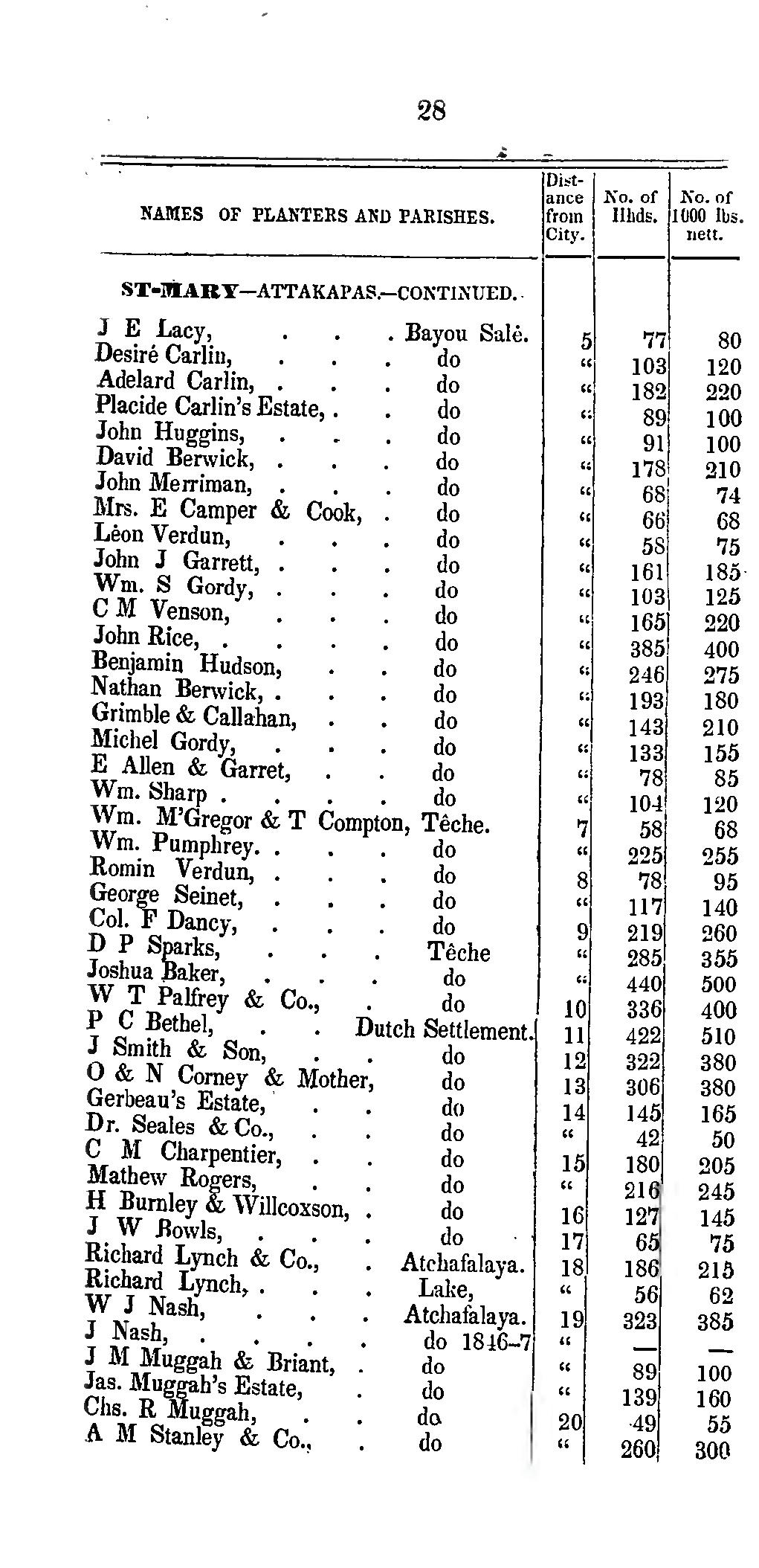
Champomier ordered his list by location, like the census, in succession from one plantation to the next. As such, it provided something rarely found in historic documents—a bird’s eye view of rural south Louisiana.
Scanning statistics, land details, and names, one can chart the location of each plantation, and who lived next to whom. Considering travel limitations across miles of sugarcane fields, it’s no surprise the offspring of planters tended to marry their neighbors or cousins, or conduct arranged marriages.
Tracing my relatives’ connection to each sugarcane plantation lining the river and bayous is tantamount to a genealogical breadcrumb trail. As marriages enjoined nearby plantations, my extended family spread throughout the “sugar parishes” like a fiefdom. The few names I started with in 2015 had exploded. Now my list of planter relatives included Trosclair, Carlin, Corney, Aime, Theriot, Haydel, Bringier, LeBlanc, Rillieux, Tregre, Choppin, Schexnayder, Becnel, Roman, Poirier, Waguespack, Hymel, Tureaud, Fortier, Brou, Tassin, Webers (Webre), Perret, Laurent, Marmillion, Labranche, Pouche, Trepagnier, Melancon, Darensbourg, Landry, Villere, Como, Daigle, Gaudet, Martin, Comeaux, Dugas, Boudreau, Perilloux, Toups, Thibodeaux, Burguiere, Olivier, Tarlton, Grevenberg, Provost, Broussard, Delahoussaye, Sigur, Fuselier, and more.

As French, Spanish, and German families merged, growing in wealth and influence, their extended families held political sway in the Attakapas region—the wealthiest sugar-growing land in Louisiana, producing more sugar than any other parish by a long shot. However, even the most lucrative yields couldn’t totally insulate privileged planter families from the harsh realities of their times.



In 1845, one of the most successful years for the Charpantier’s sugar crop, tragedy struck when their daughters, Nelia Josephine and Marie Aglae, died within a few months of each other. This kicked off a string of tragic illnesses in the family, as wave after wave of yellow fever spread throughout Louisiana and beyond.
The mysterious virus killed thousands across the Deep South from 1800 to 1900, but during the 1850s, yellow fever was particularly brutal. New Orleans felt the brunt. Epidemics cropped up every two or three years in the city, reaching a peak in 1853, when the city’s worst yellow fever outbreak claimed about 12,000 lives, roughly onetenth of the city’s population.
Amidst rampant finger-pointing and far-out conspiracy theories, most laid the blame on new immigrants, polluted water, or unsanitary conditions in the humid,
crowded city. However, rural areas also recorded dramatic death rates. Confusion, misinformation, and mystery around the causes and cures bred panic, controversy, and political division— much like the chaos swirling around the COVID-19 pandemic in 2020.
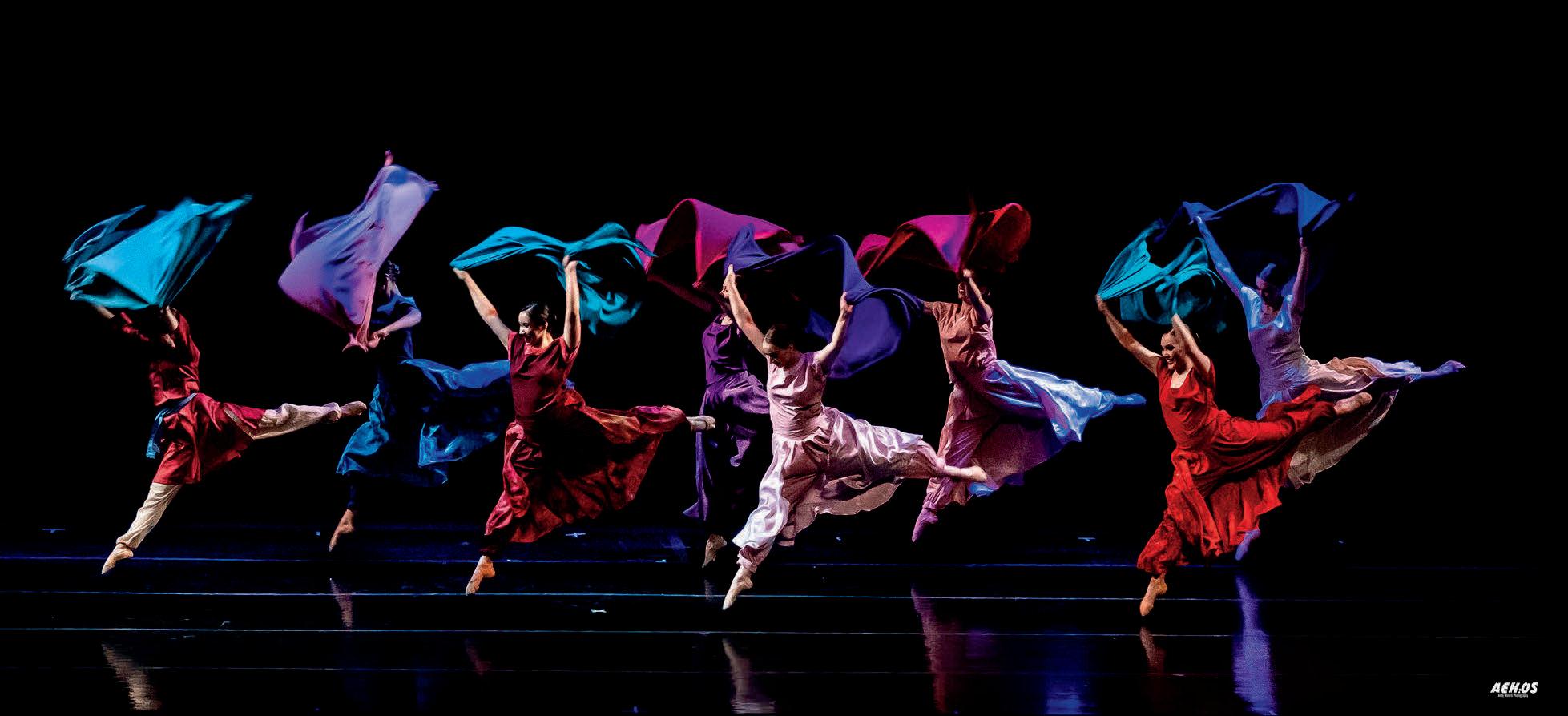







Yellow fever would hit the Charpantier family with staggering force in 1855, killing seven of the remaining ten family members that year. It claimed their patriarch, Charles (age sixty), and six of his children, all in one house.
Harrowing stories played out across the state, as evidenced in New Orleans newspapers, which posted yellow fever death statistics almost daily. It wasn’t until 1900 that researchers discerned the culprit— the common mosquito.
Champomier noted the devastating impact on planter families in the rural parishes, even as he routinely reported his sugar crop findings. Despite the personal losses of my relatives, the sugar report indicated their operations remained intact under the direction of Charles’s son, Joseph M. Charpantier, named for his grandfather. Their business thrived through 1862, the same year P.A. Champomier stopped publishing his findings—too dangerous, as the Civil War arrived in south Louisiana.
Champomier’s last report shows that the Charpantiers raked in their highest yield ever in the winter of 1862, with 382 hogsheads of sugar. That same spring, the Union army marched in and “ransacked
the region,” according to one document. Stansbury marveled at the odd convergence of glorious and devastating events in the cane fields: “Even as the fighting closed in around here, the 1862 harvest was the best on record.”




An unusually strong growing season in 1861 brought the record-breaking yield in 1862. Keeping one eye on the Civil War situation and another on their flourishing cane fields, Louisiana planters filled their mills to capacity that spring with sugar ready to be shipped to market. And as families in the north and south sent their sons off to fight in remote Virginia or Tennessee battlefields, Louisiana's cane planters brought in a bumper crop of 460,000 hogsheads—the largest the state had ever produced. It was the last sugar crop grown and harvested by slave labor.

Weeks later, when Union troops captured New Orleans, military blockades cut off river, ocean, and railroad routes, leaving planters scrambling to sell their bounty. Most efforts to sell off their sugar failed and the historic harvest of 1861-1862 turned into a financial bust.
“It was the crowning moment of Louisiana's antebellum sugar industry, but one that reflected a half-century of economic growth and labor exploitation in the cane fields,” wrote historian Richard Follett in, “Champomier, Statement of Sugar Made in Louisiana.”
Stansbury’s paper described Champomier as an “ardent confederate,” who






never weighed in on slavery or Southern nationalism in his reports. Even so, Champomier’s sympathy for the plantation owners' plight comes through in one of the last comments of his final report, noting that due to Union Army destruction in the sugar parishes, "some of the plantations are left almost entirely bare of working hands."
After taking New Orleans, federal troops targeted the sugar parishes. Following ground and naval battles in and around Bayou Teche in St. Mary Parish, Union officers and soldiers occupied several plantations. While some reports say the Charpentier’s plantation was pillaged and possibly burned by the Union Army, others list it among the few to survive the invasion intact. Reality falls somewhere in between, as I found a petition brought by Joseph Charpantier’s grandson Felix during Reconstruction, requesting reparations for damages to their plantation by the Union Army. His request was denied.
The family sold the property shortly after the war ended, but the U.S. census for St. Mary Parish lists Joseph Charpentier as a planter until he died in 1884 at age 62. Others in my line also remained listed as planters in the region after the war, though I’ve yet to track down their situations.
Standing in the vacated museum, cupping a musket ball in both hands, I pictured the Charpantiers the night before Union soldiers arrived, dining at a long table inside their grand house, flanked
by acres of cane fields, and rows of slave quarters. And I wondered who among them—these third-generation sugar planters who had never known war— sensed they were on the brink of such radical change?
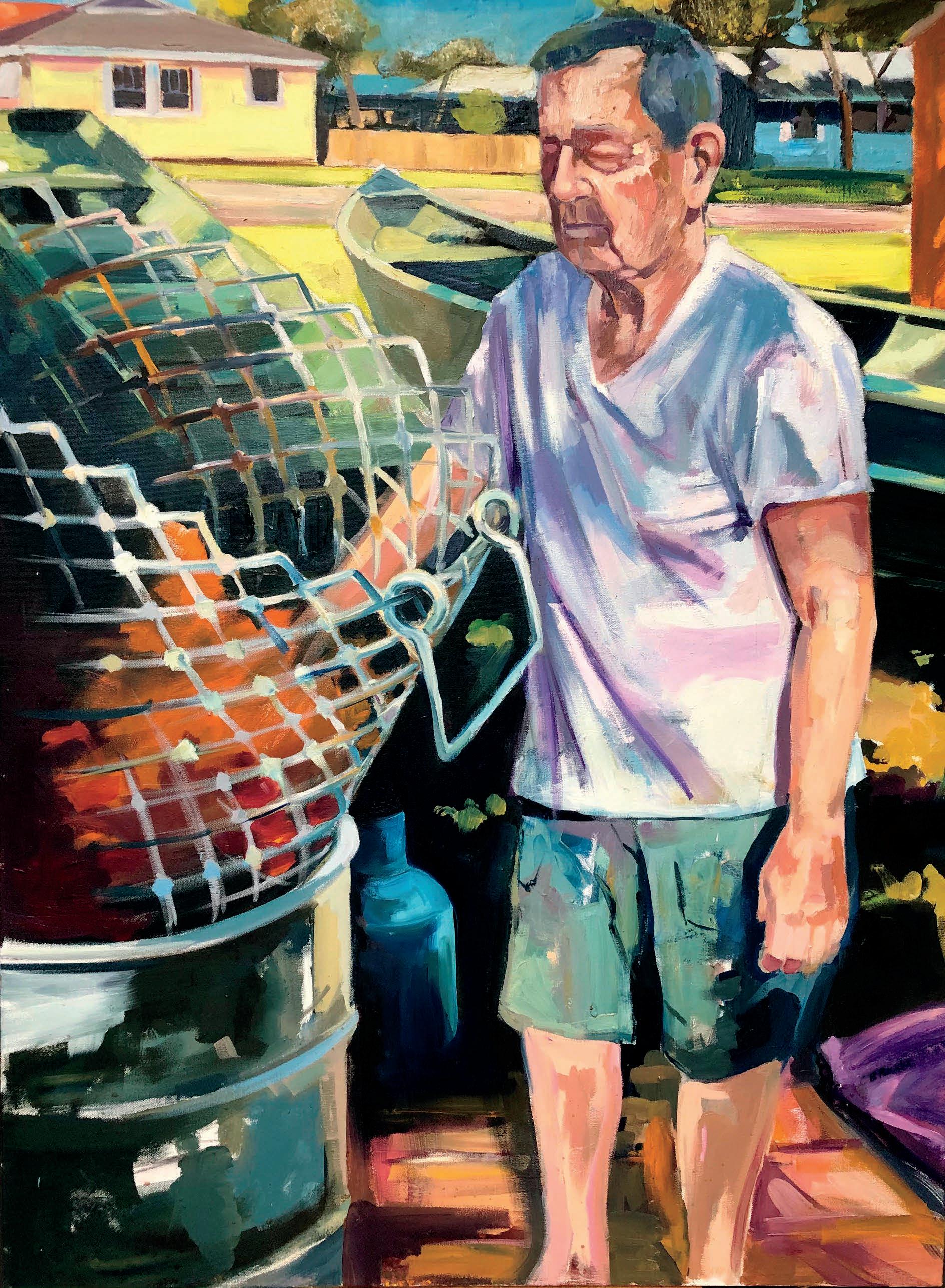
After a few hours at the museum, Stansbury escorted me out, flipping off light switches and locking doors echoing behind us. As I fished for car keys in my purse, he encouraged me to keep at it and pointed in the direction of the Franklin Library.
On the way, I passed several large, black, sugar kettles squatting on front lawns, converted into planters or garden fountains—relics of sugarcane’s heyday, as ubiquitous in the region as ancient moss-draped oaks.
Though many of this region’s established planter families left for the city after the War, letting their cast iron sugar kettles go to rust—sugar continues to fuel the local economy to this day, with more than 44,000 acres of planted sugar cane fields in St. Mary Parish alone.
Stansbury opened my eyes to the impact of the Civil War on the planters in my family. But more significantly, he had nudged me to the edge, daring me to deep-dive into a subject I had hardly given a thought to—sugar. Sugarcane changed everything for Louisiana and the South. And in this pocket of Louisiana, it changed everything for my family. •

 Story by Jordan LaHaye Fontenot
Story by Jordan LaHaye Fontenot

In 1765, a group of Acadian exiles arrived in the Attakapas region. Their way of life, and that of their descendants, would seep deeply into the land, growing and thriving there for generations. But that very first year, they formally established their place of worship, called l’Eglise de la Nouvelle Acadie aux Attakapas. The church, later to be called Saint Martin de Tours in the place now known as St. Martinville, was built in 1844, and its Parish Hall in 1861. It was here that, on September 19, 2023, a group of Louisianans gathered, hoping to interrupt the urgent progression of loss here in our home—loss of language, loss of culture, and loss of land—by founding the Fondation de L’Assemblée de la Louisiane.
Organized by a group of individuals who have demonstrated a vested interest in cultural preservation here in Louisiana—educators, musicians, writers, filmmakers, business owners—L’Assemblée is an effort to unite Louisianans in the interest of ensuring a vibrant future for our state that is rooted in its cultural past.

At the start of the founding meeting, organizer Will McGrew—founder of Télé-Louisiane and President of École
Pointe-au-Chien, the country’s first Indigenous French Immersion School— emphasized the danger of believing that the state’s current path downward in so many areas is inevitable. He said that we, as Lousianans, have a choice. “We can either sit by and watch as they continue with the narrative that what is happening is inevitable,” he said. “Louisiana will always remain at the bottom of the lists. The native speakers of French and Creole will not pass it on to the next generation. We won’t have better education. We will be underwater in fifty years. Or we can choose to act now to work together across differences to realize our dream of a Louisiana where our kids speak our language, where we rebuild our lands, where we celebrate our culture, and where we create abundant opportunity for our youth and generations to come. I believe in that dream.”
The organization—whose founding principles include protecting Louisiana’s “flooded, buried, not yet dead but above all desperate” heritage languages of French and Creole—aims to promote the creation of immersion schools in every community where those languages were traditionally spoken, and then to

ensure that there is economic opportunity built into our communities designed to support the students coming out of those programs, and to invest in the continuation of these languages across Louisiana. Other founding principles focus on preserving the historic culture and identity of the region’s founding peoples—including the Attakapas, Biloxi, Chawasha, Choctaw, Chitimacha, Coushatta, Houma, Tunica, and Tasha Native Tribes; the French, the Spanish, enslaved Africans, the Acadians, the Germans, and free people of color. The Declaration states “Our music, our dances, our food, our popular celebrations from Mardi Gras to boucheries, our accents, our words, our faith, and everything else belong to us, and enrich us.” The document also emphasizes the importance of protecting the land itself. “We stay on a land that is disappearing,” it says. “Our people, our culture, and our language have known no other home but our bayous, our rivers, and our prairies. This house, our home, is in danger like never before. Acts of God but also acts of man have torn up our lands and poisoned our waters, for which our future is in danger.”




“Language is at the core of the effort,”

explained McGrew. “But we can’t save French if Pointe au Chien is wiped off the map. And we can’t save French in our small towns if young people can no longer live in their small towns because there is no economic opportunity there. We can’t save Mardi Gras Indian traditions if young people can’t afford to live in Tremé and the Seventh Ward and Central City in New Orleans.”
Though the goals are lofty, McGrew—a self-proclaimed optimist—emphasized the power of a mobilized people. “I believe this to be the case, that we will look back at this day, and we will look back at this document, as a kind of turning point for the effort to fight for language and culture, but also as a part of a broader effort to revitalize Louisiana and redress Louisiana, get Louisiana to stand up again.” •
L'Assemblée de la Louisiane, will be accepting new members in the months to come. Keep up with the latest developments @assembleelouisiane on Instagram.

With the sharpness of a skinning knife, my alarm cut through the crisp morning air. I fumble around on my nightstand for my phone, still on the charger. My feet hit the icy hardwood floors, waking me in an instant. The sleepwalking dogs follow me into the kitchen, where I ease open the back door. Attention turned towards caffeine, I pour water in the reservoir, pile the grounds in a filter haphazardly, smash the buttons, and gaze into the carafe with zombie eyes. After a solemn cup in the cold kitchen, I gather my gear and throw on the clothes waiting in their neat pile on my dresser. With the old truck cranked and heating, the dogs sent back in, and my grandfather’s ancient Italian double-barreled shotgun in tow, I pull out of the driveway and point my truck north, heading directly towards the Tunica Hills Wildlife Management area, and a sky of squirrels.
In the temperate forest in which they dwell, squirrels fill a unique niche in the biological community, as the only mammals being both diurnal and arboreal. Leaping from limb to limb like an acorn-swilling Tarzan, the tree squirrels own the canopy. Consuming a variety of seeds and nuts, as well as bugs, bark, and buds—they are also some of the forest’s most effective conservationists, acting as seed predators and agents of dispersal alike.

There are two species of squirrels you might find here in the Southeast. The first and most prevalent is Sciurus carolinensis, the Eastern gray squirrel. Rarely reaching a pound, the Eastern gray bounds from branch to branch like a treetop ballerina. Other than small populations of melanistic black squirrels, they’re mostly a drab gray in color. These squirrels are most widely found in hardwood bottomlands and swampy forests.
The other species of squirrel native to this area is the Sciurus niger, or the Eastern fox squirrel. These red-
dish-brown squirrels are much larger than the Eastern gray and prefer oak groves in deep, undisturbed forests. There are also populations of melanistic Fox squirrels spread throughout their range, producing a distinctly dark-colored rodent. Though their diet is similar to their gray cousins, fox squirrels can grow to reach up to two pounds. While the Eastern gray is more of a habitat generalist, the Fox squirrel spends much more time on the ground, using open forest floors with sparse undergrowth to its advantage.
It isn’t a long drive to the Tunica Hills from my home in Baton Rouge. On this particular day, it is fifty-five degrees with a breeze slightly more prevalent than you want for a squirrel hunt. The more the wind blows, the longer it takes the squirrels to leave their nests, high in the trees. If it’s too strong, they may not leave at all. At the parking lot next to the trailhead, I down the last of my coffee, fire up the GPS, and tighten the laces on my boots.
Just down the dilapidated “hiking” trail stands a thicket of pecan and hickory trees, all encased in an oak grove. The terrain changes from upland pine forest to bottomland hardwood over a half-mile, until I finally slide down the hill beside the trail. There’s not much forage for a rodent in an upland pine habitat, but once you hit the bottomland, the acorns and pecans are spread out like a regular squirrel buffet. I check the GPS and realize I am only fifty yards away from my thicket. The sun is only just beginning to make shadows of every hanging limb. Selecting a thick red oak that had to be nearing a hundred years old, I sit down, leaning up against its massive trunk, to wait for daybreak.
Here in South Louisiana, hunting is often considered a rite of passage, a family sport. Neither of my parents hunt. My paternal grandfather only hunted on occasion.
The .308 caliber Remington 7400 deer rifle he used now resides in my closet. It is semi-automatic, neither bolt nor lever action like the most popular choices for deer hunting. He deemed this anomaly a life-saving habit he picked up in Vietnam that followed him home and never left. My maternal grandfather hunted, too—because occasionally they were too poor to buy food, but also for tradition and comradery. He hunted raccoons late at night with his Tennessee Walker hounds, wearing a coal miners’ helmet with powerful lamps attached. But he also sought out the sporadic squirrel and bobwhite
By the time I started to show interest in the tradition, my grandfathers had long since laid their guns down. The itch was scratched here and there when a friend of the family would invite my brother and I to their expensive high-fence deer leases—where I quickly learned I am ill-suited for the box blind—too impatient to sit, twiddling my thumbs, waiting for Bambi’s dad to walk out in front of me. One day my friend asked if I wanted to go squirrel hunting on his family property, which was really just their giant backyard, and I agreed with trepidation. How could harvesting a mere squirrel compare to the thrill of felling a deer—the only thing I had ever heard of people hunting at the time? I didn’t kill on my first trip, but I saw first-hand how wily these creatures were and realized the challenge of hunting a rodent. My pals bagged a few, and their grandma fried them up for us to enjoy around the table, all still wearing our camouflage coveralls. We hunted together off and on until we graduated high school, leaving those adolescent treetop scouring days for college, the Army, and then the city.
After my stint in the armed forces, I went to culinary school for a few semesters on my GI Bill—exploring my long-held passion for food, borne from experience working as a short order cook through most of my teens and early twenties. Quickly realizing that the high-stress environment of haute cuisine was not my calling, I enrolled at LSU in hopes that I could learn to be a food writer.
Around this time, I discovered the infinite opportunity of public lands. Emerging from a few years as a couch potato, I started hiking again for exercise, which turned into camping, which turned into backpacking. Soon I started fishing again, and then one winter, it got too cold to fish, and I wasn’t about to sit inside until crawfish season. Some quick research revealed that it was perfectly legal to hunt on the same public lands that I had been camping on, and this opened a whole new can of worms.
That first year I tried to hunt every animal the Louisiana Wildlife and Fisheries regulation book set a season for: deer, ducks, quail, and turkey. With nothing to show for my efforts, I started to remember those childhood romps in the oak bottoms, and the succulent taste of that first fried squirrel. I went out the next morning and, after seven and a half-miles of tracking, managed to bag one small squirrel. I took it home and fried it up in my cast iron, and ate it over the kitchen sink. Things haven’t been the same since. The next season, I dedicated myself entirely to the pursuit of the squirrel.
Back in my grove, I check the watch on my wrist as I notice the tree limbs move from behind the morning mist; only five more minutes until legal shooting light. I fumble around to release my binoculars from their clunky enclosure and bring the rims up to my eyes, still adjusting to the changing light. A considerable amount of scurrying in the treetop above me keeps my ears perked. After a few minutes under the gaze of modern optics, I zone in on a large gray squirrel about fifty yards in front of me, high in a hickory. This time of year, it can be hard to see your quarry through the leaves, but that also means it is harder for them to see you. I slowly ease
THE QUINTESSENTIAL SOUTHERN SQUIRREL DISH
Recipe by Dalton Hoover
2 to 3 squirrels
2 Cups buttermilk
1 Cup salt
1 Cup sugar
Half-Gallon of lukewarm water
Hot sauce
2 Cups self-rising flour
Cajun seasoning (to taste)
Peanut or any other vegetable oil for frying
Cast iron skillet
1. After skinning and gutting, break down the squirrel into front legs, back legs, and back hams. Ensure the meat is clean and free of hair and tree materials, then gently pierce it multiple times with a fork to tenderize. This helps fry the squirrel quickly, without drying it out too much.
2. Mix a cup of sugar and a cup of salt into the warm water until dissolved. Place the meat into the brine and weigh it down with a heavy dinner plate to ensure it's submerged. Place in the refrigerator for at least six hours, preferably overnight.
3. Add hot sauce to buttermilk, and after removing meat from the brine, submerge in buttermilk mixture. Marinate for two to four hours.
4. Mix flour with a generous amount of Cajun seasoning and pour into a brown paper bag. Remove meat from marinade and toss directly into paper bag. Shake vigorously to make sure every piece of meat is coated in seasoned flour.
5. Fill your cast iron skillet up about halfway with the oil. Heat your oil up to 375 degrees.
6. Remove meat from the seasoned flour and fry in the oil until the meat reaches 145 degrees on an instant read thermometer.
7. Ser ve with French fries and ketchup, biscuits and gravy, or my personal favorite: toss them in Buffalo sauce and serve with celery and blue cheese dressing.
to my knees, then to my feet—just as the wily little guy notices me and took off. Other than primates such as ourselves, squirrels are one of the only subsets of mammalians that have color vision, making camouflage all the more important when attempting to put a stalk on one in the woods.
Already on my feet, I take three hopping steps and stop, dead still. This is the way a squirrel moves through the forest, a few bounds at a time, then stopping to check for danger. After a few minutes of silence and canopy scanning, I lock on to another one. I move my eyes first, and then my feet. I stalk for about a hundred yards, then, just as I am raising my shotgun to my shoulder, the squirrel sees me. He bounds to the top of the tree, lets out a series of warning barks to his posse, and disappears into the green of the sunlit canopy.
More often than not, this is how the typical squirrel hunt ends, especially on such a blustery day. I sit at the base of a different hardwood, and listen to the wind, watching the woods wake up. This, if nothing else, is the reward for my efforts. I pick up my things, and begin to make my way back to my truck—back to civilized society and tame squirrels that run around suburbia, feeding on stray pretzels and the bounty of garbage cans. Just as I am easing the shotgun case into the backseat, I hear a ruckus in the treetops. There, a pile of Eastern grays well within range are having a territorial dispute high in a hickory. All I can do is chuckle. If I had to choose only one creature on this Earth to spend my time in pursuit of, it will always, without a doubt, be the North American tree squirrel. •
In Louisiana, squirrel season runs from October 7, 2023—February 29, 2024.
Alot of West Texas towns welcome you with warm drawls, cowboy hats. Not Marfa, which pops up like a nearly-forgotten film set from the expansive Chihuahuan Desert, around sixty miles from the Mexican border. Marfa doesn’t pretend to owe you a thing. Which begs the question—that perhaps gets answered, but on the other hand maybe not, beneath that big sky over all that red dirt— what brought you all the way out here, anyway? If you drove all this way thinking Marfa was going to put on a show for you, or even a smile, well, that’s your own fault.
Marfa feels a little like Wes Anderson’s Asteroid City—or maybe Wes Anderson’s Asteroid City feels a little inspired by Marfa. They’re both disorientingly-aesthetic little towns with sci-fi bents, way out there in the desert. And drawn by curiosity, by art, and mostly by the intrigue of the famous “Marfa Mystery Lights,” we had to see it for ourselves.
Driving into Presidio County at dark, in the middle of an electrical storm, we quickly sensed that there is something distinctly different about the atmosphere in the desert surrounding Marfa. Hoping to catch sight of Marfa’s famous “mystery lights,” our attention was already more-than-usually attuned to the sky—and this one was particularly vast and dark above the remote stretch of Highway 90. Occasionally, it would alight in a flash of the most vivid, multi-pronged lightning we’d ever seen, painting everything electric purple and illuminating the Chinati Mountains in the distance. At one point our headlights landed on a family of javelinas, and we slowed to pass the stout and scraggly wild pig-like creatures as they patiently waited in the opposite lane, as if to give us the right-of-way.
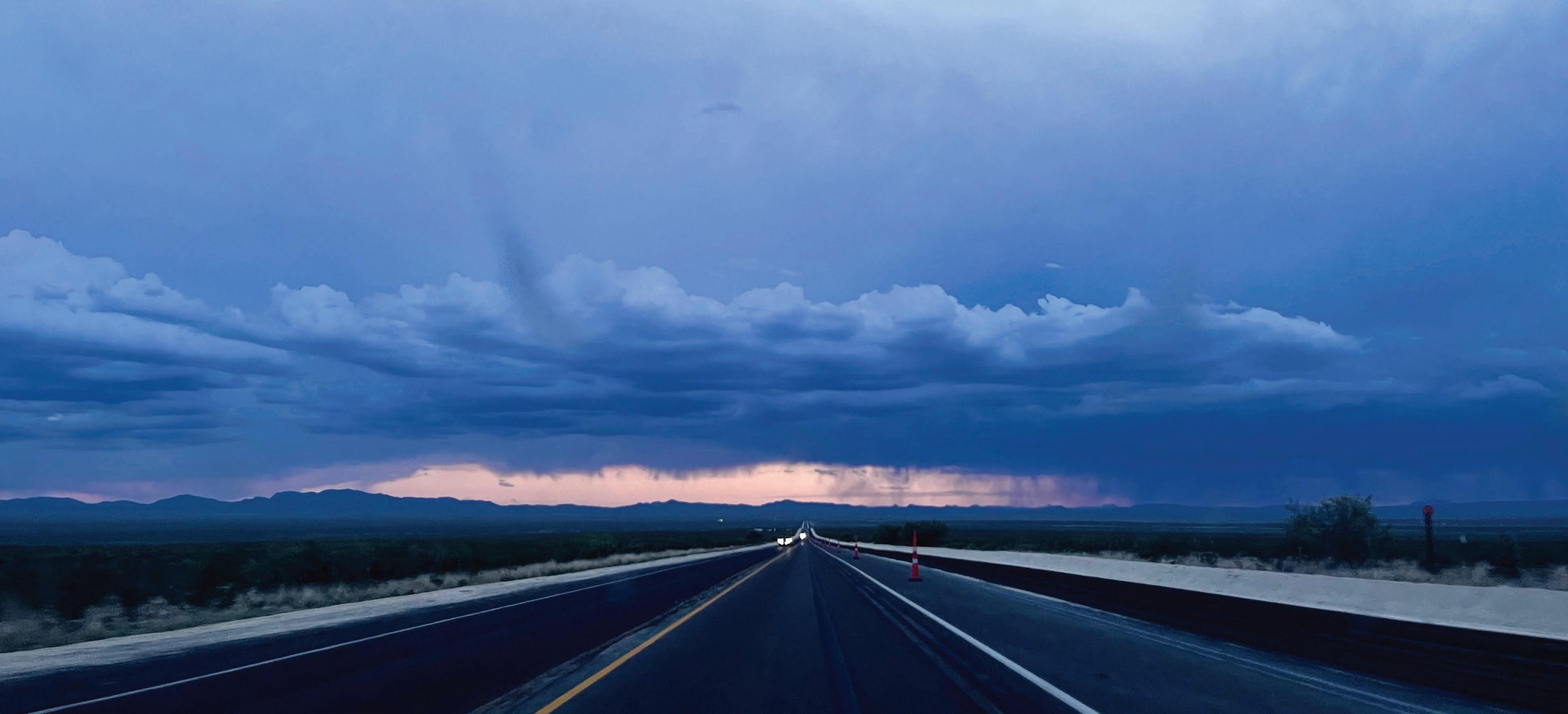
That’s as warm of a welcome as we got from Marfa.

A few miles east of town, we stopped at the Marfa Lights Viewing Area, which was built in 2003 to provide benches, binoculars, and restrooms to the thousands of visitors who travel here from around the globe each year, hoping like we were to get a glimpse of the unexplained moving lights in the sky. Texas Monthly writer Michael Hall called the Marfa Lights Viewing Area, “one of the oddest roadside monuments in the state.” I only saw it at night, but it was indeed a strange place, all alone on this lonely highway, to imagine the state and federal governments investing in. I sat on a bench next to my fiancé, Sam, surrounded by strangers also staring at the sky, pointing out tiny moving orbs of light and whispering theories to each other. The Marfa Mystery Lights are the area’s largest attraction, after all, having generated spectators and theorists and imaginers for decades.
According to Cecilia Thompson's book History of Marfa and Presidio County, the moving lights were first reported by a cattle hand in 1883, who thought the flickers in the sky might be attributed to Apache campfires. More reports from locals followed in 1885. Hall somewhat debunks these early sources in his article by reaching out to the writers’ descendants, who are unable to find the cited references to the lights in the original sources (though the granddaughter of the ranch hand does recall her grandfather telling her family about seeing the lights). Reports continued to increase in frequency through the decades, and monitoring stations were installed to keep up with the activity in 2003.
Besides extraterrestrial or supernatural phenomena, there are of course plenty of theories attempting to explain the sporadically-moving, orb-like, multicolored lights that have allegedly been reported for a century and
a half. The main postulations are atmospheric changes in temperature resulting in a mirage, and reflections of headlights from cars traveling on Highway 67. Some speculate that the lights come from phosphine and methane, sometimes called “swamp gases,” known to cause glowing lights in the swamp when they have certain reactions with oxygen. By that logic, could the feufollet of Louisiana folklore and Marfa’s mystery lights have the same source? Even if that perfectly logical scientific rationale explains both wonders—and I’m not saying it does—there’d be some magic in that, too, I think.
Sitting on the metal bench in the dark, shivering and squinting up at the partially-overcast sky, we didn’t see much that first night. We had planned to stay in the area for three nights for this reason exactly—accounting for potential bad weather. After maybe seeing a couple of strange blips of light between the clouds—it’s hard to know for sure if we saw them, or just desperately wanted to after that long day of driving—we headed into town to check into the Hotel Paisano.
The lingering presences of Liz Taylor and James Dean are enough to add a veil of romance to any location, but approaching the Hotel Paisano at night would have felt cinematic to us even if the pair hadn’t stayed there when filming Giant in 1955. Before Taylor and Dean and that whole Warner Bros film crew came through and raised the place’s profile, primary visitors to El Paso architect Henry Trost’s Spanish-style 1930 building were mostly cattle ranchers and tourists seeking the perceived health benefits of the desert air.
I wasn’t there in the ‘50s or prior, but I imagine it’s changed little since—and kind of like the existence of the lights, I choose to believe that’s the case. The design
“Marfais the biggest contradiction in the world. This isn’t Texas, this is New York. This is like I’m gonna get a stick stuck in my eye, and I can’t wait to get it, because it’s good for me.” —George Rodrigue A storm rolling in over the Chinati Mountains at dusk, taken through the author's car windsheild on Highway 90 as she approached Marfa.
is a hearty blend of West Texas and old Hollywood; its Spanish-inspired stuccoed rooms each have balconies overlooking a courtyard dotted with café tables and a tiered fountain in the center. Arriving after dark, we were greeted by white string lights and the glowing red neon sign bearing the hotel’s name. The fountain babbled loudly in the quiet night, and conjured the feeling of oasis. The lobby, with its red earth-colored geometric tiles, mounted longhorn heads, leather furniture, and faux-wooden beams, begged to tell southwestern tales of the cowboys and movie stars who have sought a little pocket of luxury tucked there in the desert. Black and white photographs taken during the filming of Giant line the hallways and stairwell, winking at more stories.
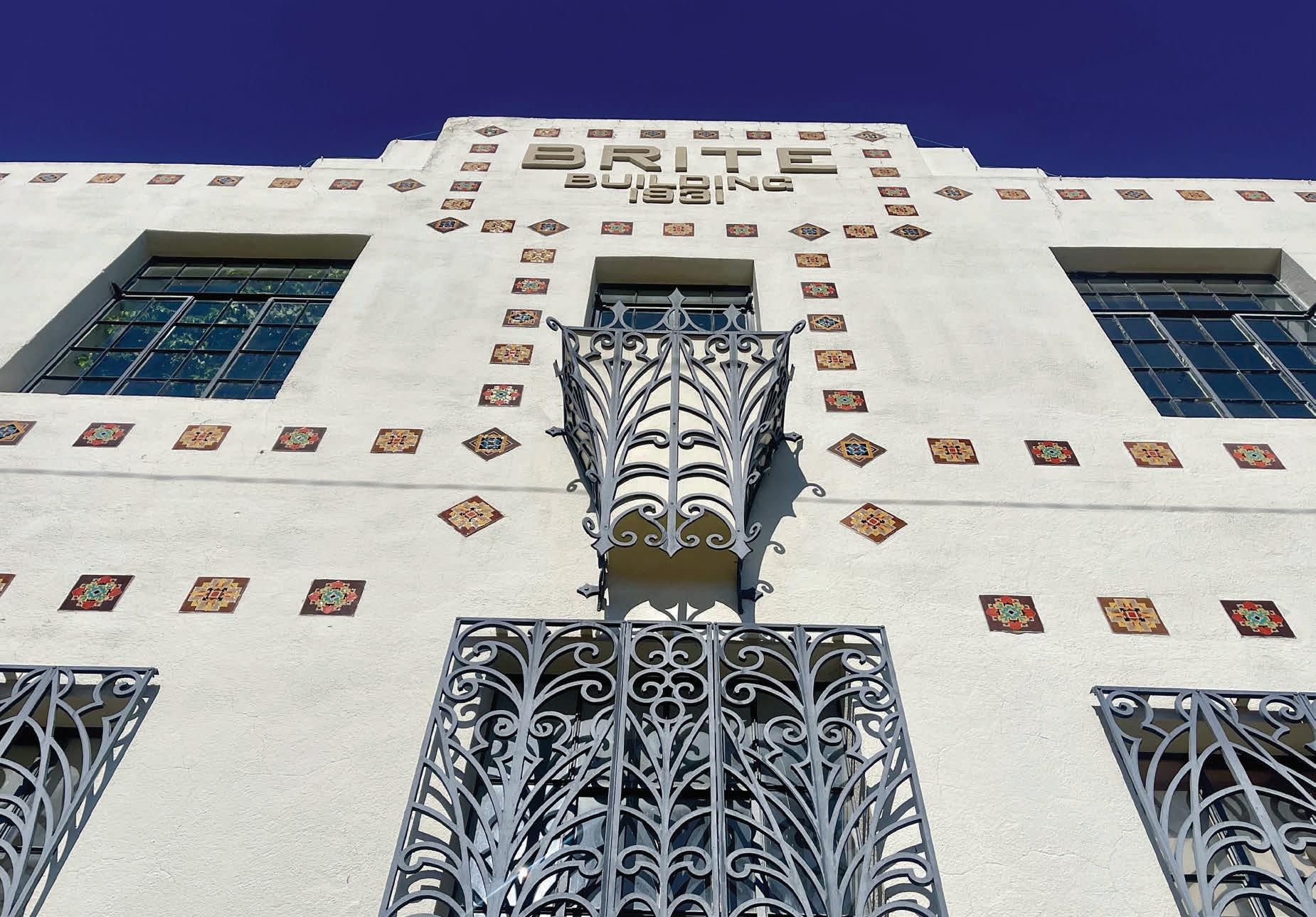
The following morning, we greeted the little town in the daylight, stepping onto our balcony and reveling in the dry air. Seemingly the only people on the streets, we walked less than a block past more structures that weren’t part of a film set, but could’ve been, to the regal, pale-coral Presidio County Courthouse at the end of Highland Street. Even though it was a Monday morning, the building was relatively quiet, and we worried that someone might stop us from climbing the broad, creaking steps to the rotunda. But no one did.
Once up there we were rewarded by a 360-degree view of all of Marfa and surrounding Presidio county, all the way south to Mexico. It was a beautiful view, with the town’s squat adobe buildings, art deco storefronts, and watertower thinning out to desert—the Davis and Chinati mountains rising up in the distance beyond. The birds-eye view from the rotunda revealed the town’s smallness more clearly for me than the map and the population statistics I’d looked at before, and I chuckled to myself thinking about how we drove all that way across Texas. We felt accomplished, like we were on top of the world (or at least the world of Marfa), then we climbed back down from the sun-filled room and headed towards Marfa Burrito.

Inside the little white building, which was covered inside and out in handwritten notes and signatures, we got a better pulse on the locals than we have anywhere else in town—largely because there were actually people there—around four, chatting in Spanish and laughing with the ladies in the kitchen. The cash-only shop is owned and helmed by Ramona Tejada, known locally as “the Burrito Queen of Marfa,” who smiles in a photo on the wall with Anthony Bourdain. Tejada makes all of the tortillas, spiced meats, and bright, spicy green salsa in-house. We shared a massive chorizo, egg, and potato burrito; I considered ordering another to prolong the savory satisfaction of biting through the fluffy tortilla into the dense, spicy center.
Back out on the dusty street, we set our sights on coffee. It wasn’t long before we saw the familiar green Starbucks logo, “COMING SOON” ominously promised beneath it. “Not here too!” I balked at Sam, lamenting the downfall of small-town coffee shops. “That’s borderline offensive!”
We walked into the small attached bookstore, and glancing up from his book, the spectacled thirty-something owner calmly asked, “I’ve offended you?”
“Oh, no, we’re just horrified they’re putting in a Starbucks,” we explained.
“It’s a joke,” he tells us, deadpan. “It’s always ‘coming soon’”.
We burst into laughter, feeling silly for missing it initially, and bought some locally-made stationary and a used book about social justice to smooth over the awkwardness. We asked how long he’d been in Marfa and how he liked it—he’d only moved there around a month ago, from Connecticut. We never found out if he liked it. He did insist we check out Planet Marfa, where
he bartends, telling us matter-of-factly “it’s the coolest bar in town”.
Another shop we poked our heads into and thoroughly enjoyed was Esperanza Vintage & Art, which lured us in with artist Richard Kurtz’s vibrant and primitive-looking canvas paintings of aliens. We made a comment to his friendly wife behind the counter about enjoying Marfa so far, to which she replied that she was eager to return to California and get out of “backwards” Texas. We still hadn’t encountered anyone who seemed particularly happy to be in Marfa.
Still seeking coffee, we approached the Sentinel, the only actual coffee shop that was open while we were there. But as I scanned the offerings besides the scones and lists of latte options on the counter, including copies of the local paper and “PRINT IS NOT DEAD” baseball hats, I realized our coffee hunt had brought us into the publishing house for the local weekly paper, The Big Bend Sentinel, which covers Marfa and the surrounding small towns in Far West Texas. I added a copy of that week’s paper and a hat to my lavender latte order, and sat down on a leather couch in the high-ceilinged former train station to tuck into the local news. Truly a small
town paper, individual college graduations and admissions were listed in that June issue, as were obituaries and other local goings-on.
Sufficiently caffeinated, we strolled past more art deco storefronts and succulent-abundant yards to the Judd Foundation, and procured our tickets for the next tour of Judd’s downtown studio spaces. Late New York minimalist artist Donald Judd is largely responsible for Marfa’s renown as an unlikely destination for artists and “art people”; an NPR writer once called the town “nothing less than an arts world station of the cross”. Professing his disdain for New York City’s art world, in 1977 Judd moved to Marfa and set out buying adobe structures and desert property, eventually filling them (but only minimally) with his cement sculptures, stripped-down furniture, early paintings, and other designs. He also founded the Chinati Foundation, which also holds multiple buildings and stretches of land that house permanent art installations.
We greeted our tour guide, a very beautiful and very apathetic young woman in a “PROTECT INDIGENOUS LIVES'' t-shirt from down the highway in
Valentine, and she gave a brief and emotionless spiel about Judd’s philosophy of permanent installation—he disagreed with the usual way museums and galleries cycle in different artists and exhibitions, stressing the importance of an artist having control over the context in which their work is presented. She explained that Judd died before he was able to complete the spaces we’re about to see, and that his foundation has changed or altered very little about them since, to preserve his original vision.
Walking through each bare room in the unassuming adobe buildings—some with Judd’s early paintings containing a single-colored stripe, some completely empty except for a single piece of minimalist furniture or an antique whose simple design he’d latched onto—I’m somehow amused, fascinated, and almost a little angry. Art is subjective, of course, and I began to wonder if my inability to connect with the installations signified a lack of culture on my part—perhaps I should have my art editor card revoked. But despite my efforts to always maintain an open and curious mind, I simply could not bring myself to feel particularly moved staring down at that simplerthan-Ikea iron bed frame, or anything else on the tour. If Judd was the reason Marfa is placed on a pedestal as an art destination and for the resulting real estate hikes, well, I feel like we’ve all been a bit duped.
I liked that our tour guide gave credit to Judd’s girlfriend for certain designs normally attributed to him, like a large rotating wooden door, and was candid about the fact that his wife hated Marfa and never wanted to live there. These moments were some of the only times I thought, just maybe, her lips hinted at
curling into a smile at the edges. When the tour was over, we tipped her $20, and asked for her recommendation for lunch. Without hesitation she pointed us to Bordo, a handcrafted Italian sandwich place nearby. She also told us about a metal show that night at El Cosmico, the hip campground we had reservations to stay in the following night.
Tucked on the edge of the desert, Bordo was, like so many things, not what we expected to find in Marfa. The small shop smelled of home-baked bread, all of which is made with stone-ground, heirloom flours. We ordered a sandwich with smooth and nutty mortadella, creamy stracciatella, a pistachio spread, parmesan, lemon, and basil; cradled by the crusty, rustic bread. For a side, we tried the Patatas Stronzetta (the star), crispy new potatoes doused in calabrian chili aioli, lemon, parsley, parmesan, and crispy breadcrumbs; and we we sipped on a made-in-house pistachio cream soda, all to be chased with a cup of creamy and cinnamon-forward horchata gelato. The meal was far from the Tex-Mex we’d been anticipating, but there would be plenty of time for that. We puzzled over Judd’s lingering legacy between bites.
One of Marfa’s weirdest landmarks is Prada Marfa, which isn’t actually a Prada store nor is it in Marfa, but is an art installation designed to look like a Prada storefront on a completely remote stretch of highway, technically just north of the practical ghost town of Valentine. Cattle ranches, lingering signage for no-longer-standing motels, and long-defunct gas stations occasionally broke up the drive; then, there it was: Prada Marfa, a tongue-in-cheek mirage of consumerism,
rising from the dust alongside the blacktop.
As remote as it is, when we pulled up, two very fashionably-dressed Korean women were in front, taking each other's photos in a variety of serious, editorial-looking poses. I snapped a few of both of them with their phone before they left, and we proceeded to conduct a little photoshoot of our own; the only reason anyone drives out there, anyway.
We started the drive back into town, the gas light on my Prius indicating its emptiness with increasing urgency. Passing the only gas station on the stretch, which looked to have not been active in decades, we laughed at our own stupidity, feeling like we were in a satirical short film by some too-hip film student, and preemptively made a call to AAA, trying in vain to explain to the receptionist where we were with no other landmarks to point a tow truck to us besides the occasional ranch. Then my phone service gave out. Thankfully we learned that day that Priuses can cover a substantial amount of ground on “empty”. I wonder if Marfa, and its gas station, has ever seemed like such a beacon of civilization to anyone as it was to us.
That evening, we headed to Planet Marfa, which the bookstore (not future Starbucks) owner had told us was the “coolest bar in town”. It was a really cool bar, with a distinctly Marfan aesthetic drawn from a bunch of artful-looking, hodgepodged structures like a teepee and old school bus in a dirt yard surrounding an outdoor bar which, like everything else, appeared to be made from reclaimed materials. We said “hi” to the bookstore owner, who seemed like he didn’t remember that encounter, or maybe just
didn’t want to be associated with us tourists.
For dinner, we headed to a hole-inthe-wall little place on the edge of town (though they kind of all felt that way), called Angel’s. We ordered some TexMex staples, and that close to New Mexico, I couldn’t resist getting something doused in green chile cream sauce—in this case, a gristly chicken-fried steak. After eating more than we should and encountering some of the friendliest service we would experience our whole time in Marfa, we headed to El Cosmico for some metal music.
At the campground, we sat at a picnic table and listened to a raucous, high-energy metal band from Austin called Rickshaw Billie’s Burger Patrol, and watched the diverse myriad of locals chat and mosh to the music. We saw our tour guide from earlier and tried to catch her eye and wave, but she was talking with the bassist from the opening band and ignored us, too. Looking at the vibrant-haired, aggressively-artsy crowd, it was clear to us that Marfa wasn’t just thought of as an art town back in the ‘70s, nor did it stop being an art town in 2015 when Huffington Post published an article with the subhead “I Went To Marfa, Texas, And All I Got Was This Lousy Case Study In Gentrification”. At least to these young locals, who no doubt came from New York or California or in a few cases towns like Valentine just down the road, Marfa was an art town—they were making it that way. I wondered if they ever rolled their eyes at Donald Judd, or if they’d agree with that Huffington Post writer that the influx of people like them and tourists like us have killed the place’s original artful mystique. There’s a lot to wonder about in Marfa.
Once it got dark, we left the bustling campsite to head back out of town, hopeful that this time we’d get a real look at the reason we came: the Marfa Lights. The sky was much clearer that night, and within a few minutes of tilting our faces up toward the stars, we began to identify balls of light that weren’t stars at all. We knew because of their movements— the first I clocked I thought might be an airplane, until it abruptly changed its course, zipping back in the opposite direction, then up, then back down, almost in a zig-zag pattern. We struggled to point them out to each other, but there were so many of them, we eventually just settled for watching whichever we found, and would follow them as they sporadically traveled across the darkness until they trailed off or we moved onto another, brighter than the last, and more chaotic.
Before we arrived, I’d been pretty thoroughly convinced that a study by the University of Texas at Dallas students had reached the most convincing conclusion: that the “mystery lights” were really just reflections of car headlamps. But after watching those bizarrely-mov-

ing lights until our necks were sore, I was no longer convinced. “They aren’t headlights,” I whispered to Sam in the dark, eyes locked on a moving orb. “I don’t know what they are, but they don’t look or act like headlights.” And maybe it was wishful thinking, but their patterns of movement, colors, and shapes, really did seem too far removed from something so mundane. When we eventually pulled ourselves away, we felt accomplished: we had seen the Marfa Mystery Lights. And even better, we’d lost any conviction about what causes them. We got to experience the lights, and the mystery.

The next day, we got out of Marfa, heading to the nearby mountain town of Fort Davis to hike Mount Davis’s modest-yet-rewarding summit, high above the desert. After the relatively brief but strenuous hike, we enjoyed a victory meal doused in more chile sauce at a casual joint called Poco Mexico, then drove up to McDonald Observatory, where the University of Texas records their syndicated StarDate radio program, which airs on NPR.
After ogling the massive telescope, and a bit more marveling at the vastness and strangeness of the universe, we drove back toward Marfa, stopping on our way at a tiny green caboose called Hebert’s for a cone of Blue Bell ice cream. We were amused when the girl working there confirmed that yes, the owners are Cajun, and it’s pronounced as such. We had another surprisingly good Italian-ish meal at the Waterstop for dinner: a summer vegetable and pancetta pasta dish with a feta-heavy salad and lovely, balanced cocktails.
That night, we checked into a colorful yurt at El Cosmico—the receptionist didn’t even glance up when I approached the front desk, let alone smile or say hello, confirming again that any trappings of Southern hospitality that bleed into Texas do not make it this far west. I bought an overpriced "I SAW THE MARFA MYSTERY LIGHTS" t-shirt from the gift shop, anyway. After passing the hip smattering of airstream trailers, teepees, safari tents, and other aesthetic lodging options, we had a strange but restful night, listening to a storm slapping the material of the yurt. We were grateful that we’d seen the Marfa lights the night before when the sky was clear.

Our last morning in Marfa, after grabbing another lavender latte at The Sentinel, we gave Judd one last shot, peeking in the windows of one of his closed Chinati Foundation buildings. We’d hoped there we might find some local artwork, perhaps by Native or Hispanic artists, but instead saw a permanent installation of large, crumpled metal abstract expressionist sculptures that resembled compounded cars by John Chamberlain, a late friend of Judd’s from New York. We also made a stop by the Chinati Foundation fields that house Judd’s minimalist cement block sculptures, though decided not to pay the hefty admission, since
we’d already paid substantially for the Judd Foundation tour and we weren’t sure what any of the money went towards, anyway. We could see the simple rows of concrete blocks in the fields in the distance, which reminded us of the construction supplies gathered back on our street at home in New Orleans, and felt like that was as close as we needed to get. If we go back to Marfa, we'll prioritize seeking out work by current local artists, if we can find it.

As we headed back to the car, a lady in a nearby house told us off for trespassing, which was fair even if we hadn’t realized
we were. On our way out of town, we stopped in the Marfa Visitors’ Center to pick up some stickers from the thematically unbothered tourism directors there (I’d had a brief phone call with one of them before the trip, explaining I was a journalist and requesting some information—after I sent an email follow-up, I’d still never heard back). We got pulled

Aperfect autumn road trip for Southeasterners is the cruise along Arkansas Scenic Highway 7 from Hot Springs north to Eureka Springs, the two quirkiest cities in the Natural State. Beginning in the Ouachita Mountains are these legendary hot, healing waters. Then, at the end in the Ozark Mountains, discover a progressive community with one of the most haunted hotels in the country. Buckle up, and let’s head north.
Encapsulated in Hot Springs National Park, the city itself is best known for its waters—deemed a neutral ground by Native Americans long before the white man arrived, where disagreements were set aside for all to share in the healing vapors. It is assumed that Hernando de Soto visited the springs, as his expedition covered much of central and western Arkansas circa 1540. After the Louisiana Purchase and the area’s subsequent settlement in the 1800s, the city became a health resort destination. In 1832, Hot Springs became the United States’ first federal reservation (equivalent to a national park).
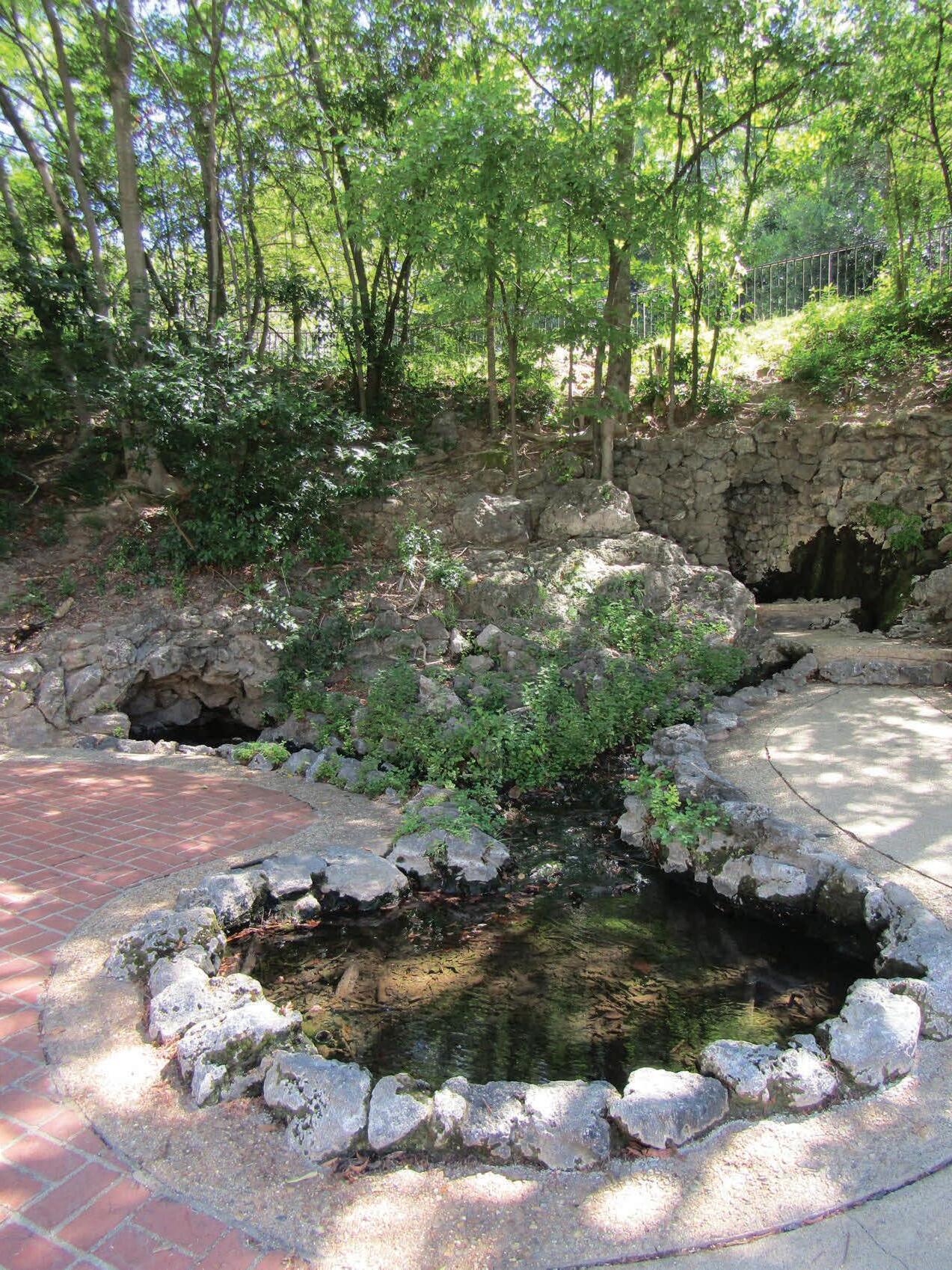
The liquid bubbling up in Hot Springs is drinkable at the source. Fill your jugs for free in the center of town. Heated by deep tectonic plate friction, the local bathhouses bubble with 4,000-year-old water. Of eight historic bathhouses, only the Buckstaff and the Quapaw still operate. Those, plus the Arlington Ho-
tel facilities, are your choices for an authentic soak.
The out-of-operation, circa 1910 Fordyce Bathhouse serves as the city’s Visitor Center, with tours of elegant display baths—including the DeSoto Fountain, with its striking stained glass skylight and iconic sculptures.
I chose the traditional regime of the Buckstaff, which has been in continuous operation since 1912 and entails soaking in a hot whirlpool sipping mineral water from a nearby spigot, followed by a sitz bath and a sweat in a personal steam chamber, finished by a trip to the cooling room for a massage.
During the last century and before, illegal gambling was a Hot Springs trademark, with law enforcement on the take. In 1899, disputes over casino territory erupted into a historic shootout between the city police and county sheriff deputies. Get a taste for some of this history at the circa-1904 Oaklawn Park Race Track, which is considered one of the best in the country and has a racing season from December to early May. There is also a full-service casino with a luxury hotel and spa.

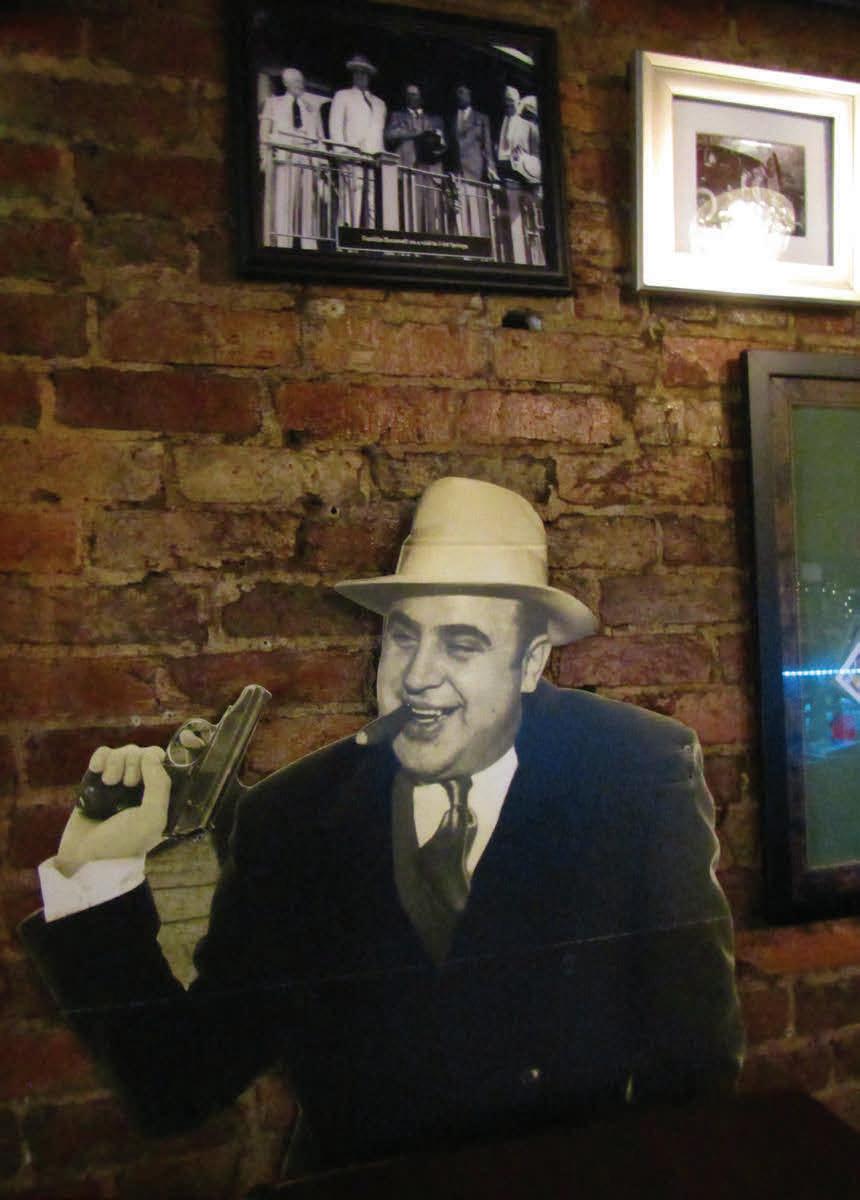
The Gangster Museum tells the stories of famous thugs who retreated to the vapors—such as how Al Capone shipped illicit Prohibition moonshine to his Chicago clubs in plain sight by masquerading it as Mountain Valley Spring Water. Capone, Frank Costello, Owney Madden and more are featured in six galleries depicting organized crime in the city and nation. Of course, Capone has his room, but so does Alvin Karpis, America’s last official public enemy number one, who tutored John Dillinger, the Barkers and other Midwestern outlaws. The New York Connection covers Lucky Luciano, Frank Costello, and Ben “Bugsy” Siegel and their frequent visits to Hot Springs. It is purported that Siegel’s inspiration for his Las Vegas Flamingo Hotel came from his many visits to Hot Springs.
For breakfast, it’s The Pancake Shop, which has been around since 1940. Order the signature blueberry pancakes, and your waitress will advise cutting a well in the center of your pancake so the syrup won’t spill. The sausage, creamy grits, and apple buttered toast are complete perfection.
The Ohio Club is the oldest bar in Arkansas, but known for great food thanks to the owner Saddiq Mir who once managed food and beverage at both the San Francisco and New Orleans Fairmont Hotels (now Waldorf-Astoria) and is the current President of Oaklawn Park. Ohio burgers are standouts, though the house Reuben is also excellent. Desserts include shoestring funnel cake fries dusted in powdered sugar. End the night with “Naughty Milk and Cookies,” a caramel

white Russian cocktail with toasted marshmallow garnish, served with chocolate chip and marshmallow filled cookies on a graham cracker base. Look for the photo of Senator Huey Long receiving the key to the city in 1932.
Find authentic Tri-State pizza at DeLuca’s Pizza, owned by a family from Brooklyn. Try the Franky’s Flatbush, a three-cheese pie made with homemade mozzarella, which reminded me of my favorites from years of business travel to New York City. Be warned: there’s only one size, eighteen inches, so go hungry or with friends.
In a converted bathhouse, the Superior Bathhouse Brewery is the only brewery in a U.S. National Park and the only one in the world brewing with thermal spring water—offering eighteen rotating brews on tap and a farm-to-table scratch kitchen. This fall’s Fouke-Ness Monster nods to two legends: Fouke, Arkansas where Big Foot sightings have been numerous and the Loch Ness monster, because it’s brewed with peated Scottish malt.

Spring training was invented in Hot Springs when the Chicago White Stockings (Cubs) traveled down in 1886 to “boil out the winter” with the baths and mountain air practices. Over the next three decades, more than 300 major league players trained in the city, including 137 members of the National Baseball Hall of Fame.
In a parking lot near Whittington Park, a home plate denotes where Babe Ruth hit the first home run longer than five hundred feet (573, to be exact). The ball landed in a pool inside the Arkansas Alligator Farm and Petting Zoo, still operating today.

Next year the grand Arlington Hotel and Spa will celebrate the centennial at its current location, though it has been a part of Hot Springs since 1875. Until those updates are done, it is still a delight to sleep in the heart of downtown Hot Springs, overlooking Bathhouse Row. Former guests have included crime boss Al Capone, plus Babe Ruth and other famous athletes, movie stars, and U.S. presidents. Ruth signed his first major league baseball contract in the hotel’s bathhouse.
For a mix of modern and historic boutique hotel, consider The Waters Hotel, a Hilton Tapestry across the street from Bathhouse Row. It was opened in 2017 after a major conversion project of the 1913-built Thompson Office Building designed by George R. Mann, the architect of the state capitol.
If you’re a fan of the Western fiction genre or frontier law enforcement non-fiction history, consider a westward detour before continuing on to the Buffalo River and Eureka Springs.


In Dardanelle, just before the Highway 7 bridge across the Arkansas River, is a turn-off to the west. This is the “True Grit Trail” (State Highway 22) made famous by the Charles Portis novel and the two movies it spawned. Though neither was filmed in Arkansas, the 2010 version starring Jeff Bridges and Matt Damon best resembled its Arkansas locales though filmed in Texas and New Mexico. Still, diehard fans of “The Duke” will forgive John Wayne’s original 1968 version, with towering Rocky Mountains standing in for the book’s gentle Ouachitas as its laughable backdrop. (At least Wayne’s male co-star was himself an Arkansas native Glen Campbell.) Where fiction meets reality is a left turn on Highway 22, running
the route to Fort Smith where protagonist Mattie Ross finds Rooster Cogburn and potential justice. The Trail itself starts in Dardanelle, where a state park offers a mountain view, camping, biking and hiking.
Further along, the countryside is filled with plenty of creeks and recreational areas with fishing accesses, such as Jones Creek, Delaware Creek, and Shoal Bay Recreation Area. At Paris, there’s True Grit Grounds, where you can get a cup of Rooster's Roast (a double shot of espresso dropped in a mug of black coffee, with a hint of hazelnut) and a Trail's Triple Meat hoagie sandwich.
In Subiaco is the beautiful Subiaco Abbey and historic Academy founded by Benedictine monks in 1878. Contrast: Outside my hometown in Covington, St. Joseph’s Abbey monks build wooden coffins; in Subiaco they brew beer, like Abbey Amber or True Grit Ale.
The town of Charleston has a big wide main street in the Old West tradition where you find small shops and well-preserved brick buildings. For a nostalgic ture, go for a burger and soft serve at the
Dairy Diner on Main Street.
At the end of the trail are two larger river cities, Fort Smith on the south banks and Van Buren to the north. The Fort Smith National Historical Site is maintained by the National Parks Service with admission charges for indoor exhibits (which are covered if you have National Parks Pass). There is no charge for walking the grounds. The site focuses on the eighty-year period from the founding of the first fort in 1817 until the final days of “Hanging Judge Parker” in 1896, when the region was still Indian Territory. Historical facilities include the barracks and dining hall, the courthouse, and of course, the gallows.
Less than two miles upstream is the United States Marshals Museum, a distinctively modern structure in contrast to the old fort site. The museum—which only just opened its doors in July, 2023— shares the story of the legendary marshals service begun in 1789. Inside, you’ll encounter topical galleries tracing not just the history of the service but its changing function over the decades, from frontier law enforcement to modern-day crime. Having just learned of Hot Springs gang-
sters, you might find it an ironic juxtaposition to see how marshals risked life and limb to bring the bad guys to justice, as in one display of illicit whiskey confiscation during Prohibition. More poignant images are of marshals protectively escorting African-American grade school and college students into previously segregated facilities.
Across the river is Van Buren, which has a historic downtown district with the expected array: Victorian architecture, gift and antique shops, candy kitchens, and eateries. Of special note is the old train station that still operates. The Arkansas and Missouri Railroad operates a daily excursion through the Boston Mountains to and from Springdale.
For a quick return to Russellville and Highway 7, hop on Interstate 40, or for a slower pace, choose U.S. 64 which runs roughly parallels the Arkansas River. The highway lends its name to “Bargains Galore on 64,” the 160 mile-long yard sale from Van Buren to Beebe held the second weekend of August each year.
In the town of Ozark, the historic bridge over the Arkansas River, completed in 1931, is considered the most beau-
tifully designed bridge in the United States by the American Institute of Steel Construction. At this place, one may ponder the origin of the term “Ozark,” which is not Native American but corrupted from what French explorers saw in this region. One origin story claims the name is derived from “Aux Arc” or “of the arc or bend”—a comment on the distinct river bend here. Think of Ozark, Arkansas as a small “Crescent City” and chuckle at the thought—if Monsieur Iberville hadn’t eagerly named his new outpost after the Duke of Orleans, but rather from the pronounced curve of the Mississippi, then Louisiana’s largest city might be called Ozark. Others say the root of the word is “Bois d’arc,” literally “wood of the bow” seen in the hands of Native Americans, as reported by the French exploring the region.
Altus makes an appropriate end for your detour, as the center of Arkansas’s wine industry. The legacy of winemaking in Arkansas began with two European winemakers: Jacob Post, who came to America in 1872, and Johann Wiederkehr, who immigrated to Altus
from Switzerland in 1880. The climate and topography of this particular part of the river valley were similar to the fine wine-making regions of Germany and Switzerland. Wiederkehr was drawn to the area specifically because of his ties to the Swiss monks at Subiaco Monastery. His first wine cellar is now the restaurant at Widerkehr Wine Cellars Inc.
Tours are available at some locations; the most notable is Wiederkehr Village, with a wine tour and lunch or dinner at the Old Worldthemed Weinkeller Restaurant. The fondue and wurst sampler appetizers are authentic, and main course selections like Matterhorn Schnitzel and beef Stroganoff signal your later destination, the Little Switzerland of America (Eureka Springs).
truegrittrail.com


Complexions
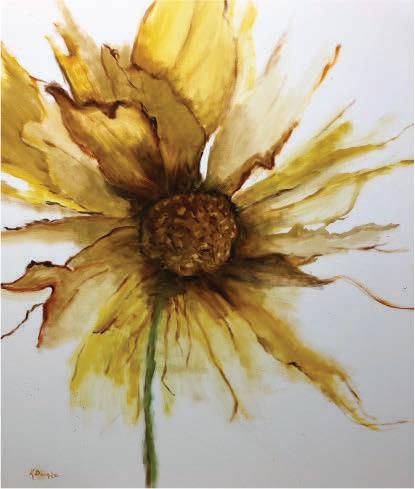
Contemporary Ballet with Chief Adjuah (formerly Christian Scott)
OCT 21, 2023
Compañía
Nacional de Danza
National dance company of Spain
JAN 20, 2024
Les Ballets de Monte Carlo in LAC (Swan Lake)

MAR 2, 2024

Parsons Dance with The Allen Toussaint Orchestra
APR 20, 2024 SUBSCRIBE AND

After sweating in the hot baths, it’s time to head north to Eureka Springs, known for equally healing, though chillier, spring waters. Most of the way will be via Arkansas Highway 7—a favorite of motorcyclists because of curves and steepness and the beauty, especially in the fall. Passing across the Arkansas River at Dardanelle, you leave the valley behind, climbing upwards to Jasper, Ponca, and the Buffalo National River—famous for float trips from March until late spring or mid-summer (depending on rainfall).
Folklorist Vance Randolph once said of the Ozarks “It’s not that the mountains are so high but that the valleys are so deep.” No greater example is a stop at the Route 7 Rotary Ann Roadside Park. It offers a beautiful 180-degree view of so-called Arkansas Grand Canyon.
Or, stop and dine with a view at Cliff

House Inn—a restaurant, motel, and gift shop perched above the canyon. The owners are from Louisiana; po-boys are on the menu. But a traditional Arkansas catfish dinner is served with pinto beans, slaw, fries, pickled green tomatoes, and hot water cornbread. For dessert “Company’s Coming” pie is a must: pecan and saltine crackers in a baked meringue crust filled with fresh whipped cream and pineapple. It is the official Arkansas State Pie, decreed in 1986.
Learn about the Arkansas elk and other wildlife at the Ponca Elk Education Center. Native elk were hunted to extinction in the 1800s. A species from the Colorado Rockies was introduced in 1981. The herd has grown to 600 and can be seen wandering along Boxley Valley roadways most anytime from fall to spring.
Hawksbill Craig at Whitaker Point is one of the most iconic of Arkansas sights. A pickup or SVU is recommended for
Back at Russellville, home of Arkansas Tech University, excitement is reaching new heights, literally, with anticipation for the April 8, 2024 solar eclipse. Both Russellville and Dardanelle expect to be bursting at the seams with visitors, as the path of darkness passes directly above both communities. So, for the three-hour event, you needn’t fly “your Lear Jet up to Nova Scotia to see the total eclipse of the sun ” as in the Carly Simon song, but merely drive up to Arkansas. eclipserussellville.com
the trek. The turnoff sign is on Highway 21 six miles south of Ponca, then six miles up a gravel road, past a church to a parking area. Then it’s a moderate three-mile roundtrip hike to the crag and a spectacular view. (Tip: The Jasper Advertising and Promotion Commission director Lisa Duet is a DeRidder native. She has the scoop on all the area goings-on. experiencejasper.com.)
Your GPS will offer two options heading northwest to Eureka Springs. My favorite is Highway 21 to U.S. 412 then north on legendary State Highway 23, the “Pig Trail” because it twists and curls as a pig’s tail.
Imagine New Orleans’s French Quarter and St. Tammany’s Abita Springs tossed in a bag of beignets and sprinkled over the Ozark Mountains. You’d have arty, progressive Eureka Springs where streets intersect at disparate elevations, seldom at square angles.

Legend says that Sioux Indians cured their blind princess by washing her eyes with local spring water. In 1854 Dr. Alvah Jackson used the waters to cure his son, who also suffered an ailment to his eyes. His evangelization efforts of the water’s curing properties attracted attention nationally, and Eureka Springs became an official settlement in 1879.
Today the population is about 2,100 and the springs are for atmospherics, not consumption. The city is filled with

restaurants, cafes, shops, galleries and accommodations including historic hotels, bed-and-breakfasts, cabins, and Alpine themed motels. Called the “Bible Belt’s LGBTQ+ Oasis,” rainbowed VW hippy busses and old Volvos share the roads with motor coaches and church buses. Even little mythicals are welcome: shops have tiny fairy doors at sidewalk level.
Le Stick Nouveau is a creative fine dining experience owned by Brandon and Donna Cox. It’s open only Friday through Sunday evenings, usually serving a prix fixe dinner. Reservations absolutely required. Eureka typical: The owners post selfie videos shot around town announcing upcoming thematic menus. For example, March was “80s Throwback” featuring gourmet standards Lobster Thermidor, Duck á l’Orange and a deconstructed cherries jubilee dessert and September was “FALL-ing in Love” with carrot ginger soup, pear and clove sorbet, and locally-source lamb meatballs.
The Eureka Grill at 71 Spring St. is great for very casual dining and a favorite of my friends, Louisiana natives Buddy and Annie Spell who split their time between a cottage in Eureka Springs and their home in Covington. Expect burgers with fresh cut fries, homemade pimento cheese sandwiches, and fish tacos. Buddy’s favorite is fish and chips, which I concur. The outdoor dining area is dog friendly. Cash only.

In Eureka Springs, The Great Passion Play is regularly performed in an outdoor amphitheater east of town near U.S. 62 from May through October with a cast of 170 actors and dozens of live animals. Also on the property is the Christ of the Ozarks statue (the largest Christ statue in North America), a Holy Land replica with an interactive tour, a section of the Berlin Wall, and a Bible Museum with over 6,000 Bibles, including a leaf from the Gutenberg Bible." Since opening in 1968, the play has drawn an attendance of over 7.7 million people, making it the most-attended outdoor drama in the nation. The play is set against an expansive, realistic set depicting Jerusalem and Holy Week leading to Christ’s crucifixion and resurrection. The special effects are stunning.
In September 1929, John Phillip Sousa and his brass band opened the new City Auditorium known locally as The Aud. Modern day posters of previous performers adorn the lobby: Willie Nelson, Emmy Lou Harris, Lyle Lovett, Judy Collins, B.B. King, Don McLean and others have played for the fine acoustic bones and savvy ticket-holders of this 986-seat "Ryman Auditorium" of the Ozarks.
Eureka Springs is popular for antique car club meets. Often the Best Western Inn of the Ozarks is the base. Upcoming

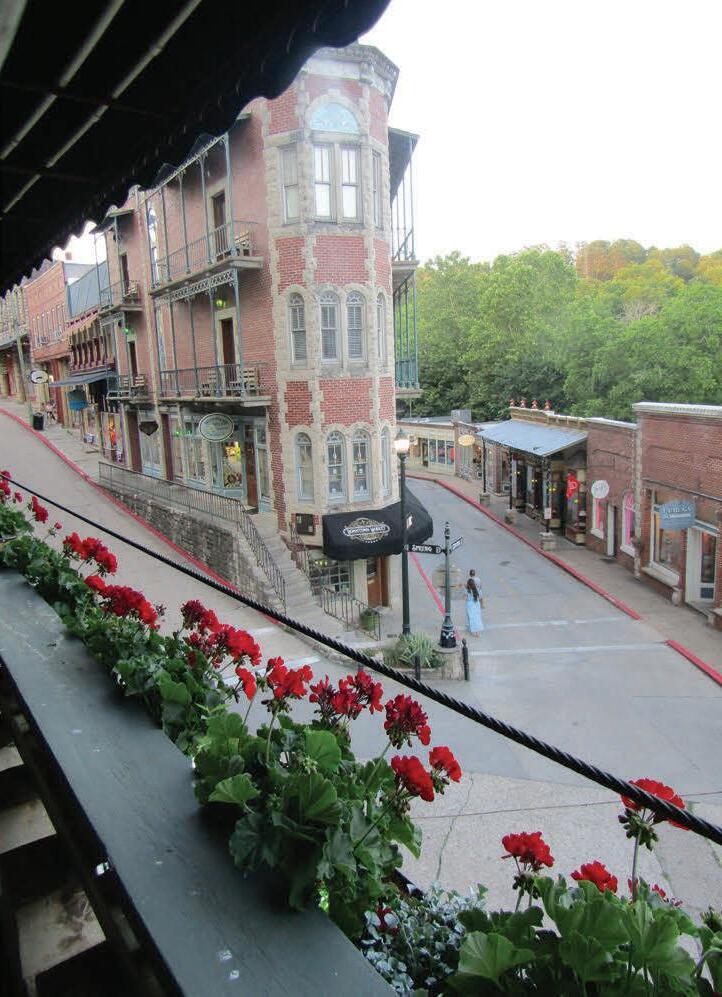
examples: October 5—Corvette Week end, October 21—Ford Galaxie Club of America (I’ll be there in my 1972 LTD convertible), and November 8—Porsche Palooza. Every August, the annual VW bug and van parade is trippy.


The 1886 Crescent Hotel and Spa is a Eureka Springs classic. One of the most haunted hotels in the nation, it’s been featured in more than fifteen national and international paranormal television shows. Guests and non-guests can take popular ghost tours led by period-dressed guides. Among several spirits there is Michael, the Irish stonemason who fell to his death during construction into what became Room 218, where guests report cries of a falling man and hands appear-
ing in the bathroom mirror. Theodora in Room 419 dislikes discord. If you leave belongings in disarray you might find them organized when you return, it is said. One couple who exchanged harsh words in the room returned after a night out to discover their suitcases packed by the door, ready for eviction. They checked out.
The equally historic Basin Park Hotel is in the center of action, where busy, hilly Main, Center, and Spring Streets converge at acute angles by a flatiron building (also a hotel). Many rooms overlook Basin Park. Both the Crescent and the Basin Park have full-service day spas.
Last century’s Joy Motel has been updated to become Wanderoo Lodge with a kitschy, laid-back vibe. The current owner’s great-grandparents opened the place
first in the 1920s.
Sated and spring-water saturated, you have two options returning home. An hour’s drive west is Bentonville with the extraordinary Crystal Bridges Museum of American Art and a vibrant food scene, then home via Interstate 49 South. Or east to Harrison, then south on U.S. 65 through the Arkansas Delta.
Either way, you linger a day or two longer in the lore-filled land of Arkansas. •
visiteurekasprings.com hotsprings.org
Disclaimer: This trip was hosted and partially funded by the Hot Springs and Eureka Springs CVBs though the opinions of the writer are his own and formed independently of this fact.
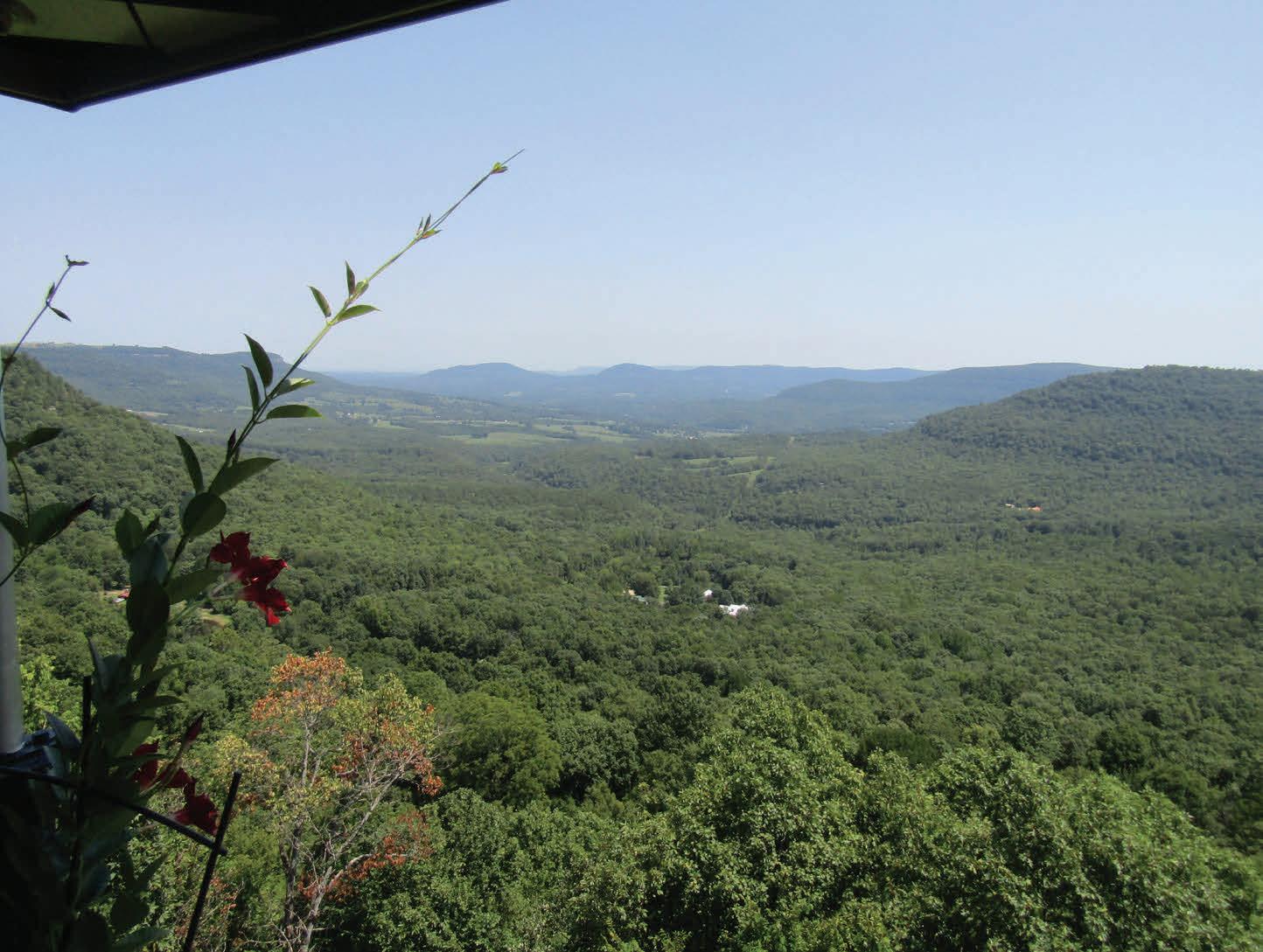




Friday Night Winemaker Dinner featuring Chef Cameron Cage, City Pork, Baton Rouge & Miner Family Vineyards, Napa, CA presented by Didier Consulting

St. Francisville Saturday Night at the Magnolia Cafe featuring Chef Chaz Lindsay, Pulito Osteria, Jackson, MS presented by Visit Mississippi





Sunday Grand Tastings at the Myrtles





Craft Beer and Brats Garden presented by Bank of St. Francisville Spirits at the Myrtles’ Courtyard presented by Paretti Jaguar Land Rover Country Roads People’s Choice Chef Experience presented by Williamson Eye Center City Group Hospitality Tasting Experience
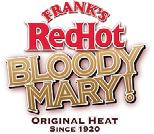


Zero Proof Wellness Bar Presented by Pennington Biomedical Research Center Making Raving Fans Hospitality Group Tasting Experience

2023 Louisiana Seafood King Owen Hohl presented by Louisiana Seafood Promotion & Marketing Board

Louisiana’s Most Beautiful Food & Wine Event Presented





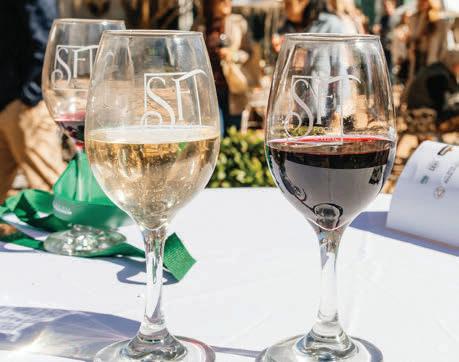

Sponsored by Tangipahoa Parish Tourism
dictated to by being the vessel—she’s the homemaker, the one that produces the child, and often according to society, that’s it,” explains Elliottsmith.
And as for the women themselves—“The women? Well, yeah. I’m a feminist,” she answers with a chuckle. Usually young women, the figures appearing in Elliottsmith’s works are friends, neighbors, and her own daughter—captured during photo sessions conducted by the artist, in which she asks them to pose in one of the various tableaux derived from her scraps of notes.
In her 2023 collection, The Year of the Woman, the collage “Birds on a Wire” presents two of these women—mirror images of each other—facing the center, each holding in her hands a nest—one with eggs, and one with a bird. “We have one pointing to the nest, and the other holding her hand up,” describes Elliottsmith. “This is the one with the bird in it, sort of the child already born. But it’s like, wait a minute, am I now defined by this?”

In the fantastical worlds of artist Leslie Elliottsmith’s digital collages, women kick the moon into the night sky. They worry over nests, encircling their feet and weighing down their hands. They carry a clock— the same one, always, square and stuck at 12:50. The birds are drawn to them, the egrets and the songbirds and the spoonbills alike. Occasionally, wings sprout forth straight from these women’s backs, confusing the otherwise-all-too-clear lines between the human world and the natural one.
The compositions come to Elliottsmith from the depths of her innermost frustrations, which compel her to scribble down fragments of words and ideas onto scraps of paper, preserved in
piles. “You should see my desk,” she tells me. “But that’s how I’ve always worked.”
The sixty-eight-year-old multi-media artist has been cutting and pasting and telling stories through visuals since she was a child, stealing her mother’s kitchen scissors. “I swear, even as an old woman, she would tell me, ‘You always stole my scissors,’” laughs Elliottsmith. From that early age, “it was one thing I just knew. I had no doubt that I wanted to be an artist.”
Across her vast body of work—which includes sculpture, pottery, weaving, furniture-making, painting, and photography—Elliottsmith’s tendency toward the hallucinatory, the whimsical, the ominous carries through, as do the trappings of allegory. “I’ve always done
narrative work,” she says. “I just feel like I have to say something.”
Elliottsmith says that she tries to keep the political concerns that motivate much of her work relatively subtle, but themes of environmental collapse and women’s rights especially color her collections over the past decade, with increasing urgency. A vocabulary of symbols threads through her entire body of work, whispering these underlying messages. Water is everywhere—as easily a force of renewal and change as of destruction, much like fire. The waters and the fires occasionally cradle a boat, a totem of the journey. Birds act as messengers, ever-tied to their nests—which stand in for home and domesticity.
“The nest, the idea that a woman is
A dotted line extends from the nests, wrapping around the two women—“the idea that your path is not your own,” Elliottsmith explains. Both women are enclosed in shapes resembling those of traditional houses, the outlines filled in with rippling, sun-dappled water above and wild grasses below. “They are inside nature, because we are natural beings, and will eventually go back to the earth.”
Above the women, emerging from the darkness of a night signaled by a full moon at the center, a line stretches across the scene—five birds perched upon it. “They represent the balancing act”—women’s daily work of managing society’s expectations against their own understandings of themselves; the virtues of womanhood against the virtues of self. •
See more of Elliottsmith’s work in person at LeMieux Galleries and online at artelliottsmith.com.

